3-aryl-4-amido-bicyclic [4,5,0] hydroxamic acids as HDAC inhibitors
Zheng , et al. Nov
U.S. patent number 10,472,337 [Application Number 16/220,046] was granted by the patent office on 2019-11-12 for 3-aryl-4-amido-bicyclic [4,5,0] hydroxamic acids as hdac inhibitors. This patent grant is currently assigned to FORMA Therapeutics, Inc.. The grantee listed for this patent is FORMA Therapeutics, Inc.. Invention is credited to Bingsong Han, David R. Lancia, Jr., Cuixian Liu, Matthew W. Martin, David S. Millan, Pui Yee Ng, Aleksandra Rudnitskaya, Jennifer R. Thomason, Mary-Margaret Zablocki, Xiaozhang Zheng.



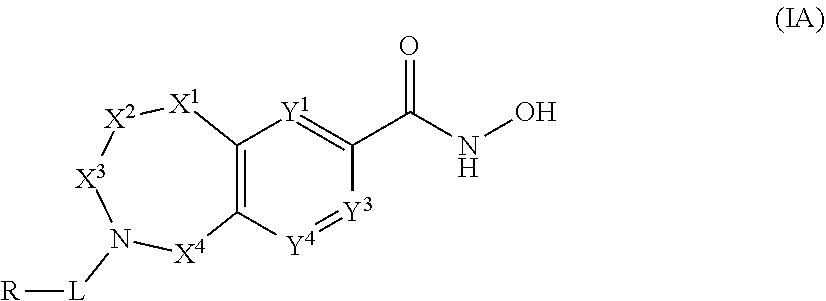

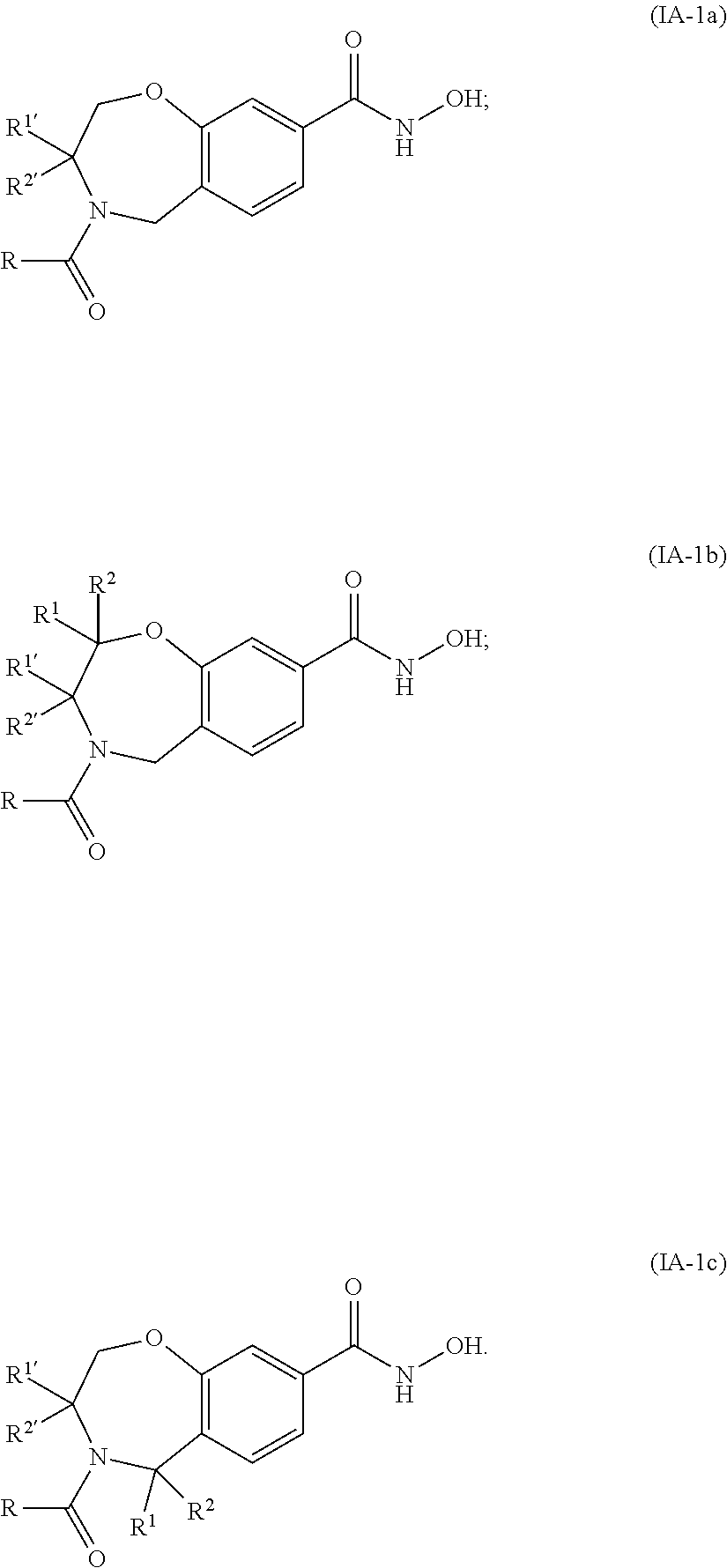
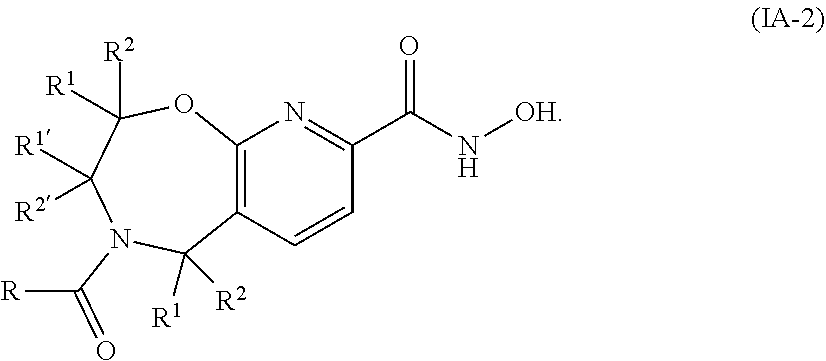

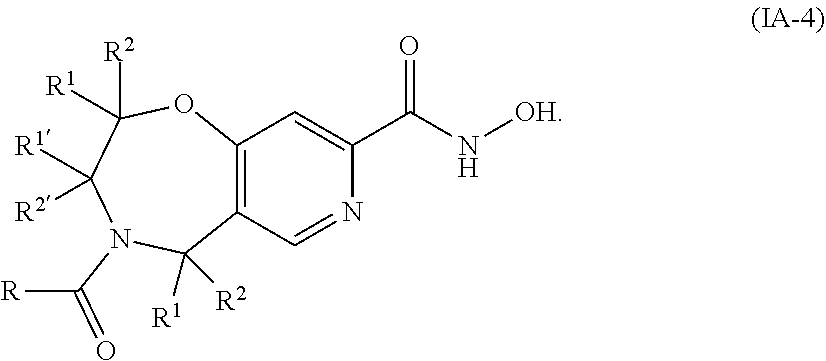
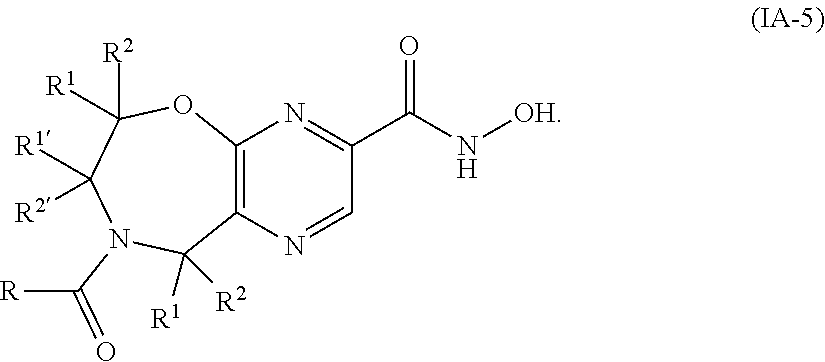
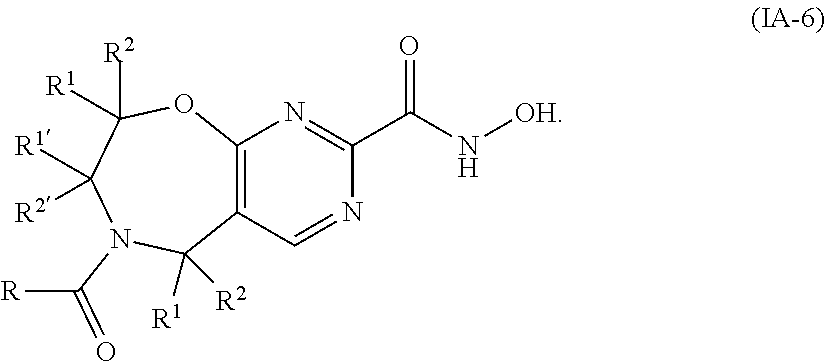
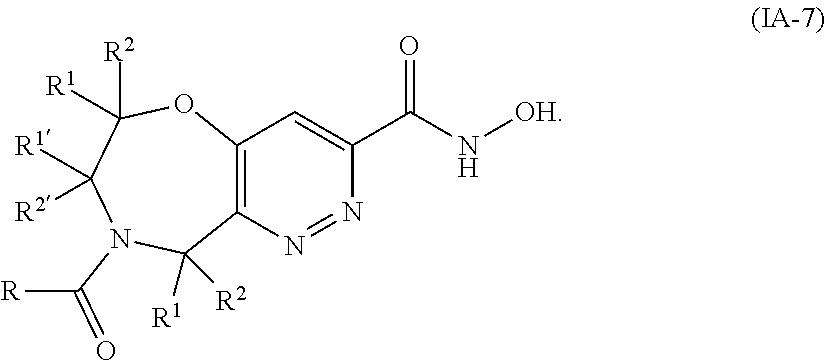
View All Diagrams
| United States Patent | 10,472,337 |
| Zheng , et al. | November 12, 2019 |
3-aryl-4-amido-bicyclic [4,5,0] hydroxamic acids as HDAC inhibitors
Abstract
The present disclosure relates to inhibitors of zinc-dependent histone deacetylases (HDACs) useful in the treatment of diseases or disorders associated with an HDAC, e.g., HDAC6, having a Formula I: ##STR00001## where R, L, X.sup.1, X.sup.2, X.sup.3, X.sup.4, Y.sup.1, Y.sup.2, Y.sup.3, and Y.sup.4 are described herein.
| Inventors: | Zheng; Xiaozhang (Lexington, MA), Ng; Pui Yee (Waltham, MA), Han; Bingsong (Westwood, MA), Thomason; Jennifer R. (Clinton, MA), Zablocki; Mary-Margaret (Revere, MA), Liu; Cuixian (Madison, CT), Rudnitskaya; Aleksandra (Roslindale, MA), Lancia, Jr.; David R. (Boston, MA), Millan; David S. (Watertown, MA), Martin; Matthew W. (Arlington, MA) | ||||||||||
|---|---|---|---|---|---|---|---|---|---|---|---|
| Applicant: |
|
||||||||||
| Assignee: | FORMA Therapeutics, Inc.
(Watertown, MA) |
||||||||||
| Family ID: | 55353351 | ||||||||||
| Appl. No.: | 16/220,046 | ||||||||||
| Filed: | December 14, 2018 |
Prior Publication Data
| Document Identifier | Publication Date | |
|---|---|---|
| US 20190119233 A1 | Apr 25, 2019 | |
Related U.S. Patent Documents
| Application Number | Filing Date | Patent Number | Issue Date | ||
|---|---|---|---|---|---|
| 15013816 | Feb 2, 2016 | ||||
| 62110716 | Feb 2, 2015 | ||||
| 62205438 | Aug 14, 2015 | ||||
| Current U.S. Class: | 1/1 |
| Current CPC Class: | A61P 7/00 (20180101); C07D 405/06 (20130101); C07D 267/14 (20130101); A61P 43/00 (20180101); A61P 1/04 (20180101); A61P 17/06 (20180101); A61P 21/02 (20180101); C07D 413/12 (20130101); A61P 9/00 (20180101); C07D 413/14 (20130101); C07D 495/10 (20130101); A61P 35/02 (20180101); C07D 291/08 (20130101); C07D 401/10 (20130101); C07D 403/06 (20130101); C07D 493/08 (20130101); A61P 25/28 (20180101); A61P 25/00 (20180101); C07D 413/06 (20130101); C07D 498/04 (20130101); C07D 243/14 (20130101); C07D 413/08 (20130101); C07D 491/107 (20130101); C07D 267/12 (20130101); A61P 25/14 (20180101); C07D 401/06 (20130101); C07D 413/04 (20130101); C07D 471/04 (20130101); A61P 35/00 (20180101); C07D 417/04 (20130101); C07D 403/10 (20130101); A61P 31/00 (20180101); A61P 3/00 (20180101); A61P 29/00 (20180101); C07D 498/08 (20130101); A61P 19/02 (20180101); A61P 37/06 (20180101); A61P 19/04 (20180101); A61P 25/16 (20180101); A61P 37/02 (20180101) |
| Current International Class: | A61K 31/5513 (20060101); C07D 267/14 (20060101); C07D 417/06 (20060101); C07D 413/06 (20060101); C07D 403/10 (20060101); C07D 403/06 (20060101); C07D 401/10 (20060101); C07D 401/06 (20060101); C07D 243/14 (20060101); C07D 413/14 (20060101); C07D 417/04 (20060101); C07D 471/04 (20060101); C07D 498/04 (20060101); C07D 498/08 (20060101); C07D 493/08 (20060101); C07D 413/08 (20060101); C07D 491/107 (20060101); C07D 495/10 (20060101); C07D 267/12 (20060101); C07D 413/04 (20060101); C07D 291/08 (20060101); C07D 405/06 (20060101); C07D 413/12 (20060101) |
| Field of Search: | ;514/221 ;540/513 |
References Cited [Referenced By]
U.S. Patent Documents
| 4332802 | June 1982 | Schromm et al. |
| 4861784 | August 1989 | Rauber et al. |
| 5153185 | October 1992 | DiNinno et al. |
| 5244911 | September 1993 | Booher et al. |
| 5294610 | March 1994 | DiNinno et al. |
| 5384317 | January 1995 | DiNinno |
| 5532261 | July 1996 | DiNinno et al. |
| 5612356 | March 1997 | Yoshimura et al. |
| 5714518 | February 1998 | Reich et al. |
| 5719144 | February 1998 | Hartman et al. |
| 5728844 | March 1998 | Muller et al. |
| 5807854 | September 1998 | Bartroli et al. |
| 5863950 | January 1999 | Reich et al. |
| 6001823 | December 1999 | Hultgren et al. |
| 6110913 | August 2000 | Dorwald et al. |
| 6153396 | November 2000 | Hultgren et al. |
| 6180640 | January 2001 | Cuny et al. |
| 6288099 | September 2001 | Antane et al. |
| 6403632 | June 2002 | Duan et al. |
| 6414029 | July 2002 | Shechter et al. |
| 6420127 | July 2002 | Hultgren et al. |
| 6476019 | November 2002 | Radeke et al. |
| 6762177 | July 2004 | Radeke et al. |
| 6787554 | September 2004 | Gaudilliere |
| 6872542 | March 2005 | Hultgren et al. |
| 6916809 | July 2005 | Chen et al. |
| 6962791 | November 2005 | Hultgren et al. |
| 6992077 | January 2006 | Radeke et al. |
| 7199119 | April 2007 | Burkitt et al. |
| 7214690 | May 2007 | Higuchi et al. |
| 7241775 | July 2007 | Hofmeister et al. |
| 7495111 | February 2009 | Ramamoorthy et al. |
| 7582667 | September 2009 | Quagliato et al. |
| 7622582 | November 2009 | Kesteleyn et al. |
| 7704756 | April 2010 | Suich et al. |
| 7705017 | April 2010 | Cummings et al. |
| 7943608 | May 2011 | Schultz et al. |
| 7951795 | May 2011 | Bell et al. |
| 8058427 | November 2011 | Hsieh et al. |
| 8119655 | February 2012 | Dong et al. |
| 8148380 | April 2012 | Guiles et al. |
| 8178553 | May 2012 | Lavey et al. |
| 8198290 | June 2012 | Hodges |
| 8324221 | December 2012 | Banka et al. |
| 8349839 | January 2013 | Sturino et al. |
| 8367709 | February 2013 | Pinto et al. |
| 8426447 | April 2013 | White et al. |
| 8436005 | May 2013 | Liu et al. |
| 8471026 | June 2013 | Blackburn et al. |
| 8513433 | August 2013 | Panicker et al. |
| 8518964 | August 2013 | Truchon et al. |
| 8524732 | September 2013 | Schiemann et al. |
| 8546410 | October 2013 | Liu et al. |
| 8569336 | October 2013 | Tong et al. |
| 8575193 | November 2013 | Maier et al. |
| 8598342 | December 2013 | Kahne et al. |
| 8629272 | January 2014 | Fuchs et al. |
| 8642587 | February 2014 | Lange et al. |
| 8642615 | February 2014 | Wentland |
| 8658641 | February 2014 | Barvian et al. |
| 8673952 | March 2014 | Blaquiere et al. |
| 8685969 | April 2014 | Liu et al. |
| 8686032 | April 2014 | Davidson et al. |
| 8703936 | April 2014 | Jewett et al. |
| 8765773 | July 2014 | England et al. |
| 8765810 | July 2014 | Greene et al. |
| 8778931 | July 2014 | Gould |
| 8785626 | July 2014 | Blaquiere et al. |
| 8815891 | August 2014 | Kim et al. |
| 8822462 | September 2014 | Traynelis et al. |
| 8822488 | September 2014 | Deaver et al. |
| 8871759 | October 2014 | Coburn et al. |
| 9630922 | April 2017 | Ng et al. |
| 9637453 | May 2017 | Ng et al. |
| 10112915 | October 2018 | Zheng et al. |
| 2002/0034774 | March 2002 | Hultgren et al. |
| 2002/0045199 | April 2002 | Hultgren et al. |
| 2003/0171355 | September 2003 | Radeke et al. |
| 2003/0198992 | October 2003 | Hultgren et al. |
| 2003/0208066 | November 2003 | Levin et al. |
| 2004/0249147 | December 2004 | Sattigeri et al. |
| 2005/0038011 | February 2005 | Radeke et al. |
| 2006/0069083 | March 2006 | Steiner et al. |
| 2006/0194785 | August 2006 | Radeke et al. |
| 2006/0239909 | October 2006 | Anderson et al. |
| 2007/0155730 | July 2007 | Leit et al. |
| 2007/0185007 | August 2007 | Jin et al. |
| 2007/0197564 | August 2007 | Lavey et al. |
| 2007/0244154 | October 2007 | Brehm |
| 2007/0265299 | November 2007 | Lavey et al. |
| 2008/0004282 | January 2008 | Vohra et al. |
| 2008/0112889 | May 2008 | Buggy et al. |
| 2008/0113962 | May 2008 | Zimmermann et al. |
| 2008/0194638 | August 2008 | Dedhiya et al. |
| 2008/0255161 | October 2008 | Koltun et al. |
| 2008/0275029 | November 2008 | Berdini et al. |
| 2008/0280855 | November 2008 | Chiesa et al. |
| 2009/0093473 | April 2009 | Zimmermann et al. |
| 2009/0105283 | April 2009 | Koltun et al. |
| 2009/0136449 | May 2009 | Di Filippo et al. |
| 2009/0156586 | June 2009 | Lavey et al. |
| 2009/0221589 | September 2009 | Trieselmann et al. |
| 2009/0325948 | December 2009 | Hurley et al. |
| 2010/0076012 | March 2010 | Schiemann et al. |
| 2010/0120818 | May 2010 | Enderle |
| 2010/0173332 | July 2010 | Smaill et al. |
| 2010/0256082 | October 2010 | Schotzinger |
| 2010/0317678 | December 2010 | Moffat et al. |
| 2011/0039827 | February 2011 | Blackburn et al. |
| 2011/0039840 | February 2011 | Varasi et al. |
| 2011/0071136 | March 2011 | Haddach et al. |
| 2011/0076292 | March 2011 | Blaquiere et al. |
| 2011/0098267 | April 2011 | Babu et al. |
| 2011/0251184 | October 2011 | Blackburn et al. |
| 2011/0275762 | November 2011 | Cmiljanovic et al. |
| 2011/0288117 | November 2011 | Gould et al. |
| 2012/0015942 | January 2012 | Calderwood et al. |
| 2012/0015943 | January 2012 | Blackburn et al. |
| 2012/0083483 | April 2012 | Coburn et al. |
| 2012/0094997 | April 2012 | England et al. |
| 2012/0121502 | May 2012 | van Duzer et al. |
| 2012/0165316 | June 2012 | Gould |
| 2012/0244149 | September 2012 | Blaquiere et al. |
| 2012/0245144 | September 2012 | Heffron et al. |
| 2012/0245193 | September 2012 | Silverman et al. |
| 2012/0258949 | October 2012 | Varasi et al. |
| 2013/0029938 | January 2013 | Aquino et al. |
| 2013/0079331 | March 2013 | Blaquiere et al. |
| 2013/0281402 | October 2013 | Chen et al. |
| 2013/0289027 | October 2013 | De La Rosa et al. |
| 2013/0303567 | November 2013 | Panicker et al. |
| 2014/0018343 | January 2014 | Romero et al. |
| 2014/0018361 | January 2014 | Harriman et al. |
| 2014/0031302 | January 2014 | Winssinger et al. |
| 2014/0031340 | January 2014 | Dineen et al. |
| 2014/0038954 | February 2014 | Epstein et al. |
| 2014/0088101 | March 2014 | Ng et al. |
| 2014/0128371 | May 2014 | Barvian et al. |
| 2014/0194386 | July 2014 | Burns et al. |
| 2014/0239288 | August 2014 | Delcamp et al. |
| 2014/0241990 | August 2014 | Haydon et al. |
| 2014/0288047 | September 2014 | Blaquiere et al. |
| 2014/0296226 | October 2014 | White et al. |
| 2014/0323447 | October 2014 | Kley et al. |
| 2016/0221972 | August 2016 | Zheng et al. |
| 2016/0221973 | August 2016 | Zheng et al. |
| 2016/0221997 | August 2016 | Zheng et al. |
| 2016/0222022 | August 2016 | Zheng et al. |
| 2016/0222028 | August 2016 | Zheng et al. |
| 2016/0304456 | October 2016 | Ng et al. |
| 2016/0304462 | October 2016 | Ng et al. |
| 102558200 | Jul 2012 | CN | |||
| 102838625 | Dec 2012 | CN | |||
| 2110377 | Oct 2009 | EP | |||
| 2503789 | Jan 2014 | GB | |||
| 2000/044562 | Feb 2000 | JP | |||
| 2000/357809 | Dec 2000 | JP | |||
| 2001/226269 | Aug 2001 | JP | |||
| 2004/210716 | Jul 2004 | JP | |||
| 4162106 | Oct 2008 | JP | |||
| 2009/191041 | Aug 2009 | JP | |||
| 2011-148714 | Aug 2011 | JP | |||
| WO-9503699 | Feb 1995 | WO | |||
| WO-9514028 | May 1995 | WO | |||
| WO-9748786 | Dec 1997 | WO | |||
| WO-9901607 | Jan 1999 | WO | |||
| WO-9967238 | Dec 1999 | WO | |||
| WO-2000/034285 | Jun 2000 | WO | |||
| WO-01/12630 | Feb 2001 | WO | |||
| WO-2002/036066 | May 2002 | WO | |||
| WO-2002/042273 | May 2002 | WO | |||
| WO-2003/087059 | Oct 2003 | WO | |||
| WO-2004/017950 | Mar 2004 | WO | |||
| WO-2004/056182 | Jul 2004 | WO | |||
| WO-2004/063156 | Jul 2004 | WO | |||
| WO-2004/111052 | Dec 2004 | WO | |||
| WO-2005/123089 | Dec 2005 | WO | |||
| WO-2006/065842 | Jun 2006 | WO | |||
| WO-2006/083869 | Aug 2006 | WO | |||
| WO-2006/102557 | Sep 2006 | WO | |||
| WO-2006/138549 | Dec 2006 | WO | |||
| WO-2007/022638 | Mar 2007 | WO | |||
| WO-2007/023135 | Mar 2007 | WO | |||
| WO-2007/029035 | Mar 2007 | WO | |||
| WO-2007/061880 | May 2007 | WO | |||
| WO-2007/079826 | Jul 2007 | WO | |||
| WO-2007/084451 | Jul 2007 | WO | |||
| WO-2007/100536 | Sep 2007 | WO | |||
| WO-2007/109178 | Sep 2007 | WO | |||
| WO-2007/143822 | Dec 2007 | WO | |||
| WO-2008/011805 | Jan 2008 | WO | |||
| WO-2008/046155 | Apr 2008 | WO | |||
| WO-2008/048648 | Apr 2008 | WO | |||
| WO-2008/055068 | May 2008 | WO | |||
| WO-2008/060721 | May 2008 | WO | |||
| WO-2008/061160 | May 2008 | WO | |||
| WO-2008/071765 | Jun 2008 | WO | |||
| WO-2008/074858 | Jun 2008 | WO | |||
| WO-2008/091349 | Jul 2008 | WO | |||
| WO-2008/101186 | Aug 2008 | WO | |||
| WO-2009/100045 | Aug 2009 | WO | |||
| WO-2009/123967 | Oct 2009 | WO | |||
| WO-2009127609 | Oct 2009 | WO | |||
| WO-2009/137503 | Nov 2009 | WO | |||
| WO-2010/028192 | Mar 2010 | WO | |||
| WO-2010/042475 | Apr 2010 | WO | |||
| WO-2010/043893 | Apr 2010 | WO | |||
| WO-2010/054278 | May 2010 | WO | |||
| WO-2010/056230 | May 2010 | WO | |||
| WO-2010092181 | Aug 2010 | WO | |||
| WO-2010/111483 | Sep 2010 | WO | |||
| WO-2010/125469 | Nov 2010 | WO | |||
| WO-2010/151317 | Dec 2010 | WO | |||
| WO-2010/151318 | Dec 2010 | WO | |||
| WO-2010/151441 | Dec 2010 | WO | |||
| WO-2011/002520 | Jan 2011 | WO | |||
| WO-2011/011186 | Jan 2011 | WO | |||
| WO-2011/036280 | Mar 2011 | WO | |||
| WO-2011/039353 | Apr 2011 | WO | |||
| WO-2011/045265 | Apr 2011 | WO | |||
| WO-2011/079036 | Jun 2011 | WO | |||
| WO-2011/084991 | Jul 2011 | WO | |||
| WO-2011/088181 | Jul 2011 | WO | |||
| WO-2011/091213 | Jul 2011 | WO | |||
| WO-2011/106627 | Sep 2011 | WO | |||
| WO-2011/106632 | Sep 2011 | WO | |||
| WO-2011/137135 | Nov 2011 | WO | |||
| WO-2011/146591 | Nov 2011 | WO | |||
| WO-2012/016081 | Feb 2012 | WO | |||
| WO-2012/027564 | Mar 2012 | WO | |||
| WO-2012/031993 | Mar 2012 | WO | |||
| WO-2012/045194 | Apr 2012 | WO | |||
| WO-2012/045804 | Apr 2012 | WO | |||
| WO-2012/054332 | Apr 2012 | WO | |||
| WO-2012/085003 | Jun 2012 | WO | |||
| WO-2012/088015 | Jun 2012 | WO | |||
| WO-2012/106343 | Aug 2012 | WO | |||
| WO-2012/110860 | Aug 2012 | WO | |||
| WO-2012/117421 | Sep 2012 | WO | |||
| WO-2012/126901 | Sep 2012 | WO | |||
| WO-2012/178208 | Dec 2012 | WO | |||
| WO-2013/006408 | Jan 2013 | WO | |||
| WO-2013/008162 | Jan 2013 | WO | |||
| WO-2013/009827 | Jan 2013 | WO | |||
| WO-2013/013113 | Jan 2013 | WO | |||
| WO-2013/033085 | Mar 2013 | WO | |||
| WO-2013/052110 | Apr 2013 | WO | |||
| WO-2013/059582 | Apr 2013 | WO | |||
| WO-2013/090210 | Jun 2013 | WO | |||
| WO-2013/134467 | Sep 2013 | WO | |||
| WO-2014/011753 | Jan 2014 | WO | |||
| WO-2014/018919 | Jan 2014 | WO | |||
| WO-2014/037342 | Mar 2014 | WO | |||
| WO-2014/048945 | Apr 2014 | WO | |||
| WO-2014/110442 | Jul 2014 | WO | |||
| WO-2014/127881 | Aug 2014 | WO | |||
| WO-2014/134127 | Sep 2014 | WO | |||
| WO-2014/178606 | Nov 2014 | WO | |||
| WO-2015/054474 | Apr 2015 | WO | |||
| WO-2015/137750 | Sep 2015 | WO | |||
| WO-2016/126721 | Aug 2016 | WO | |||
| WO-2016/126722 | Aug 2016 | WO | |||
| WO-2016/126724 | Aug 2016 | WO | |||
| WO-2016/126725 | Aug 2016 | WO | |||
| WO-2016/126726 | Aug 2016 | WO | |||
| WO-2016/168598 | Oct 2016 | WO | |||
| WO-2016/168660 | Oct 2016 | WO | |||
| WO-2017/065473 | Apr 2017 | WO | |||
| WO-2017/218950 | Dec 2017 | WO | |||
Other References
|
US. Appl. No. 16/218,108, Zheng et al. cited by applicant . U.S. Appl. No. 16/218,114, Zheng et al. cited by applicant . U.S. Appl. No. 16/218,122, Zheng et al. cited by applicant . U.S. Appl. No. 16/218,126, Zheng et al. cited by applicant . U.S. Appl. No. 16/218,132, Zheng et al. cited by applicant . U.S. Appl. No. 16/219,381, Zheng et al. cited by applicant . U.S. Appl. No. 16/219,592, Zheng et al. cited by applicant . U.S. Appl. No. 16/219,648, Zheng et al. cited by applicant . U.S. Appl. No. 16/219,669, Zheng et al. cited by applicant . U.S. Appl. No. 16/219,685, Zheng et al. cited by applicant . U.S. Appl. No. 16/220,035, Zheng et al. cited by applicant . U.S. Appl. No. 16/220,041, Zheng et al. cited by applicant . U.S. Appl. No. 16/220,049, Zheng et al. cited by applicant . U.S. Appl. No. 16/222,868, Zheng et al. cited by applicant . U.S. Appl. No. 16/222,871, Zheng et al. cited by applicant . U.S. Appl. No. 16/133,918, Zheng et al. cited by applicant . U.S. Appl. No. 16/133,922, Zheng et al. cited by applicant . U.S. Appl. No. 16/173,871, Zheng et al. cited by applicant . Aldana-Masangkay, G.I. and Sakamoto, K.M. The Role of HDAC6 in Cancer, J. Biomed. Biotechnol., 875824: 1-10 (2011). cited by applicant . Amengual. J.E. et al, Dual Targeting of Protein Degradation Pathways with the Selective HDAC6 Inhibitor ACY-1215 and Bortezomib Is Synergistic in Lymphoma, Clin Cancer Res., 21(20):4663-75 (2015). cited by applicant . Bantscheff, M. et al., Chemoproteomics profiling of HDAC inhibitors reveal selective targeting of HDAC complexes, Nature Biotechnology, 29(3):255-265 (2011). Online Methods appended. cited by applicant . Bazzaro M. et al, Ubiquitin Proteasome System Stress Underlies Synergistic Killing of Ovarian Cancer Cells by Bortezomib and a Novel HDAC6 Inhibitor, Clin. Cancer Res., 14(22):7340-7347 (2008). cited by applicant . Benedetti R, Conte M, Altucci L. "Targeting Histone Deacetylases in Diseases: Where Are We?" Antioxidants & Redox Signaling, 23(1), pp. 99-126, 2015. cited by applicant . Bergman, J.A. et al., Selective histone deacetylase 6 inhibitors bearing substituted urea linkers inhibit melanoma cell growth, J. Med. Chem., 55:9891-9899 (2012). cited by applicant . Blackburm, C. et al., Potent Histone Deacetylase Inhibitors Derived from 4-(Aminomethyl)-N-hydroxybenzamide with High Selectivity for the HDAC6 Isoform, J Medicinal Chemistry, 56(18):7201-7211 (2013). cited by applicant . Blackburn, C. et al., Histone deacetylase inhibitors derived from1,2,3,4-tetrahydropyrrolo[1,2-a]pyrazine and related heterocycles selective for the HDAC6 isoform, Bioorg Med Chem Lett., 24(23):5450-5454 (2014). cited by applicant . Bone, E.A. et al., Design and Development of HDAC6-Selective Inhibitors for Hematological Cancer Treatment and Solid Tumor Immunotherapy, Karus Therapeutics, Poster session presented at the AACR Annual Meeting, Philadelphia, PA, 1 page (2015). Abstract 3662. cited by applicant . Bradner, J.E. et al., Chemical phylogenetics of histone deacetylases, Nature Chemical Biology, 6:238-243 (2010). Supplemental Information appended, 26 pages. cited by applicant . Butler, K.V. and Kozikowski, A.P., Chemical Origins of Isoform Selectivity in Histone Deacetylase Inhibitors, Current Pharmaceutical Design, 14:505-528 (2008). cited by applicant . Butler, K.V. et al., Rational Design and Simple Chemistry Yield a Superior Neuroprotective HDAC6 Inhibitor, Tubastatin A, J. Am. Chem. Soc., 132:10842-10846 (2010). cited by applicant . Cancer, MedlinePlus, 10 pages. URL: http://www.nlm.nih.gov/medlineplus/cancer.html. [Retrieved Jul. 6, 2007]. cited by applicant . Canet, E. and Touchon, P., Servier: Looking to the Future--Innovation-Driven Partnerships. Medicographia 120, vol. 36(3):267-429 (2014). cited by applicant . Cha, T.L. et al, Dual degradation of aurora A and B kinases by the histone deacetylase inhibitor LBH589 induces G2-M arrest and apoptosis of renal cancer cells, Clin. Cancer Res., 15(3): 840-850 (2009). cited by applicant . Choi, E. et al., Property-Based Optimization of Hydrozamate-Based .gamma.-Lactam HDAC Inhibitors to Improve Their Metabolic Stability and Pharmacokinetic, J. Med. Chem., 55:10766-10770 (2012). cited by applicant . Choi, S.Y. et al, Tubastatin A suppresses renal fibrosis via regulation of epigenetic histone modification and Smad3-dependent fibrotic genes, Vascul. Pharmacol., 72:130-140 (2015). cited by applicant . Choi, Y., Anti-Multiple Myeloma Activity of a Novel HDAC6 Inhibitor, DC-004, in Combination with Proteosomal Inhibitors, CKD Pharmaceutical Corporation, Presentation at the DOT Meeting, 26 pages, Sep. 24, 2015. cited by applicant . Chuang, M.J. et al., The HDAC Inhibitor LBH589 Induces ERK-Dependent Prometaphase Arrest in Prostate Cancer via HDAC6 Inactivation and Down-Regulation, PLOS One, 8(9):e73401 (2013). cited by applicant . D'ydewalle, C. et al., HDAC6 inhibitors reverse axonal loss in a mouse model of mutant HSPB1-induced Charcot-Marie-Tooth disease, Nature Medicine, 8(17):968-974 (2011). Online Methods appended, 1 page. cited by applicant . Dallavalle S, Pisano C, Zunino F. "Development and therapeutic impact of HDAC6-selective inhibitors",Biochemical Pharmacology, Sep. 15, 2012; 84(6):756-65. cited by applicant . De Ruijter, A.J. et al, Histone deacetylases (HDACs): characterization of the classical HDAC family, Biochem. J., 370: 737-749 (2003). cited by applicant . Dhakal, B.K. and Mulve, M.A., Uropathogenic Escherichia coli invades host cells via an HDAC6-modulated microtubule-dependent pathway, J. Biol. Chem., 284(1):446-454 (2008). cited by applicant . Di Micco, S. et al., Structural basis for the design and synthesis of selective HDAC inhibitors, Bioorganic & Medicinal Chemistry, 21:3795-3807 (2013). cited by applicant . Ding, G. et al, HDAC6 promotes hepatocellular carcinoma progression by inhibiting P53 transcriptional activity, FEBS Lett., 587:880-6 (2013). cited by applicant . Ding, N. et al, Histone deacetylase 6 activity is critical for the metastasis of Burkitt's lymphoma cells, Cancer Cell Int., 14:139 (2014). cited by applicant . Falkenberg, K.J. and Johnstone, R.W., Histone deacetylases and their inhibitors in cancer, neurological diseases and immune disorders, Nature Reviews, 13:673-691 (2014). cited by applicant . Feng, T. et al., Novel N-hydrozyfurylacrylamide-based histone deacetylase (HDAC) inhibitors with branched CAP group (Part 2), Bioorg. Med. Chem., 21(17):5339-5354 (2013). cited by applicant . Fiskus, W. et al, Molecular and biologic characterization and drug sensitivity of pan-histone deacetylase inhibitor-resistant acute myeloid leukemia cells, Blood, 112(7):2896-2905 (2008). cited by applicant . Golub et al., Molecular Classification of Cancer: Class Discovery and Class Prediction by Gene Expression Monitoring, Science (1999), vol. 286, 531-537. cited by applicant . Gupta, P. et al., Towards Isozyme-Selective HDAC Inhibitors For Interrogating Disease, Current Topics in Medicinal Chemistry, 12:1479-1499 (2012). cited by applicant . Haakenson, J. and Zhang, X., HDAC6 and Ovarian Cancer, Int. J. Mol. Sci., 14:9514-9535 (2013). cited by applicant . Hadley, M. et al., In Vivo Evaluation of Ames Negative HDAC6 Inhibitor in Melanoma Model. The George Washington Cancer Center. AACR Annual Meeting, Presentation Poster (2017). cited by applicant . Hahnen, E. et al., Histone deacetylase inhibitors: possible implications for neurodegenerative disorders, Expert Opin. Investig. Drugs, 17(2):1-16 (2008). cited by applicant . Hajiagha Bozorgi, A. et al., A structure-activity relationship survey of histone deacetylase (HDAC) inhibitors, Chemometrics and Intelligent Laboratory Systems, 125:132-138 (2013). cited by applicant . Hanessian, S. et al., Vorinostat-Like Molecules as Structural, Stereochemical, and Pharmacological Tools, ACS Med. Chem. Lett., 1:70-74 (2010). cited by applicant . Hideshima, T. et al, Small-molecule inhibition of proteasome and aggresome function induces synergistic antitumor activity in multiple myelomaProc. Natl. Acad. Sci. USA, 102(24):8567-8572 (2005). cited by applicant . Holson, E., Design of inter-class selective inhibitors and discovery of endogenous "HDAC" substrates, The Stanley Center for Psychiatric Research, The Board Institute of Harvard and MIT, Presentation at the DOT Meeting in Boston, 44 pages, Oct. 7, 2014. cited by applicant . Inks, E.S. et al., A Novel Class of Small Molecule Inhibitors of HDAC6, ACS Chem. Biol., 7:331-339 (2012). cited by applicant . International Search Report for PCT/US2016/016194, 4 pages (dated Mar. 23, 2016). cited by applicant . International Search Report for PCT/US2016/016197, 4 pages (dated Mar. 22, 2016). cited by applicant . International Search Report for PCT/US2016/016200, 4 pages (dated Mar. 22, 2016). cited by applicant . International Search Report for PCT/US2016/016201, 4 pages (dated Apr. 20, 2016). cited by applicant . International Search Report for PCT/US2016/016204, 4 pages (dated Mar. 22, 2016). cited by applicant . International Search Report for PCT/US2016/027755, 8 pages (dated Aug. 23, 2016). cited by applicant . International Search Report for PCT/US2016/027842, 8 pages (dated Aug. 12, 2016). cited by applicant . International Search Report for PCT/US2017/037970, 5 pages (dated Aug. 9, 2017). cited by applicant . Itoh, Y. et al., Design, Synthesis, Structure--Selectivity Relationship, and Effect on Human Cancer Cells of a Novel Series of Histone Deacetylase 6-Selective Inhibitors, J. Med. Chem., 50:5425-5438 (2007). cited by applicant . Jochems, J. et al., Antidepressant-Like Properties of Novel HDAC6-Selective Inhibitors with Improved Brain Bioavailability, Neuropsychopharmacology, 39:389-400 (2014). cited by applicant . Kalin JH, Bergman JA. "Development and therapeutic implications of selective histone deacetylase 6 inhibitors", J Med Chem. Aug. 22, 2013; 56(16):6297-313. cited by applicant . Kalin, J.H. et al, Second-generation histone deacetylase 6 inhibitors enhance the immunosuppressive effects of Foxp3+ T-regulatory cells, J. Med. Chem., 55:639-651 (2012). cited by applicant . Kaliszczak, M. et al., A novel small molecule hydroxamate preferentially inhibits HDAC6 activity and tumour growth, British Journal of Cancer, 108:342-350 (2013). cited by applicant . Kamemura, K. et al, Effects of downregulated HDAC6 expression on the proliferation of lung cancer cells, Biochem. Biophys. Res. Commun., 374(1):84-89 (2008). cited by applicant . Kanno, K. et al, Overexpression of histone deacetylase 6 contributes to accelerated migration and invasion activity of hepatocellular carcinoma cells, Oncol. Rep., 28: 867-73 (2012). cited by applicant . Katharaj, E. and Jayaraman, R., Histone Deacetylase Inhibitors as Therapeutics Agents for Cancer Therapy: Drug Metabolism and Pharmacokinetic Propoerties, Drug Development--A Case Study Based Insight into Modern Strategies, InTech, 21 pages. (2011). cited by applicant . Kee, H.J. et al., HDAC Inhibition Suppresses Cardiac Hypertrophy and Fibrosis in DOCA-Salt Hypertensive Rats via Regulation of HDAC6/HDAC8 Enzyme Activity, 37(4-5):229-239 (2013). cited by applicant . Kim, H.J. and Bae, S.C., Histone deacetylase inhibitors: molecular mechanisms of action and clinical trials as anti-cancer drugs, Am J Transl Res, 3(2):166-179 (2011). cited by applicant . Kim, J. et al., A Novel Regulatory Role of HDAC6 in the Functional Inflammatory Phenotype of Glia cells. The George Washington University Cancer Center. AACR Annual Meeting, Presentation Poster (2017). cited by applicant . Kim, Y.H. et al., A phase 1b Study in Cutaneous T-cell lymphoma (CTCL) with the novel topically applied skin-restricted histone deacetylase inhibitor (HDAC-i) SHP-141. Journal of Clinical Oncology 32:15_suppl, 8525-8525 (2014). cited by applicant . Konsoula, Z. et al., Pharmacokinetics-pharmacodynamics and antitumor activity of mercaptoacetamide-based histone deacetylase inhibitors, Mol Cancer Ther, 8(10):2844-2851 (2009). cited by applicant . Kozikowski, A.P. et al., Use of the Nitrile Oxide Cycloaddition (NOC) Reaction for Molecular Probe Generation: A New Class of Enzyme Selective Histone Deacetylase Inhibitors (HDACIs) Showing Picomolar Activity of HDAC6, J. Med. Chem., 51:4370-4373 (2008). cited by applicant . Kozikowski, A.P., Chemistry, the Brain, and Cancer--Ups and Downs on the Road to HDAC Drugs, Department of Medicinal Chemistry and Pharmacognosy, University of Illinois at Chicago, 61 pages. 2017. cited by applicant . Kroesen, K. et al., HDAC inhibitors and immunotherapy; a double edged sword?, Oncotarget, 5(16):6558-6572 (2014). cited by applicant . Krukowski, K. et al., Abstract 1612: An HDAC6 inhibitor for treatment of chemoterapy-induced peripheral numbness and pain in a mouse model, Abstracts/Brain, Behavior, and Immunity, 49:e28 (2015). cited by applicant . Kwon, S.H., Selective Inhibition of HDAC6 regulates preferential cytotoxicity in cancer cells by modulating p53 and Hsp90 stability, American Association for Cancer Research Annual Meeting, Philadelphia, Abstract 5324, 16 pages (Apr. 22, 2015). cited by applicant . Lai, M.J. et al., Synthesis and Biological Evaluation of 1-Arylsulfonyl-5-(N-hydroxyacrylamide)indoles as Potent Histone Deacetylase Inhibitors with Antitumor Activity in Vivo, J. Med. Chem., 55:3777-3791 (2012). cited by applicant . Lala et al., Role of nitric oxide in tumor progression: Lessons from experimental tumors, Cancer and Metastasis Reviews (1998), 17, 91-106. cited by applicant . Lee, J. and Huang, S.R., Cancer Epigenetics: Mechanisms and Crosstalk of HDAC Inhibitor, Vorinostat, Chemotherapy, 2(1):1000111 (2013). cited by applicant . Lee, J.H. et al., Anti-Multiple Myeloma Activity of a Novel HDAC6 Inhibitor, DC-004, in Combination with Proteosomal Inhibitors. CKD Research Institute (2015). cited by applicant . Lee, J.H. et al., Development of a histone deacetylase 6 inhibitor and its biological effects, PNAS Early Edition, 110(39):15704-15709 (2013). cited by applicant . Lee, Y-S. et al, The cytoplasmic deacetylase HDAC6 is required for efficient oncogenic tumorigenesisCancer Res., 68(18):7561-7569 (2008). cited by applicant . Li, Y. et al, Histone deacetylase 6 plays a role as a distinct regulator of diverse cellular processes, FEBS J., 280: 775-93 (2013). cited by applicant . Lim, H. et al., CKD-M134, a Novel HDAC6 Inhibitor, Ameliorates Experimental Colitis Models in Mice. CKD Research Institute, Presentation Poster, 1 page (Sep. 25, 2015). cited by applicant . Lin, X. et al., Design and Synthesis of Orally Bioavailable Aminopyrrolidinone Histone Deacetylase 6 Inhibitors, J. Med. Chem., 58:2809-2820 (2015). cited by applicant . Marek, L. et al., Histone Deacetylase (HDAC) Inhibitors with a Novel Connecting Unit Linker Region Reveal a Selectivity Profile for HDAC4 and HDAC5 with Improved Activity against Chemoresistant Cancer Cells, J. Med. Chem., 56(2):427-436 (2013). cited by applicant . Mishima, Y. et al., Ricolinostat (ACY-1215) induced inhibition of aggresome formation accelerates carfilzomib-induced multiple myeloma cell death, British Journal of Haematology, 169(9):423-434 (2015). cited by applicant . Molina, A. et al., Identification of ACY-1083: a Novel, Potent, and Highly Selective HDAC6 Inhibitor, Acetylon Pharmaceuticals, Inc., Poster presentation, 1 page, 2016. cited by applicant . Mottamal, M. et al., Histone Deacetylase Inhibitors in Clinical Studies as Templates for New Anticancer Agents, Molecules, 20:3898-3941 (2015). cited by applicant . Nawrocki, S.T. et al, Aggresome disruption: a novel strategy to enhance bortezomib-induced apoptosis in pancreatic cancer cells, Cancer Res., 66(7):3773-3781 (2006). cited by applicant . New, M. et al., HDAC inhibitor-based therapies: Can we interpret the code?, Molecular Oncology, 6:637-656 (2012). cited by applicant . Olson, D.E. et al., Discovery of the First Histone Deacetylase 6/8 Dual Inhibitors, J. Med. Chem., 56:4816-4820 (2013). cited by applicant . Park, S.Y. et al, Histone deacetylases 1, 6 and 8 are critical for invasion in breast cancer, Oncol. Rep. 2011, 25: 1677-1681 (2011). cited by applicant . Quartararo, C.E. et al., High-Throughput Screening of Patient-Derived Cultures Reveals Potential for Precision Medicine in Glioblastoma, ASC Med. Chem. Lett., 6:948-952 (2015). cited by applicant . Quayle, S.N. et al., Selective HDAC Inhibition by Ricolinostat (ACY-1215) or ACY-241 Synergizes with IMiD.RTM. Immunomodulatory Drugs in Multiple Myeloma (MM) and Mantle Cell Lymphoma (MCL) Cells, Acetylon Pharmaceuticals, Inc., AACR Poster Presentation in Boston, MA, 1 page (2015). cited by applicant . Raje, N. et al., Ricolinostat plus Lenalidomide and Dexamethasone in Patients with Relapsed & Refractory Multiple Myeloma: Phase 1B & Early Phase 2 Results, Acetylon Pharamceuticals Inc, Poster Presentation (2015). cited by applicant . Rey, M. et al, HDAC6 is required for invadopodia activity and invasion by breast tumor cells, Eur. J. Cell Biol., 90: 128-135 (2011). cited by applicant . Rivieccio, M.A. et al, HDAC6 is a target for protection and regeneration following injury in the nervous system, Proc. Natl. Acad. Sci. USA, 106(46):19599-195604 (2009). cited by applicant . Rodriguez-Gonzalez, R. et al, Multiple system organ response induced by hyperoxia in a clinically relevant animal model of sepsis, Blood 2008, 1 12(1 1): Abstract 1923 (2008). cited by applicant . Seidel, C. et al, 4-Hydroxybenzoic acid derivatives as HDAC6-specific inhibitors modulating microtubular structure and HSP90a chaperone activity against prostate cancer, Biochem. Pharmacol., 99: 31-52 (2016). cited by applicant . Seki, H. et al., Synthesis/biological evaluation of hydrozamic acids and their prodrugs as inhibitors for Botulinum neurotoxin A light chain, Bioorganic & Medicinal Chemistry, 22:1208-1217 (2014). cited by applicant . Shen, S. et al., Bicyclic-Capped Histone Deacetylase 6 Inhibitors with Improved Activity in a Model of Axonal Charcot-Marie-Tooth Disease, ACS Chem Neurosci., 7(2):240-258 (2016). cited by applicant . Shon, S. et al., Abstract 1448: Therapeutic Role of a Novel Histone Deacetylase 6 Inhibitor, CKD-M808, in Rheumatoid Arthritis, ACR/ARHP Annual Meeting, 2 pages (2016). Accessed May 25, 2018. <http://acrabstracts.org/abstract/therapeutic-role-of-a-novel-histone-- deacetylase-6-inhibitor-ckd-m808-in-rheumatoid-arthritis/>. cited by applicant . Simoes-Pires, C. et al, HDAC6 as a target for neurodegenerative diseases: what makes it different from the other HDACs?, Mol. Neurodegener., 8: 7 (2013). cited by applicant . Suzuki, T. et al., Highly Potent and Selective Histone Deacetylase 6 Inhibitors Designed Based on a Small-Molecular Substrate, J. Med. Chem., 49:4809-4812 (2006). cited by applicant . Tang J, Yan H, Zhuang S. "Histone deacetylases as targets for treatment of multiple diseases", Clinical Science (Lond), Jun. 2013; 124(11):651-62. cited by applicant . Tang, G. et al., Identification of a Novel Aminotetralin Class of HDAC6 and HDAC8 Selective Inhibitors, J. Med. Chem., 57(19):8026-8034 (2014). cited by applicant . Tannous, P. et al, Intracellular protein aggregation is a proximal trigger of cardiomyocyte autophagy, Circulation, 117(24):3070-3078 (2008). cited by applicant . Tapadar, S. et al., Isoxazole moiety in the linker region of HDAC inhibitors adjacent to the Zn-chelating group: Effects on HDAC biology and antiproliferative activity, Bioorganic & Medicinal Chemistry Letters, 19:3023-3026 (2009). cited by applicant . Thaler, F. et al., Current trends in the development of histone deacetylase inhibitors: a review of recent patent applications, Pharm. Pat. Analyst, 1(1):75-90 (2012). cited by applicant . Thangapandian, S. et al., Molecular Modeling Study on Tunnel Behavior in Different Histone Deacetylase Isoforms, PLOS One, 7(11):e49327 (2012). cited by applicant . Valente, S. and Mai, A., Small-molecule inhibitors of histone deacetylase for the treatment of cancer and non-cancer diseases: a patent review (2011-2013), Expert Opin. Ther. Patents, 24(4):401-415 (2014). cited by applicant . Van Helleputte, L. et al., The role of histone deacetylase 6 (HDAC6) in neurodegeneration, Research and Reports in Biology, 5:1-13 (2014). cited by applicant . Varasi, M. et al., Discovery, Synthesis, and Pharmacological Evaluation of Spiropiperidine Hydroxamic Acid Based Derivatives as Structurally Novel Histone Deacetylase (HDAC) Inhibitors, Journal of Medicinal Chemistry, 54(8): 3051-3064 (2011). cited by applicant . Vishwakarma, S. et al, Tubastatin, a selective histone deacetylase 6 inhibitor shows anti-inflammatory and anti-rheumatic effects, Int. Immunopharmacol., 16:72-78 (2013). cited by applicant . Wagner, F.F. et al., Potent and Selective Inhibition of Histone Deacetylase 6 (HDAC6) Does Not Require a Surface-Binding Motif, J. Med. Chem., 56:1772-1776 (2013). cited by applicant . Wagner, F.F. et al., Small Molecule Inhibitors of Zinc-dependent Histone Deacetylases, Neurotherapeutics, 10(4):589-604 (2013). cited by applicant . Wang, L. et al, Immunomodulatory effects of deacetylase inhibitors: therapeutic targeting of FOXP3+ regulatory T cellsNat. Rev. Drug Disc. 2009 8(12):969-981. cited by applicant . Wang, Z. et al., HDAC6 promotes cell proliferation and confers resistance to temozolomide in glioblastoma. Cancer Letters 379:134-142 (2016). cited by applicant . West AC, Johnstone RW, "New and emerging HDAC inhibitors for cancer treatment", Journal of Clinical Investigation, Jan. 2, 2014; 124(1):30-9. cited by applicant . Wu, D. et al., Screening of selective histone deacetylase inhibitors by proteochemometric modeling, BMC Bioinformatics, 13:212 (2012). cited by applicant . Yang, M.H. et al., HDAC6 and SIRT2 regulate the acetylation state and oncogenic activity of mutant K-RAS, Mol Cancer Res, 11(9):1072-1077 (2013). cited by applicant . Yu, C.W. et al., Quinazolin-4-one Derivatives as Selective Histone Deacetylase-6 Inhibitors for the Treatment of Alzheimer's Disease, J. Med. Chem., 56(17):6775-6791 (2013). cited by applicant . Zhang, L. et al, Proteomic identification and functional characterization of MYH9, Hsc70, and DNAJA1 as novel substrates of HDAC6 deacetylase activity, Protein Cell., 6(1): 42-54 (2015). cited by applicant . Zhang, Y. et al., Discovery of a Tetrahydroisoquinoline-Based Hydroxamic Acid Derivative (ZYJ-34c) as Histone Deacetylase Inhibitor with Potent Oral Antitumor Activities, J. Med. Chem., 54:5532-5539 (2011). cited by applicant . Zhang, Y. et al., Two Catalytic Domains Are Required for Protein Deacetylation, The Journal of Biological Chemistry, 281(5):2401-2404 (2006). cited by applicant. |
Primary Examiner: Coleman; Brenda L
Attorney, Agent or Firm: Choate, Hall & Stewart LLP Shinall; Michael A. D'Amato; Erica M.
Parent Case Text
CROSS-REFERENCE TO RELATED APPLICATIONS
This application is a divisional of U.S. Non-Provisional application Ser. No. 15/013,816, filed Feb. 2, 2016, which claims the benefit of priority of U.S. Provisional Application No. 62/110,716, filed Feb. 2, 2015 and U.S. Provisional Application No. 62/205,438, filed Aug. 14, 2015, each of which is incorporated herein by reference.
Claims
The invention claimed is:
1. A compound of Formula I: ##STR00115## or a pharmaceutically acceptable salt, thereof, wherein: X.sup.1 is NR.sup.3; X.sup.2 is C.dbd.O, and X.sup.4 is CR.sup.1R.sup.2; X.sup.3 is CR.sup.1'R.sup.2'; Y.sup.1 and Y.sup.4 are not bonded to --C(O)NHOH and are each CR.sup.1; Y.sup.2 and Y.sup.3 are each CR.sup.1 when not bonded to --C(O)NHOH, and Y.sup.2 and Y.sup.3 are C when bonded to --C(O)NHOH; L is selected from the group consisting of --C(O)--, --C(O)(CR.sup.1R.sup.2).sub.m--, and --C(O)(CR.sup.1R.sup.2).sub.mO--, wherein L is bound to the ring nitrogen through the carbonyl group; R is independently, and at each occurrence, selected from the group consisting of --H, --C.sub.1-C.sub.6 alkyl, --C.sub.2-C.sub.6 alkenyl, --C.sub.4-C.sub.8 cycloalkenyl, --C.sub.2-C.sub.6 alkynyl, --C.sub.3-C.sub.8 cycloalkyl, --C.sub.5-C.sub.12 spirocyclyl, heterocyclyl, spiroheterocyclyl, aryl, and heteroaryl containing 1 to 5 heteroatoms selected from the group consisting of N, S, P, and O, wherein each alkyl, alkenyl, cycloalkenyl, alkynyl, cycloalkyl, spirocyclyl, heterocyclyl, spiroheterocyclyl, aryl, or heteroaryl is optionally substituted with one or more substituents selected from the group consisting of --OH, halogen, oxo, --NO.sub.2, --CN, --R.sup.1, --R.sup.2, --OR.sup.3, --NHR.sup.3, --NR.sup.3R.sup.4, --S(O).sub.2NR.sup.3R.sup.4, --S(O).sub.2R.sup.1, --C(O)R.sup.1, --CO.sub.2R.sup.1, --NR.sup.3S(O).sub.2R.sup.1, --S(O)R.sup.1, --S(O)NR.sup.3R.sup.4, --NR.sup.3S(O)R.sup.1, heterocyclyl, aryl, and heteroaryl containing 1 to 5 heteroatoms selected from the group consisting of N, S, P, and O, with the proviso that R is not bound to L via a nitrogen atom; each R.sup.1 and R.sup.2 are independently, at each occurrence, selected from the group consisting of --H, --R.sup.3, --R.sup.4, --C.sub.1-C.sub.6 alkyl, --C.sub.2-C.sub.6 alkenyl, --C.sub.4-C.sub.8 cycloalkenyl, --C.sub.2-C.sub.6 alkynyl, --C.sub.3-C.sub.8 cycloalkyl, heterocyclyl, aryl, heteroaryl containing 1 to 5 heteroatoms selected from the group consisting of N, S, P, and O, --OH, halogen, --NO.sub.2, --CN, --NHC.sub.1-C.sub.6 alkyl, --N(C.sub.1-C.sub.6 alkyl).sub.2, --S(O).sub.2N(C.sub.1-C.sub.6 alkyl).sub.2, --N(C.sub.1-C.sub.6 alkyl)S(O).sub.2R.sup.5, --S(O).sub.2C.sub.1-C.sub.6 alkyl, --(C.sub.1-C.sub.6 alkyl)S(O).sub.2R.sup.5, --C(O)C.sub.1-C.sub.6 alkyl, --CO.sub.2C.sub.1-C.sub.6 alkyl, --N(C.sub.1-C.sub.6 alkyl)S(O).sub.2C.sub.1-C.sub.6 alkyl, and --(CHR.sup.5).sub.nNR.sup.3R.sup.4, wherein each alkyl, alkenyl, cycloalkenyl, alkynyl, cycloalkyl, heterocyclyl, aryl, or heteroaryl is optionally substituted with one or more substituents selected from the group consisting of --OH, halogen, --NO.sub.2, oxo, --CN, --R.sup.5, --OR.sup.3, --NHR.sup.3, --NR.sup.3R.sup.4, --S(O).sub.2N(R.sup.3).sub.2, --S(O).sub.2R.sup.5, --C(O)R.sup.5, --CO.sub.2R.sup.5, --NR.sup.3S(O).sub.2R.sup.5, --S(O)R.sup.5, --S(O)NR.sup.3R.sup.4, --NR.sup.3S(O)R.sup.5, heterocyclyl, aryl, and heteroaryl containing 1 to 5 heteroatoms selected from the group consisting of N, S, P, and O; each R.sup.1' and R.sup.2' are independently selected from the group consisting of H, aryl, and heteroaryl containing 1 to 5 heteroatoms selected from the group consisting of N, S, P, and O, wherein each aryl or heteroaryl is optionally substituted with one or more substituents selected from the group consisting of --OH, halogen, --NO.sub.2, oxo, --CN, --R.sup.3, --R.sup.5, --OR.sup.3, --NHR.sup.3, --NR.sup.3R.sup.4, --S(O).sub.2N(R.sup.3).sub.2, --S(O).sub.2R.sup.5, --C(O)R.sup.5, --CO.sub.2R.sup.5, --NR.sup.3S(O).sub.2R.sup.5, --S(O)R.sup.5, --S(O)NR.sup.3R.sup.4, --NR.sup.3S(O)R.sup.5, heterocyclyl, aryl, and heteroaryl containing 1 to 5 heteroatoms selected from the group consisting of N, S, P, and O, wherein at least one of R.sup.1' or R.sup.2' is not H; R.sup.3 and R.sup.4 are independently, at each occurrence, selected from the group consisting of --H, --C.sub.1-C.sub.6 alkyl, --C.sub.2-C.sub.6 alkenyl, --C.sub.4-C.sub.8 cycloalkenyl, --C.sub.2-C.sub.6 alkynyl, --C.sub.3-C.sub.8 cycloalkyl, heterocyclyl, aryl, heteroaryl containing 1 to 5 heteroatoms selected from the group consisting of N, S, P, and O, --S(O).sub.2N(C.sub.1-C.sub.6 alkyl).sub.2, --S(O).sub.2C.sub.1-C.sub.6 alkyl, --(C.sub.1-C.sub.6 alkyl)S(O).sub.2R.sup.5, --C(O)C.sub.1-C.sub.6 alkyl, --CO.sub.2C.sub.1-C.sub.6 alkyl, and --(CHR.sup.5).sub.nN(C.sub.1-C.sub.6 alkyl).sub.2, wherein each alkyl, alkenyl, cycloalkenyl, alkynyl, cycloalkyl, heterocyclyl, aryl, or heteroaryl is optionally substituted with one or more substituents selected from the group consisting of --OH, halogen, --NO.sub.2, oxo, --CN, --R.sup.5, --O(C.sub.1-C.sub.6 alkyl), --NHC.sub.1-C.sub.6 alkyl, --N(C.sub.1-C.sub.6 alkyl).sub.2, --S(O).sub.2N(C.sub.1-C.sub.6 alkyl).sub.2, --S(O).sub.2NH(C.sub.1-C.sub.6 alkyl), --C(O)C.sub.1-C.sub.6 alkyl, --CO.sub.2C.sub.1-C.sub.6 alkyl, --N(C.sub.1-C.sub.6 alkyl)S(O).sub.2C.sub.1-C.sub.6 alkyl, --S(O)R.sup.5, --S(O)N(C.sub.1-C.sub.6 alkyl).sub.2, --N(C.sub.1-C.sub.6 alkyl)S(O)R.sup.5, heterocyclyl, aryl, and heteroaryl containing 1 to 5 heteroatoms selected from the group consisting of N, S, P, and O; R.sup.5 is independently, at each occurrence, selected from the group consisting of --H, --C.sub.1-C.sub.6 alkyl, --C.sub.2-C.sub.6 alkenyl, --C.sub.4-C.sub.8 cycloalkenyl, --C.sub.2-C.sub.6 alkynyl, --C.sub.3-C.sub.8 cycloalkyl, heterocyclyl, aryl, heteroaryl containing 1 to 5 heteroatoms selected from the group consisting of N, S, P, and O, --OH, halogen, --NO.sub.2, --CN, --NHC.sub.1-C.sub.6 alkyl, --N(C.sub.1-C.sub.6 alkyl).sub.2, --S(O).sub.2NH(C.sub.1-C.sub.6 alkyl), --S(O).sub.2N(C.sub.1-C.sub.6 alkyl).sub.2, --S(O).sub.2C.sub.1-C.sub.6 alkyl, --C(O)C.sub.1-C.sub.6 alkyl, --CO.sub.2C.sub.1-C.sub.6 alkyl, --N(C.sub.1-C.sub.6 alkyl)SO.sub.2C.sub.1-C.sub.6 alkyl, --S(O)(C.sub.1-C.sub.6 alkyl), --S(O)N(C.sub.1-C.sub.6 alkyl).sub.2, --N(C.sub.1-C.sub.6 alkyl)S(O)(C.sub.1-C.sub.6 alkyl) and --(CH.sub.2).sub.nN(C.sub.1-C.sub.6 alkyl).sub.2; and each n is independently and at each occurrence an integer from 0 to 6; and each m is independently and at each occurrence an integer from 1 to 6.
2. The compound of claim 1, wherein the compound is of the Formula IA: ##STR00116## or a pharmaceutically acceptable salt thereof.
3. The compound of claim 2, wherein the compound is of the Formula IA-8: ##STR00117## or a pharmaceutically acceptable salt thereof.
4. The compound of claim 1, wherein the compound is of the Formula IB ##STR00118## or a pharmaceutically acceptable salt thereof.
5. The compound of claim 4, wherein the compound is of Formula IB-2: ##STR00119## or a pharmaceutically acceptable salt thereof.
6. The compound of claim 1, wherein L is --C(O)-.
7. The compound of claim 6, wherein one of R.sup.1' and R.sup.2' is H, and the other is optionally substituted aryl or heteroaryl.
8. The compound of claim 7, wherein R is an optionally substituted group selected from the group consisting of --C.sub.1-C.sub.6 alkyl, --C.sub.3-C.sub.8 cycloalkyl, heterocyclyl, aryl, and heteroaryl.
9. The compound of claim 8, wherein R is optionally substituted heterocyclyl.
10. The compound of claim 9, wherein one of R.sup.1' and R.sup.2' is H, and the other is optionally substituted aryl.
11. The compound of claim 9, wherein one of R.sup.1' and R.sup.2' is H, and the other is optionally substituted heteroaryl.
12. A pharmaceutical composition comprising a compound of claim 1, and a pharmaceutically acceptable carrier.
Description
FIELD OF THE DISCLOSURE
The present disclosure relates to inhibitors of zinc-dependent histone deacetylases (HDACs) useful in the treatment of diseases or disorders associated with HDACs including cell proliferation diseases (e.g., cancer), neurological and inflammatory diseases. Specifically, this disclosure is concerned with compounds and compositions inhibiting HDACs, methods of treating diseases associated with HDACs, and methods of synthesizing these compounds.
BACKGROUND OF THE DISCLOSURE
Many members of the HDAC family require zinc (Zn) to function properly. For instance, the isozyme histone deacetylase 6 (HDAC6) is a zinc-dependent histone deacetylase that possesses histone deacetylase activity. Other family members include HDACs 1-5 and 7-11. (De Ruijter et al, Biochem. J. 2003. 370; 737-749).
HDAC6 is known to deacetylate and associate with .alpha.-tubulin, cortactin, heat shock protein 90, -catenin, glucose-regulated protein 78 kDa, myosin heavy chain 9, heat shock cognate protein 70, and dnaJ homolog subfamily A member 1 (reviewed in Li et al, FEBS J. 2013, 280: 775-93; Zhang et al, Protein Cell. 2015, 6(1): 42-54). Diseases in which HDAC6 inhibition could have a potential benefit include cancer (reviewed in Aldana-Masangkay et al, J. Biomed. Biotechnol. 2011, 875824), specifically: multiple myeloma (Hideshima et al, Proc. Natl. Acad. Sci. USA 2005, 102(24):8567-8572); lung cancer (Kamemura et al, Biochem. Biophys. Res. Commun. 2008, 374(1):84-89); ovarian cancer (Bazzaro et al, Clin. Cancer Res. 2008, 14(22):7340-7347); breast cancer (Lee et al, Cancer Res. 2008, 68(18):7561-7569; Park et al, Oncol. Rep. 2011, 25: 1677-81; Rey et al, Eur. J. Cell Biol. 2011, 90: 128-35); prostate cancer (Seidel et al, Biochem Pharmacol. 2015 (15)00714-5); pancreatic cancer (Nawrocki et al, Cancer Res. 2006, 66(7):3773-3781); renal cancer (Cha et al, Clin. Cancer Res. 2009, 15(3): 840-850); hepatocellular cancer (Ding et al, FEBS Lett. 2013, 587:880-6; Kanno et al, Oncol. Rep. 2012, 28: 867-73); lymphomas (Ding et al, Cancer Cell Int. 2014, 14:139; Amengual et al, Clin Cancer Res. 2015, 21(20):4663-75); and leukemias such as acute myeloid leukemia (AML) (Fiskus et al, Blood 2008, 112(7):2896-2905) and acute lymphoblastic leukemia (ALL) (Rodriguez-Gonzalez et al, Blood 2008, 1 12(1 1): Abstract 1923)).
Inhibition of HDAC6 may also have a role in cardiovascular disease, including pressure overload, chronic ischemia, and infarction-reperfusion injury (Tannous et al, Circulation 2008, 1 17(24):3070-3078); bacterial infection, including those caused by uropathogenic Escherichia coli (Dhakal and Mulve, J. Biol. Chem. 2008, 284(1):446-454); neurological diseases caused by accumulation of intracellular protein aggregates such as Alzheimer's, Parkinson's and Huntington's disease (reviewed in Simoes-Pires et al, Mol. Neurodegener. 2013, 8: 7) or central nervous system trauma caused by tissue injury, oxidative-stress induced neuronal or axomal degeneration (Rivieccio et al, Proc. Natl. Acad. Sci. USA 2009, 106(46):19599-195604); and inflammation and autoimmune diseases through enhanced T cell-mediated immune tolerance at least in part through effects on regulatory T cells, including rheumatoid arthritis, psoriasis, spondylitis arthritis, psoriatic arthritis, multiple sclerosis, lupus, colitis and graft versus host disease (reviewed in Wang et al, Nat. Rev. Drug Disc. 2009 8(12):969-981; Vishwakarma et al, Int. Immunopharmacol. 2013, 16:72-8; Kalin et al, J. Med Chem. 2012, 55:639-51); and fibrotic disease, including kidney fibrosis (Choi et al, Vascul. Pharmacol. 2015 72:130-140).
Four HDAC inhibitors are currently approved for the treatment of some cancers. These are suberanilohydroxamic acid (Vorinostat; Zolinza.RTM.) for the treatment of cutaneous T cell lymphoma and multiple myeloma; Romidepsin (FK228; FR901228; Istodax.RTM.) for the treatment of peripheral T cell lymphoma; Panobinostat (LBH-589; Farydak.RTM.) for the treatment of multiple myeloma; and belinostat (PXD101; Beleodaq.RTM.) for the treatment of peripheral T cell lymphoma. However, these drugs are of limited effectiveness and can give rise to unwanted side effects. Thus there is a need for drugs with an improved safety-efficacy profile.
Given the complex function of HDAC6 and their potential utility in the treatment of proliferative diseases, neurological diseases, and inflammatory diseases, there is a need for HDAC inhibitors (e.g., HDAC6 inhibitors) with good therapeutic properties.
SUMMARY OF THE DISCLOSURE
One aspect of the disclosure relates to compounds of Formula I:
##STR00002##
and pharmaceutically acceptable salts, prodrugs, solvates, hydrates, tautomers and isomers thereof,
wherein:
X.sup.1 is independently CR.sup.1R.sup.2, NR.sup.3, O, or C.dbd.O;
X.sup.2 and X.sup.4 are each independently CR.sup.1R.sup.2, C.dbd.O, S(O) or SO.sub.2;
X.sup.3 is CR.sup.1'R.sup.2'; wherein X.sup.4, X.sup.2, and X.sup.1 are not all simultaneously CR.sup.1R.sup.2;
Y.sup.1 and Y.sup.4 are not bonded to --C(O)NHOH and are each independently N or CR.sup.1;
Y.sup.2 and Y.sup.3 are each independently N or CR.sup.1 when not bonded to --C(O)NHOH and Y.sup.2 and Y.sup.3, are C when bonded to --C(O)NHOH;
L is --C(O)--, --C(O)(CR.sup.1R.sup.2).sub.m--, or --C(O)(CR.sup.1R.sup.2).sub.mO--, wherein L is bound to the ring nitrogen through the carbonyl group;
R is independently, and at each occurrence, --H, --C.sub.1-C.sub.6 alkyl, --C.sub.2-C.sub.6 alkenyl, --C.sub.4-C.sub.8 cycloalkenyl, --C.sub.2-C.sub.6 alkynyl, --C.sub.3-C.sub.8 cycloalkyl, --C.sub.5-C.sub.12 spirocycle, heterocyclyl, spiroheterocyclyl, aryl, or heteroaryl containing 1 to 5 heteroatoms selected from the group consisting of N, S, P, and O, wherein each alkyl, alkenyl, cycloalkenyl, alkynyl, cycloalkyl, spirocycle, heterocyclyl, spiroheterocyclyl, aryl, or heteroaryl is optionally substituted with one or more --OH, halogen, oxo, --NO.sub.2, --CN, --R.sup.1, --OR.sup.3, --NHR.sup.3, --NR.sup.3R.sup.4, --S(O).sub.2NR.sup.3R.sup.4, --S(O).sub.2R.sup.1, --C(O)R.sup.1, --CO.sub.2R.sup.1, --NR.sup.3S(O).sub.2R.sup.1, --S(O)R.sup.1, --S(O)NR.sup.3R.sup.4, --NR.sup.3S(O)R.sup.1, heterocycle, aryl, or heteroaryl containing 1 to 5 heteroatoms selected from the group consisting of N, S, P, and O, with the proviso that R is not bound to L via a nitrogen atom;
each R.sup.1 and R.sup.2 are independently, at each occurrence, --H, --R.sup.3, --R.sup.4, --C.sub.1-C.sub.6 alkyl, --C.sub.2-C.sub.6 alkenyl, --C.sub.4-C.sub.8 cycloalkenyl, --C.sub.2-C.sub.6 alkynyl, --C.sub.3-C.sub.8 cycloalkyl, heterocyclyl, aryl, heteroaryl containing 1 to 5 heteroatoms selected from the group consisting of N, S, P, and O, --OH, halogen, --NO.sub.2, --CN, --NHC.sub.1-C.sub.6 alkyl, --N(C.sub.1-C.sub.6 alkyl).sub.2, --S(O).sub.2N(C.sub.1-C.sub.6 alkyl).sub.2, --N(C.sub.1-C.sub.6 alkyl)S(O).sub.2R.sup.5, --S(O).sub.2C.sub.1-C.sub.6 alkyl, --(C.sub.1-C.sub.6 alkyl)S(O).sub.2R.sup.5, --C(O)C.sub.1-C.sub.6 alkyl, --CO.sub.2C.sub.1-C.sub.6 alkyl, --N(C.sub.1-C.sub.6 alkyl)S(O).sub.2C.sub.1-C.sub.6 alkyl, or --(CHR.sup.5).sub.nNR.sup.3R.sup.4, wherein each alkyl, alkenyl, cycloalkenyl, alkynyl, cycloalkyl, heterocyclyl, aryl, or heteroaryl is optionally substituted with one or more substituents selected from --OH, halogen, --NO.sub.2, oxo, --CN, --R.sup.5, --OR.sup.3, --NHR.sup.3, --NR.sup.3R.sup.4, --S(O).sub.2N(R.sup.3).sub.2, --S(O).sub.2R.sup.5, --C(O)R.sup.5, --CO.sub.2R.sup.5, --NR.sup.3S(O).sub.2R.sup.5, --S(O)R.sup.5, --S(O)NR.sup.3R.sup.4, --NR.sup.3S(O)R.sup.5, heterocycle, aryl, and heteroaryl containing 1 to 5 heteroatoms selected from the group consisting of N, S, P, and O;
or R.sup.1 and R.sup.2 can combine with the atom to which they are both attached to form a spirocycle, spiroheterocycle, or a spirocycloalkenyl;
or R.sup.1 and R.sup.2, when on adjacent atoms, can combine to form a heterocycle, cycloalkyl, cycloalkenyl, aryl, or heteroaryl containing 1 to 5 heteroatoms selected from the group consisting of N, S, P, and O;
or R.sup.1 and R.sup.2, when on non-adjacent atoms, can combine to form a bridging cycloalkyl, cycloalkenyl, or heterocycloalkyl;
each R.sup.1' and R.sup.2' are each independently H, aryl, or heteroaryl containing 1 to 5 heteroatoms selected from the group consisting of N, S, P, and O, wherein each aryl or heteroaryl is optionally substituted with one or more substituents selected from --OH, halogen, --NO.sub.2, oxo, --CN, --R.sup.3, --R.sup.5, --OR.sup.3, --NHR.sup.3, --NR.sup.3R.sup.4, --S(O).sub.2N(R.sup.3).sub.2, --S(O).sub.2R.sup.5, --C(O)R.sup.5, --CO.sub.2R.sup.5, --NR.sup.3S(O).sub.2R.sup.5, --S(O)R.sup.5, --S(O)NR.sup.3R.sup.4, --NR.sup.3S(O)R.sup.5, heterocycle, aryl, and heteroaryl containing 1 to 5 heteroatoms selected from the group consisting of N, S, P, and O, wherein at least one of R.sup.1 or R.sup.2' is not H;
R.sup.3 and R.sup.4 are independently, at each occurrence, --H, --C.sub.1-C.sub.6 alkyl, --C.sub.2-C.sub.6 alkenyl, --C.sub.4-C.sub.8 cycloalkenyl, --C.sub.2-C.sub.6 alkynyl, --C.sub.3-C.sub.8 cycloalkyl, heterocyclyl, aryl, heteroaryl containing 1 to 5 heteroatoms selected from the group consisting of N, S, P, and O, --S(O).sub.2N(C.sub.1-C.sub.6 alkyl).sub.2, --S(O).sub.2C.sub.1-C.sub.6 alkyl, --(C.sub.1-C.sub.6 alkyl)S(O).sub.2R.sup.5, --C(O)C.sub.1-C.sub.6 alkyl, --CO.sub.2C.sub.1-C.sub.6 alkyl, or --(CHR.sup.5).sub.nN(C.sub.1-C.sub.6 alkyl).sub.2, wherein each alkyl, alkenyl, cycloalkenyl, alkynyl, cycloalkyl, heterocyclyl, aryl, or heteroaryl is optionally substituted with one or more substituents selected from --OH, halogen, --NO.sub.2, oxo, --CN, --R.sup.5, --O(C.sub.1-C.sub.6) alkyl, --NHC.sub.1-C.sub.6 alkyl, N(C.sub.1-C.sub.6 alkyl).sub.2, --S(O).sub.2N(C.sub.1-C.sub.6 alkyl).sub.2, --S(O).sub.2NH(C.sub.1-C.sub.6 alkyl), --C(O)C.sub.1-C.sub.6 alkyl, --CO.sub.2C.sub.1-C.sub.6 alkyl, --N(C.sub.1-C.sub.6 alkyl)S(O).sub.2C.sub.1-C.sub.6 alkyl, --S(O)R.sup.5, --S(O)N(C.sub.1-C.sub.6 alkyl).sub.2, --N(C.sub.1-C.sub.6 alkyl)S(O)R.sup.5, heterocycle, aryl, and heteroaryl containing 1 to 5 heteroatoms selected from the group consisting of N, S, P, and O;
R.sup.5 is independently, at each occurrence, --H, --C.sub.1-C.sub.6 alkyl, --C.sub.2-C.sub.6 alkenyl, --C.sub.4-C.sub.8 cycloalkenyl, --C.sub.2-C.sub.6 alkynyl, --C.sub.3-C.sub.8 cycloalkyl, heterocyclyl, aryl, heteroaryl containing 1 to 5 heteroatoms selected from the group consisting of N, S, P, and O, --OH, halogen, --NO.sub.2, --CN, --NHC.sub.1-C.sub.6 alkyl, --N(C.sub.1-C.sub.6 alkyl).sub.2, --S(O).sub.2NH(C.sub.1-C.sub.6 alkyl), --S(O).sub.2N(C.sub.1-C.sub.6 alkyl).sub.2, --S(O).sub.2C.sub.1-C.sub.6 alkyl, --C(O)C.sub.1-C.sub.6 alkyl, --CO.sub.2C.sub.1-C.sub.6 alkyl, --N(C.sub.1-C.sub.6 alkyl)SO.sub.2C.sub.1-C.sub.6 alkyl, --S(O)(C.sub.1-C.sub.6 alkyl), --S(O)N(C.sub.1-C.sub.6 alkyl).sub.2, --N(C.sub.1-C.sub.6 alkyl)S(O)(C.sub.1-C.sub.6 alkyl) or --(CH.sub.2).sub.nN(C.sub.1-C.sub.6 alkyl).sub.2; and
each n is independently and at each occurrence an integer from 0 to 6;
each m is independently and at each occurrence an integer from 1 to 6; and
provided that when X.sup.2 and X.sup.4 are both C.dbd.O, X.sup.1 is not NR.sup.3.
Another aspect of the disclosure relates to a method of treating a disease or disorder associated with HDAC6 modulation in a subject in need thereof, comprising administering to the subject an effective amount of a compound of Formula I, or a pharmaceutically acceptable salt, prodrug, solvate, hydrate, tautomer, or isomer thereof.
Another aspect of the disclosure is directed to a method of inhibiting HDAC6. The method involves administering to a patient in need thereof an effective amount of a compound of Formula I, or a pharmaceutically acceptable salt, prodrug, solvate, hydrate, tautomer, or isomer thereof.
Another aspect of the disclosure relates to a compound of Formula I, or a pharmaceutically acceptable salt, prodrug, solvate, hydrate, tautomer, or isomer thereof, for use in treating or preventing a disease associated with HDAC6 modulation.
Another aspect of the disclosure relates to the use of a compound of Formula I, or a pharmaceutically acceptable salt, prodrug, solvate, hydrate, tautomer, or isomer thereof, in the manufacture of a medicament for treating or preventing a disease associated with HDAC6 modulation.
Another aspect of the disclosure is directed to pharmaceutical compositions comprising a compound of Formula I, or a pharmaceutically acceptable salt, prodrug, solvate, hydrate, tautomer, or isomer thereof, and a pharmaceutically acceptable carrier. The pharmaceutically acceptable carrier can further include an excipient, diluent, or surfactant. The pharmaceutical composition can be effective for treating a disease or disorder associated with HDAC6 modulation in a subject in need thereof. The pharmaceutical compositions can comprise the compounds of the present disclosure for use in treating diseases described herein. The compositions can contain at least one compound of the disclosure and a pharmaceutically acceptable carrier. The disclosure also provides the use of the compounds described herein in the manufacture of a medicament for the treatment of a disease associated with HDACs.
The present disclosure also provides methods for the treatment of human diseases or disorders including, without limitation, oncological, neurological, inflammatory, autoimmune, infectious, metabolic, hematologic, or cardiovascular diseases or disorders.
The present disclosure also provides compounds that are useful in inhibiting of zinc-dependent HDAC enzymes, and in particular HDAC6. These compounds can also be useful in the treatment of diseases including cancer.
The present disclosure further provides compounds that can inhibit an HDAC, e.g., HDAC6. In some embodiments, the efficacy-safety profile of the compounds of the current disclosure can be improved relative to other known HDAC (e.g., HDAC6) inhibitors. Additionally, the present technology also has the advantage of being able to be used for a number of different types of diseases, including cancer and non-cancer indications. Additional features and advantages of the present technology will be apparent to one of skill in the art upon reading the Detailed Description of the Disclosure, below.
DETAILED DESCRIPTION OF THE DISCLOSURE
HDAC6 is a zinc-dependent histone deacetylase that has two catalytic domains. HDAC6 can interact with and deacetylate non-histone proteins, including HSP90 and .alpha.-tubulin. Acetylation of HSP90 is associated with loss of function of HSP90. HDAC6 is also implicated in the degradation of misfolded proteins as part of the aggresome. Accordingly, inhibition of an HDAC, e.g., HDAC6 can have downstream effects that can play a role in the development of certain diseases such as cancer. The present disclosure provides inhibitors of an HDAC, e.g., HDAC6 and methods for using the same to treat disease.
In a first aspect of the disclosure, compounds of the Formula I are described:
##STR00003## and pharmaceutically acceptable salts, prodrugs, solvates, hydrates, tautomers, and isomers thereof, wherein R, L, X.sup.1, X.sup.2, X.sup.3, X.sup.4, Y.sup.1, Y.sup.2, Y.sup.3, and Y.sup.4 are as described herein above.
The details of the disclosure are set forth in the accompanying description below. Although methods and materials similar or equivalent to those described herein can be used in the practice or testing of the present disclosure, illustrative methods and materials are now described. Other features, objects, and advantages of the disclosure will be apparent from the description and from the claims. In the specification and the appended claims, the singular forms also include the plural unless the context clearly dictates otherwise. Unless defined otherwise, all technical and scientific terms used herein have the same meaning as commonly understood by one of ordinary skill in the art to which this disclosure belongs. All patents and publications cited in this specification are incorporated herein by reference in their entireties.
Definitions
The articles "a" and "an" are used in this disclosure to refer to one or more than one (e.g., to at least one) of the grammatical object of the article. By way of example, "an element" means one element or more than one element.
The term "and/or" is used in this disclosure to mean either "and" or "or" unless indicated otherwise.
The term "optionally substituted" is understood to mean that a given chemical moiety (e.g., an alkyl group) can (but is not required to) be bonded other substituents (e.g., heteroatoms). For instance, an alkyl group that is optionally substituted can be a fully saturated alkyl chain (e.g., a pure hydrocarbon). Alternatively, the same optionally substituted alkyl group can have substituents different from hydrogen. For instance, it can, at any point along the chain be bounded to a halogen atom, a hydroxyl group, or any other substituent described herein. Thus the term "optionally substituted" means that a given chemical moiety has the potential to contain other functional groups, but does not necessarily have any further functional groups.
The term "aryl" refers to cyclic, aromatic hydrocarbon groups that have 1 to 2 aromatic rings, including monocyclic or bicyclic groups such as phenyl, biphenyl or naphthyl. Where containing two aromatic rings (bicyclic, etc.), the aromatic rings of the aryl group may be joined at a single point (e.g., biphenyl), or fused (e.g., naphthyl). The aryl group may be optionally substituted by one or more substituents, e.g., 1 to 5 substituents, at any point of attachment. Exemplary substituents include, but are not limited to, --H, -halogen, --O--C.sub.1-C.sub.6 alkyl, --C.sub.1-C.sub.6 alkyl, --OC.sub.2-C.sub.6 alkenyl, --OC.sub.2-C.sub.6 alkynyl, --C.sub.2-C.sub.6 alkenyl, --C.sub.2-C.sub.6 alkynyl, --OH, --OP(O)(OH).sub.2, --OC(O)C.sub.1-C.sub.6 alkyl, --C(O)C.sub.1-C.sub.6 alkyl, --OC(O)OC.sub.1-C.sub.6 alkyl, --NH.sub.2, --NH(C.sub.1-C.sub.6 alkyl), --N(C.sub.1-C.sub.6 alkyl).sub.2, --S(O).sub.2--C.sub.1-C.sub.6 alkyl, --S(O)NHC.sub.1-C.sub.6 alkyl, and --S(O)N(C.sub.1-C.sub.6 alkyl).sub.2. The substituents can themselves be optionally substituted. Furthermore when containing two fused rings the aryl groups herein defined may have an unsaturated or partially saturated ring fused with a fully saturated ring. Exemplary ring systems of these aryl groups include indanyl, indenyl, tetrahydronaphthalenyl, and tetrahydrobenzoannulenyl.
Unless otherwise specifically defined, "heteroaryl" means a monovalent monocyclic aromatic radical of 5 to 24 ring atoms or a polycyclic aromatic radical, containing one or more ring heteroatoms selected from N, S, P, and O, the remaining ring atoms being C. Heteroaryl as herein defined also means a bicyclic heteroaromatic group wherein the heteroatom is selected from N, S, P, and O. The aromatic radical is optionally substituted independently with one or more substituents described herein. Examples include, but are not limited to, furyl, thienyl, pyrrolyl, pyridyl, pyrazolyl, pyrimidinyl, imidazolyl, isoxazolyl, oxazolyl, oxadiazolyl, pyrazinyl, indolyl, thiophen-2-yl, quinolyl, benzopyranyl, isothiazolyl, thiazolyl, thiadiazole, indazole, benzimidazolyl, thieno[3,2-b]thiophene, triazolyl, triazinyl, imidazo[1,2-b]pyrazolyl, furo[2,3-c]pyridinyl, imidazo[1,2-a]pyridinyl, indazolyl, pyrrolo[2,3-c]pyridinyl, pyrrolo[3,2-c]pyridinyl, pyrazolo[3,4-c]pyridinyl, thieno[3,2-c]pyridinyl, thieno[2,3-c]pyridinyl, thieno[2,3-b]pyridinyl, benzothiazolyl, indolyl, indolinyl, indolinonyl, dihydrobenzothiophenyl, dihydrobenzofuranyl, benzofuran, chromanyl, thiochromanyl, tetrahydroquinolinyl, dihydrobenzothiazine, dihydrobenzoxanyl, quinolinyl, isoquinolinyl, 1,6-naphthyridinyl, benzo[de]isoquinolinyl, pyrido[4,3-b][1,6]naphthyridinyl, thieno[2,3-b]pyrazinyl, quinazolinyl, tetrazolo[1,5-a]pyridinyl, [1,2,4]triazolo[4,3-a]pyridinyl, isoindolyl, pyrrolo[2,3-b]pyridinyl, pyrrolo[3,4-b]pyridinyl, pyrrolo[3,2-b]pyridinyl, imidazo[5,4-b]pyridinyl, pyrrolo[1,2-a]pyrimidinyl, tetrahydro pyrrolo[1,2-a]pyrimidinyl, 3,4-dihydro-2H-1.lamda..sup.2-pyrrolo[2,1-b]pyrimidine, dibenzo[b,d] thiophene, pyridin-2-one, furo[3,2-c]pyridinyl, furo[2,3-c]pyridinyl, 1H-pyrido[3,4-b][1,4] thiazinyl, benzooxazolyl, benzoisoxazolyl, furo[2,3-b]pyridinyl, benzothiophenyl, 1,5-naphthyridinyl, furo[3,2-b]pyridine, [1,2,4]triazolo[1,5-a]pyridinyl, benzo [1,2,3]triazolyl, imidazo[1,2-a]pyrimidinyl, [1,2,4]triazolo[4,3-b]pyridazinyl, benzo[c][1,2,5]thiadiazolyl, benzo[c][1,2,5]oxadiazole, 1,3-dihydro-2H-benzo[d]imidazol-2-one, 3,4-dihydro-2H-pyrazolo[1,5-b][1,2]oxazinyl, 4,5,6,7-tetrahydropyrazolo[1,5-a]pyridinyl, thiazolo[5,4-d]thiazolyl, imidazo[2,1-b][1,3,4]thiadiazolyl, thieno[2,3-b]pyrrolyl, 3H-indolyl, and derivatives thereof. Furthermore when containing two fused rings the heteroaryl groups herein defined may have an unsaturated or partially saturated ring fused with a fully saturated ring. Exemplary ring systems of these heteroaryl groups include indolinyl, indolinonyl, dihydrobenzothiophenyl, dihydrobenzofuran, chromanyl, thiochromanyl, tetrahydroquinolinyl, dihydrobenzothiazine, 3,4-dihydro-1H-isoquinolinyl, 2,3-dihydrobenzofuran, indolinyl, indolyl, and dihydrobenzoxanyl.
"Alkyl" refers to a straight or branched chain saturated hydrocarbon. C.sub.1-C.sub.6 alkyl groups contain 1 to 6 carbon atoms. Examples of a C.sub.1-C.sub.6 alkyl group include, but are not limited to, methyl, ethyl, propyl, butyl, pentyl, isopropyl, isobutyl, sec-butyl and tert-butyl, isopentyl and neopentyl.
The term "alkenyl" means an aliphatic hydrocarbon group containing a carbon-carbon double bond and which may be straight or branched having about 2 to about 6 carbon atoms in the chain. Alkenyl groups can have 2 to about 4 carbon atoms in the chain. Branched means that one or more lower alkyl groups such as methyl, ethyl, or propyl are attached to a linear alkenyl chain. Exemplary alkenyl groups include ethenyl, propenyl, n-butenyl, and i-butenyl. A C.sub.2-C.sub.6 alkenyl group is an alkenyl group containing between 2 and 6 carbon atoms.
The term "alkynyl" means an aliphatic hydrocarbon group containing a carbon-carbon triple bond and which may be straight or branched having about 2 to about 6 carbon atoms in the chain. Alkynyl groups can have 2 to about 4 carbon atoms in the chain. Branched means that one or more lower alkyl groups such as methyl, ethyl, or propyl are attached to a linear alkynyl chain. Exemplary alkynyl groups include ethynyl, propynyl, n-butynyl, 2-butynyl, 3-methylbutynyl, and n-pentynyl. A C.sub.2-C.sub.6 alkynyl group is an alkynyl group containing between 2 and 6 carbon atoms.
The term "cycloalkyl" means monocyclic or polycyclic saturated carbon rings containing 3-18 carbon atoms. Examples of cycloalkyl groups include, without limitations, cyclopropyl, cyclobutyl, cyclopentyl, cyclohexyl, cycloheptanyl, cyclooctanyl, norboranyl, norborenyl, bicyclo[2.2.2]octanyl, or bicyclo[2.2.2]octenyl. A C.sub.3-C.sub.8 cycloalkyl is a cycloalkyl group containing between 3 and 8 carbon atoms. A cycloalkyl group can be fused (e.g., decalin) or bridged (e.g., norbornane).
The term "cycloalkenyl" means monocyclic, non-aromatic unsaturated carbon rings containing 3-18 carbon atoms. Examples of cycloalkenyl groups include, without limitation, cyclopentenyl, cyclohexenyl, cycloheptenyl, cyclooctenyl, and norborenyl. A C.sub.3-C.sub.8 cycloalkenyl is a cycloalkenyl group containing between 3 and 8 carbon atoms.
The terms "heterocyclyl" or "heterocycloalkyl" or "heterocycle" refer to monocyclic or polycyclic 3 to 24-membered rings containing carbon and heteroatoms taken from oxygen, nitrogen, or sulfur and wherein there is not delocalized .pi. electrons (aromaticity) shared among the ring carbon or heteroatoms. Heterocyclyl rings include, but are not limited to, oxetanyl, azetadinyl, tetrahydrofuranyl, pyrrolidinyl, oxazolinyl, oxazolidinyl, thiazolinyl, thiazolidinyl, pyranyl, thiopyranyl, tetrahydropyranyl, dioxalinyl, piperidinyl, morpholinyl, thiomorpholinyl, thiomorpholinyl S-oxide, thiomorpholinyl S-dioxide, piperazinyl, azepinyl, oxepinyl, diazepinyl, tropanyl, and homotropanyl. A heterocyclyl or heterocycloalkyl ring can also be fused or bridged, e.g., can be a bicyclic ring.
As used herein, the term "halo" or "halogen" means fluoro, chloro, bromo, or iodo.
The term "carbonyl" refers to a functional group composing a carbon atom double-bonded to an oxygen atom. It can be abbreviated herein as "oxo", as C(O), or as C.dbd.O.
"Spirocycle" or "spirocyclic" means carbogenic bicyclic ring systems with both rings connected through a single atom. The ring can be different in size and nature, or identical in size and nature. Examples include spiropentane, spirohexane, spiroheptane, spirooctane, spirononane, or spirodecane. One or both of the rings in a spirocycle can be fused to another ring carbocyclic, heterocyclic, aromatic, or heteroaromatic ring. One or more of the carbon atoms in the spirocycle can be substituted with a heteroatom (e.g., O, N, S, or P). A C.sub.3-C.sub.12 spirocycle is a spirocycle containing between 5 and 12 carbon atoms. One or more of the carbon atoms can be substituted with a heteroatom.
The term "spirocyclic heterocycle" or "spiroheterocycle" is understood to mean a spirocycle wherein at least one of the rings is a heterocycle (e.g., at least one of the rings is furanyl, morpholinyl, or piperadinyl).
The disclosure also includes pharmaceutical compositions comprising an effective amount of a disclosed compound and a pharmaceutically acceptable carrier. Representative "pharmaceutically acceptable salts" include, e.g., water-soluble and water-insoluble salts, such as the acetate, amsonate (4,4-diaminostilbene-2,2-disulfonate), benzenesulfonate, benzonate, bicarbonate, bisulfate, bitartrate, borate, bromide, butyrate, calcium, calcium edetate, camsylate, carbonate, chloride, citrate, clavulariate, dihydrochloride, edetate, edisylate, estolate, esylate, fumarate, gluceptate, gluconate, glutamate, glycollylarsanilate, hexafluorophosphate, hexylresorcinate, hydrabamine, hydrobromide, hydrochloride, hydroxynaphthoate, iodide, isethionate, lactate, lactobionate, laurate, magnesium, malate, maleate, mandelate, mesylate, methyl bromide, methyl nitrate, methyl sulfate, mucate, napsylate, nitrate, N-methylglucamine ammonium salt, 3-hydroxy-2-naphthoate, oleate, oxalate, palmitate, pamoate (1,1-methene-bis-2-hydroxy-3-naphthoate, einbonate), pantothenate, phosphate/diphosphate, picrate, polygalacturonate, propionate, p-toluenesulfonate, salicylate, stearate, subacetate, succinate, sulfate, sulfosalicylate, suramate, tannate, tartrate, teoclate, tosylate, triethiodide, and valerate salts.
The term "stereoisomers" refers to the set of compounds which have the same number and type of atoms and share the same bond connectivity between those atoms, but differ in three dimensional structure. The term "stereoisomer" refers to any member of this set of compounds.
The term "diastereomers" refers to the set of stereoisomers which cannot be made superimposable by rotation around single bonds. For example, cis- and trans-double bonds, endo- and exo-substitution on bicyclic ring systems, and compounds containing multiple stereogenic centers with different relative configurations are considered to be diastereomers. The term "diastereomer" refers to any member of this set of compounds. In some examples presented, the synthetic route may produce a single diastereomer or a mixture of diastereomers. In some cases these diastereomers were separated and in other cases a wavy bond is used to indicate the structural element where configuration is variable.
The term "enantiomers" refers to a pair of stereoisomers which are non-superimposable mirror images of one another. The term "enantiomer" refers to a single member of this pair of stereoisomers. The term "racemic" refers to a 1:1 mixture of a pair of enantiomers.
The term "tautomers" refers to a set of compounds that have the same number and type of atoms, but differ in bond connectivity and are in equilibrium with one another. A "tautomer" is a single member of this set of compounds. Typically a single tautomer is drawn but it is understood that this single structure is meant to represent all possible tautomers that might exist. Examples include enol-ketone tautomerism. When a ketone is drawn it is understood that both the enol and ketone forms are part of the disclosure.
An "effective amount" when used in connection with a compound is an amount effective for treating or preventing a disease in a subject as described herein.
The term "carrier", as used in this disclosure, encompasses carriers, excipients, and diluents and means a material, composition or vehicle, such as a liquid or solid filler, diluent, excipient, solvent or encapsulating material, involved in carrying or transporting a pharmaceutical agent from one organ, or portion of the body, to another organ, or portion of the body of a subject.
The term "treating" with regard to a subject, refers to improving at least one symptom of the subject's disorder. Treating includes curing, improving, or at least partially ameliorating the disorder.
The term "disorder" is used in this disclosure to mean, and is used interchangeably with, the terms disease, condition, or illness, unless otherwise indicated.
The term "administer", "administering", or "administration" as used in this disclosure refers to either directly administering a disclosed compound or pharmaceutically acceptable salt of the disclosed compound or a composition to a subject, or administering a prodrug derivative or analog of the compound or pharmaceutically acceptable salt of the compound or composition to the subject, which can form an equivalent amount of active compound within the subject's body.
The term "prodrug," as used in this disclosure, means a compound which is convertible in vivo by metabolic means (e.g., by hydrolysis) to a disclosed compound. Furthermore, as used herein a prodrug is a drug which is inactive in the body, but is transformed in the body typically either during absorption or after absorption from the gastrointestinal tract into the active compound. The conversion of the prodrug into the active compound in the body may be done chemically or biologically (e.g., using an enzyme).
The term "solvate" refers to a complex of variable stoichiometry formed by a solute and solvent. Such solvents for the purpose of the disclosure may not interfere with the biological activity of the solute. Examples of suitable solvents include, but are not limited to, water, MeOH, EtOH, and AcOH. Solvates wherein water is the solvent molecule are typically referred to as hydrates. Hydrates include compositions containing stoichiometric amounts of water, as well as compositions containing variable amounts of water.
The term "isomer" refers to compounds that have the same composition and molecular weight but differ in physical and/or chemical properties. The structural difference may be in constitution (geometric isomers) or in the ability to rotate the plane of polarized light (stereoisomers). With regard to stereoisomers, the compounds of Formula I may have one or more asymmetric carbon atom and may occur as racemates, racemic mixtures and as individual enantiomers or diastereomers.
A "patient" or "subject" is a mammal, e.g., a human, mouse, rat, guinea pig, dog, cat, horse, cow, pig, or non-human primate, such as a monkey, chimpanzee, baboon or rhesus.
In another embodiment of the disclosure are described compounds of the Formula IA:
##STR00004## and pharmaceutically acceptable salts, prodrugs, solvates, hydrates, tautomers or isomer thereof; where R, L, X.sup.1, X.sup.2, X.sup.3, X.sup.4, Y.sup.1, Y.sup.3, and Y.sup.4 are defined as above in Formula I.
In another embodiment of the compounds of Formula IA, X.sup.4 is CR.sup.1R.sup.2.
In another embodiment of the compounds of Formula IA, X.sup.1 is NR.sup.3, O, or C.dbd.O.
In another embodiment of the compounds of Formula IA, X.sup.1 is O.
In another embodiment of the compounds of Formula IA, X.sup.1 is O and X.sup.4 is CR.sup.1R.sup.2.
In some embodiments of the disclosure, the compounds of Formula IA may be of the Formula IA-1:
##STR00005##
For instance, in some embodiments of Formula IA-1, the compounds can be of the Formula IA-1a, Formula IA-1b, or Formula IA-1c:
##STR00006##
In other embodiments of the compounds of Formula IA, the compound is of the Formula IA-2:
##STR00007##
In yet other another embodiments of the compounds of Formula IA, the compound is of the Formula IA-3:
##STR00008##
In yet other embodiments of the compounds of Formula IA, the compound is of the Formula IA-4:
##STR00009##
In yet other another embodiments of the compounds of Formula IA, the compound is of the Formula IA-5:
##STR00010##
In yet other another embodiments of the compounds of Formula IA, the compound is of the Formula IA-6:
##STR00011##
In yet other another embodiments of the compounds of Formula IA, the compound is of the Formula IA-7:
##STR00012##
In other embodiments of the compounds of Formula IA, the compound may also be of the Formula IA-8:
##STR00013##
In other embodiments of the compounds of Formula IA, the compound is of the Formula IA-9:
##STR00014##
In a further embodiment of the compounds of Formula IA, the compound is also of the Formula IA-10:
##STR00015##
In another embodiment of the compounds of Formula IA, the compound is of the Formula IA-11:
##STR00016##
In one embodiment of the disclosure are also disclosed compounds of the Formula IB:
##STR00017##
and pharmaceutically acceptable salts, prodrugs, solvates, hydrates, enantiomers and isomers thereof where R, L, X.sup.1, X.sup.2, X.sup.3, X.sup.4, Y.sup.1, Y.sup.2, and Y.sup.4 are defined as above in Formula I.
In one embodiment of the compounds of Formula IB, X.sup.4 is CR.sup.1R.sup.2.
In another embodiment of the compounds of Formula IB, X.sup.1 is NR.sup.3, O, or C.dbd.O.
In another embodiment of the compounds of Formula IB, X.sup.1 is O.
In another embodiment of the compounds of Formula IB, X.sup.1 is O and X.sup.4 is CR.sup.1R.sup.2.
In another embodiment of the compounds of Formula IB, X.sup.1 is N, X.sup.2 is C.dbd.O, and X.sup.4 is CR.sup.1R.sup.2.
In some embodiments of the disclosure, the compounds of Formula IB, may be of the Formula IB-1:
##STR00018##
In other embodiments of the compounds of Formula IB, the compound is of the Formula IB-2:
##STR00019##
In yet other embodiments of the compounds of Formula IB, the compound is of the Formula (IB-3):
##STR00020##
In other embodiments of the compounds of Formula IB, the compound may also be of the Formula IB-4:
##STR00021##
In other embodiments of the compounds of Formula IB, the compound is of the Formula (IB-5):
##STR00022##
In some embodiments of Formula (I), X.sup.1 is O. In another embodiment, X.sup.1 is O and X.sup.2 is CR.sup.1R.sup.2. In yet another embodiment, X.sup.1 is O, X.sup.2 is CR.sup.1R.sup.2, and X.sup.3 is CR.sup.1'R.sup.2'. In another embodiment, X.sup.1 is O, X.sup.2 is CR.sup.1R.sup.2, X.sup.3 is CR.sup.1'R.sup.2', and X.sup.4 is CR.sup.1R.sup.2. In yet another embodiment, X.sup.1 is O, X.sup.2 is CR.sup.1R.sup.2, X.sup.3 is CR.sup.1'R.sup.2', X.sup.4 is CR.sup.1R.sup.2, and Y.sup.1 is CR.sup.1. In another embodiment, X.sup.1 is O, X.sup.2 is CR.sup.1R.sup.2, X.sup.3 is CR.sup.1'R.sup.2', X.sup.4 is CR.sup.1R.sup.2, Y.sup.1 is CR.sup.1, and Y.sup.3 is CR.sup.1. In yet another embodiment, X.sup.1 is O, X.sup.2 is CR.sup.1R.sup.2, X.sup.3 is CR.sup.1'R.sup.2', X.sup.4 is CR.sup.1R.sup.2, Y.sup.1 is CR.sup.1, Y.sup.3 is CR.sup.1, and Y.sup.4 is CR.sup.1. In another embodiment, X.sup.1 is O, X.sup.2 is CR.sup.1R.sup.2, X.sup.3 is CR.sup.1'R.sup.2', X.sup.4 is CR.sup.1R.sup.2, Y.sup.1 is CR.sup.1, Y.sup.3 is CR.sup.1, Y.sup.4 is CR.sup.1, and Y.sup.2 is C. In yet another embodiment, X.sup.1 is O, X.sup.2 is CR.sup.1R.sup.2, X.sup.3 is CR.sup.1'R.sup.2', X.sup.4 is CR.sup.1R.sup.2, Y.sup.1 is CR.sup.1, Y.sup.3 is CR.sup.1, Y.sup.4 is CR.sup.1', Y.sup.2' is C, and L is --C(O)--. In another embodiment, X.sup.1 is O, X.sup.2 is CR.sup.1R.sup.2, X.sup.3 is CR.sup.1'R.sup.2', X.sup.4 is CR.sup.1R.sup.2, is CR.sup.1, Y.sup.3 is CR.sup.1, Y.sup.4 is CR.sup.1, Y.sup.2 is C, L is --C(O)--, and R.sup.1' is H. In yet another embodiment, X.sup.1 is O, X.sup.2 is CR.sup.1R.sup.2, X.sup.3 is CR.sup.1'R.sup.2', X.sup.4 is CR.sup.1R.sup.2, Y.sup.1 is CR.sup.1, Y.sup.3 is CR.sup.1, Y.sup.4 is CR.sup.1, Y.sup.2 is C, L is --C(O)--, R.sup.1' is H, and R.sup.2 is aryl or heteroaryl containing 1 to 5 heteroatoms selected from the group consisting of N, S, P, and O, wherein the aryl or heteroaryl is optionally substituted with one or more substituents selected from halogen or --R.sup.3.
In some embodiments of Formula (I), R is --C.sub.1-C.sub.6 alkyl, --C.sub.4-C.sub.8 cycloalkenyl, --C.sub.3-C.sub.8 cycloalkyl, --C.sub.5-C.sub.12 spirocycle, heterocyclyl, spiroheterocyclyl, aryl, or heteroaryl containing 1 to 5 heteroatoms selected from the group consisting of N, S, P, and O, wherein each alkyl, cycloalkenyl, cycloalkyl, spirocycle, heterocyclyl, spiroheterocyclyl, aryl, or heteroaryl is optionally substituted with one or more --OH, halogen, oxo, --NO.sub.2, --CN, --R.sup.1, --R.sup.2, --OR.sup.3, --NHR.sup.3, --NR.sup.3R.sup.4, --S(O).sub.2NR.sup.3R.sup.4, --S(O).sub.2R.sup.1, --C(O)R.sup.1, or --CO.sub.2R.sup.1, --NR.sup.3S(O).sub.2R.sup.1, --S(O)R.sup.1, --S(O)NR.sup.3R.sup.4, --NR.sup.3S(O)R.sup.1, heterocycle, aryl, or heteroaryl containing 1 to 5 heteroatoms selected from the group consisting of N, S, P, and O, with the proviso that R is not bound to L via a nitrogen atom.
In some embodiments of Formula (I), R.sup.1 and R.sup.2 may combine with the atom to which they are both attached to form a spirocycle. In another embodiment, R.sup.1 and R.sup.2 combine with the atom to which they are both attached to form a spiroheterocycle. In another embodiment, R.sup.1 and R.sup.2 combine with the atom to which they are both attached to form a spirocycloalkenyl.
In some embodiments of Formula (I), R.sup.1 and R.sup.2, when on adjacent atoms, combine to form a heterocycle. In another embodiment, R.sup.1 and R.sup.2, when on adjacent atoms, combine to form a cycloalkyl. In yet another embodiment, R.sup.1 and R.sup.2, when on adjacent atoms, combine to form a cycloalkenyl. In another embodiment, R.sup.1 and R.sup.2, when on adjacent atoms, combine to form an aryl. In yet another embodiment, R.sup.1 and R.sup.2, when on adjacent atoms, combine to form a heteroaryl containing 1 to 5 heteroatoms selected from the group consisting of N, S, P, and O.
In some embodiments of Formula (I), R.sup.1 and R.sup.2, when on non-adjacent atoms, combine to form a bridging cycloalkyl. In another embodiment, R.sup.1 and R.sup.2, when on non-adjacent atoms, combine to form a bridging cycloalkenyl. In yet another embodiment, R.sup.1 and R.sup.2, when on non-adjacent atoms, combine to form a heterocycloalkyl.
In some embodiments of Formula (I), n is 1 to 6. In another embodiment, n is 0 to 5. In yet another embodiment, n is 0 to 4. In yet another embodiment, n is 1 to 4. In another embodiment, n is 0 to 3. In yet another embodiment, n is 0 to 2. In yet another embodiment, n is 0 or 1. In another embodiment, n is 1 or 2.
In some embodiments of Formula (I), m is 1 to 6. In another embodiment, m is 1 to 5. In yet another embodiment, m is 1 to 4. In yet another embodiment, m is 1 to 3. In another embodiment, m is 1 or 2. In yet another embodiment, m is 2 or 3. In yet another embodiment, m is 2 to 4.
In some embodiments of Formula (I), X.sup.4, X.sup.2, and X.sup.1 are not all simultaneously CR.sup.1R.sup.2.
In some embodiments of Formula (I), X.sup.1 is O, X.sup.2 is CR.sup.1R.sup.2, and X.sup.4 is CR.sup.1R.sup.2. In another embodiment, X.sup.2 is C.dbd.O, X.sup.4 is C.dbd.O, and X.sup.1 is CR.sup.1R.sup.2. In yet another embodiment, X.sup.1 is NR.sup.3, X.sup.2 is C.dbd.O, and X.sup.4 is CR.sup.1R.sup.2.
Non-limiting illustrative compounds of the disclosure include: (S)--N-hydroxy-3-phenyl-4-(tetrahydro-2H-pyran-4-carbonyl)-2,3,4,5-tetrah- ydrobenzo[f][1,4]oxazepine-8-carboxamide; (R)--N-hydroxy-3-phenyl-4-(tetrahydro-2H-pyran-4-carbonyl)-2,3,4,5-tetrah- ydrobenzo[f][1,4]oxazepine-8-carboxamide; (S)--N-hydroxy-4-(oxetane-3-carbonyl)-3-phenyl-2,3,4,5-tetrahydrobenzo[f]- [1,4]oxazepine-8-carboxamide; (3S)-4-(8-oxabicyclo[3.2.1]octane-3-carbonyl)-N-hydroxy-3-phenyl-2,3,4,5-- tetrahydrobenzo[f][1,4]oxazepine-8-carboxamide; (S)-4-(4-fluorotetrahydro-2H-pyran-4-carbonyl)-N-hydroxy-3-phenyl-2,3,4,5- -tetrahydrobenzo[f][1,4]oxazepine-8-carboxamide; (S)-4-(cyclohexanecarbonyl)-N-hydroxy-3-phenyl-2,3,4,5-tetrahydrobenzo[f]- [1,4]oxazepine-8-carboxamide; (S)-4-(cyclopentanecarbonyl)-N-hydroxy-3-phenyl-2,3,4,5-tetrahydrobenzo[f- ][1,4]oxazepine-8-carboxamide; (S)-4-(cyclobutanecarbonyl)-N-hydroxy-3-phenyl-2,3,4,5-tetrahydrobenzo[f]- [1,4]oxazepine-8-carboxamide; (S)--N-hydroxy-4-nicotinoyl-3-phenyl-2,3,4,5-tetrahydrobenzo[f][1,4]oxaze- pine-8-carboxamide; (S)--N-hydroxy-4-isonicotinoyl-3-phenyl-2,3,4,5-tetrahydrobenzo[f][1,4]ox- azepine-8-carboxamide; (S)-4-(1-acetylpiperidine-4-carbonyl)-N-hydroxy-3-phenyl-2,3,4,5-tetrahyd- robenzo[f][1,4]oxazepine-8-carboxamide; (S)--N-hydroxy-3-phenyl-4-((S)-tetrahydro-2H-pyran-3-carbonyl)-2,3,4,5-te- trahydrobenzo[f][1,4]oxazepine-8-carboxamide; (S)--N-hydroxy-3-phenyl-4-((R)-tetrahydro-2H-pyran-3-carbonyl)-2,3,4,5-te- trahydrobenzo[f][1,4]oxazepine-8-carboxamide; (S)--N-hydroxy-3-phenyl-4-((S)-tetrahydrofuran-3-carbonyl)-2,3,4,5-tetrah- ydrobenzo[f][1,4]oxazepine-8-carboxamide; (S)--N-hydroxy-3-phenyl-4-((R)-tetrahydrofuran-3-carbonyl)-2,3,4,5-tetrah- ydrobenzo[f][1,4]oxazepine-8-carboxamide; (S)--N-hydroxy-4-((1s,4R)-4-methoxycyclohexane-1-carbonyl)-3-phenyl-2,3,4- ,5-tetrahydrobenzo[f][1,4]oxazepine-8-carboxamide; (S)--N-hydroxy-4-((1r,4S)-4-methoxycyclohexane-1-carbonyl)-3-phenyl-2,3,4- ,5-tetrahydrobenzo[f][1,4]oxazepine-8-carboxamide; (S)--N-hydroxy-4-(1-methylpiperidine-4-carbonyl)-3-phenyl-2,3,4,5-tetrahy- drobenzo[f][1,4]oxazepine-8-carboxamide; (S)--N-hydroxy-4-(1-methoxycyclopropane-1-carbonyl)-3-phenyl-2,3,4,5-tetr- ahydrobenzo[f][1,4]oxazepine-8-carboxamide; (S)--N-hydroxy-4-(2-methoxy-2-methylpropanoyl)-3-phenyl-2,3,4,5-tetrahydr- obenzo[f][1,4]oxazepine-8-carboxamide; (S)--N-hydroxy-3-phenyl-4-pivaloyl-2,3,4,5-tetrahydrobenzo[f][1,4]oxazepi- ne-8-carboxamide; (S)--N-hydroxy-3-phenyl-4-picolinoyl-2,3,4,5-tetrahydrobenzo[f][1,4]oxaze- pine-8-carboxamide; (S)--N-hydroxy-4-isobutyryl-3-phenyl-2,3,4,5-tetrahydrobenzo[f][1,4]oxaze- pine-8-carboxamide; (S)--N-hydroxy-4-(4-methyltetrahydro-2H-pyran-4-carbonyl)-3-phenyl-2,3,4,- 5-tetrahydrobenzo[f][1,4]oxazepine-8-carboxamide; (S)--N-hydroxy-4-(1-methoxycyclohexane-1-carbonyl)-3-phenyl-2,3,4,5-tetra- hydrobenzo[f][1,4]oxazepine-8-carboxamide; (S)--N-hydroxy-4-(tetrahydro-2H-pyran-4-carbonyl)-3-(4-(trifluoromethyl)p- henyl)-2,3,4,5-tetrahydrobenzo[f][1,4]oxazepine-8-carboxamide; (S)-3-(3-fluorophenyl)-N-hydroxy-4-(tetrahydro-2H-pyran-4-carbonyl)-2,3,4- ,5-tetrahydrobenzo[f][1,4]oxazepine-8-carboxamide; (S)--N-hydroxy-4-(tetrahydro-2H-pyran-4-carbonyl)-3-(p-tolyl)-2,3,4,5-tet- rahydrobenzo[f][1,4]oxazepine-8-carboxamide; (S)-3-(4-chlorophenyl)-N-hydroxy-4-(tetrahydro-2H-pyran-4-carbonyl)-2,3,4- ,5-tetrahydrobenzo[f][1,4]oxazepine-8-carboxamide; (S)-3-(3-chlorophenyl)-N-hydroxy-4-(tetrahydro-2H-pyran-4-carbonyl)-2,3,4- ,5-tetrahydrobenzo[f][1,4]oxazepine-8-carboxamide; (S)-3-(4-fluorophenyl)-N-hydroxy-4-(tetrahydro-2H-pyran-4-carbonyl)-2,3,4- ,5-tetrahydrobenzo[f][1,4]oxazepine-8-carboxamide; (S)--N-hydroxy-4-(tetrahydro-2H-pyran-4-carbonyl)-3-(o-tolyl)-2,3,4,5-tet- rahydrobenzo[f][1,4]oxazepine-8-carboxamide; (R)--N-hydroxy-3-(pyridin-3-yl)-4-(tetrahydro-2H-pyran-4-carbonyl)-2,3,4,- 5-tetrahydrobenzo[f][1,4]oxazepine-8-carboxamide; (S)--N-hydroxy-3-(pyridin-3-yl)-4-(tetrahydro-2H-pyran-4-carbonyl)-2,3,4,- 5-tetrahydrobenzo[f][1,4]oxazepine-8-carboxamide; (S)-3-(2-fluorophenyl)-N-hydroxy-4-(tetrahydro-2H-pyran-4-carbonyl)-2,3,4- ,5-tetrahydrobenzo[f][1,4]oxazepine-8-carboxamide; (R)-3-(2-fluorophenyl)-N-hydroxy-4-(tetrahydro-2H-pyran-4-carbonyl)-2,3,4- ,5-tetrahydrobenzo[f][1,4]oxazepine-8-carboxamide; (S)--N-hydroxy-4-(tetrahydro-2H-pyran-4-carbonyl)-3-(2-(trifluoromethyl)p- henyl)-2,3,4,5-tetrahydrobenzo[f][1,4]oxazepine-8-carboxamide; (R)--N-hydroxy-4-(tetrahydro-2H-pyran-4-carbonyl)-3-(2-(trifluoromethyl)p- henyl)-2,3,4,5-tetrahydrobenzo[f][1,4]oxazepine-8-carboxamide; (S)--N-hydroxy-4-(tetrahydro-2H-pyran-4-carbonyl)-3-(3-(trifluoromethyl)p- henyl)-2,3,4,5-tetrahydrobenzo[f][1,4]oxazepine-8-carboxamide; (R)--N-hydroxy-4-(tetrahydro-2H-pyran-4-carbonyl)-3-(3-(trifluoromethyl)p- henyl)-2,3,4,5-tetrahydrobenzo[f][1,4]oxazepine-8-carboxamide; (S)-4-acetyl-N-hydroxy-3-phenyl-2,3,4,5-tetrahydrobenzo[f][1,4]oxazepine-- 8-carboxamide; (S)-4-(4-fluorobenzoyl)-N-hydroxy-3-phenyl-2,3,4,5-tetrahydrobenzo[f][1,4- ]oxazepine-8-carboxamide; (S)--N-hydroxy-4-(1-(methoxymethyl)cyclopropane-1-carbonyl)-3-phenyl-2,3,- 4,5-tetrahydrobenzo[f][1,4]oxazepine-8-carboxamide; and (3S)--N-hydroxy-3-phenyl-4-(tetrahydrofuran-2-carbonyl)-2,3,4,5-tetrahydr- obenzo[f][1,4]oxazepine-8-carboxamide.
In other embodiments, illustrative compounds of Formula (I) include without limitations: S)--N-hydroxy-4-(4-methyltetrahydro-2H-pyran-4-carbonyl)-3-(o-tolyl)-2,3,- 4,5-tetrahydrobenzo[f][1,4]oxazepine-8-carboxamide; (S)--N-hydroxy-4-(4-methyltetrahydro-2H-pyran-4-carbonyl)-3-(3-(trifluoro- methyl)phenyl)-2,3,4,5-tetrahydrobenzo[f][1,4]oxazepine-8-carboxamide; (R)--N-hydroxy-4-(4-methyltetrahydro-2H-pyran-4-carbonyl)-3-(3-(trifluoro- methyl)phenyl)-2,3,4,5-tetrahydrobenzo[f][1,4]oxazepine-8-carboxamide; (S)-3-(3-fluorophenyl)-N-hydroxy-4-(4-methyltetrahydro-2H-pyran-4-carbony- l)-2,3,4,5-tetrahydrobenzo[f][1,4]oxazepine-8-carboxamide; (R)-3-(3-fluorophenyl)-N-hydroxy-4-(tetrahydro-2H-pyran-4-carbonyl)-2,3,4- ,5-tetrahydrobenzo[f][1,4]oxazepine-8-carboxamide; (R)-3-(3-fluorophenyl)-N-hydroxy-4-(4-methyltetrahydro-2H-pyran-4-carbony- l)-2,3,4,5-tetrahydrobenzo[f][1,4]oxazepine-8-carboxamide; (S)--N-hydroxy-4-(4-methyltetrahydro-2H-pyran-4-carbonyl)-3-(2-(trifluoro- methyl)phenyl)-2,3,4,5-tetrahydrobenzo[f][1,4]oxazepine-8-carboxamide; (R)--N-hydroxy-4-(4-methyltetrahydro-2H-pyran-4-carbonyl)-3-(2-(trifluoro- methyl)phenyl)-2,3,4,5-tetrahydrobenzo[f][1,4]oxazepine-8-carboxamide; (S)-3-(2-fluorophenyl)-N-hydroxy-4-(4-methyltetrahydro-2H-pyran-4-carbony- l)-2,3,4,5-tetrahydrobenzo[f][1,4]oxazepine-8-carboxamide; (R)-3-(2-fluorophenyl)-N-hydroxy-4-(4-methyltetrahydro-2H-pyran-4-carbony- l)-2,3,4,5-tetrahydrobenzo[f][1,4]oxazepine-8-carboxamide; (S)--N-hydroxy-4-(4-methyltetrahydro-2H-pyran-4-carbonyl)-3-(4-(trifluoro- methyl)phenyl)-2,3,4,5-tetrahydrobenzo[f][1,4]oxazepine-8-carboxamide; (S)--N-hydroxy-4-(4-methyltetrahydro-2H-pyran-4-carbonyl)-3-(p-tolyl)-2,3- ,4,5-tetrahydrobenzo[f][1,4]oxazepine-8-carboxamide; (S)-3-(4-chlorophenyl)-N-hydroxy-4-(4-methyltetrahydro-2H-pyran-4-carbony- l)-2,3,4,5-tetrahydrobenzo[f][1,4]oxazepine-8-carboxamide; (S)-3-(3-chlorophenyl)-N-hydroxy-4-(4-methyltetrahydro-2H-pyran-4-carbony- l)-2,3,4,5-tetrahydrobenzo[f][1,4]oxazepine-8-carboxamide; (S)-3-(4-fluorophenyl)-N-hydroxy-4-(4-methyltetrahydro-2H-pyran-4-carbony- l)-2,3,4,5-tetrahydrobenzo[f][1,4]oxazepine-8-carboxamide; (S)--N-hydroxy-3-(quinoxalin-6-yl)-4-(tetrahydro-2H-pyran-4-carbonyl)-2,3- ,4,5-tetrahydrobenzo[f][1,4]oxazepine-8-carboxamide; (S)--N-hydroxy-3-(quinolin-6-yl)-4-(tetrahydro-2H-pyran-4-carbonyl)-2,3,4- ,5-tetrahydrobenzo[f][1,4]oxazepine-8-carboxamide; (S)--N-hydroxy-3-(quinolin-7-yl)-4-(tetrahydro-2H-pyran-4-carbonyl)-2,3,4- ,5-tetrahydrobenzo[f][1,4]oxazepine-8-carboxamide; (S)--N-hydroxy-3-(naphthalen-2-yl)-4-(tetrahydro-2H-pyran-4-carbonyl)-2,3- ,4,5-tetrahydrobenzo[f][1,4]oxazepine-8-carboxamide; (R)--N-hydroxy-3-(quinoxalin-6-yl)-4-(tetrahydro-2H-pyran-4-carbonyl)-2,3- ,4,5-tetrahydrobenzo[f][1,4]oxazepine-8-carboxamide; (R)--N-hydroxy-3-(quinolin-6-yl)-4-(tetrahydro-2H-pyran-4-carbonyl)-2,3,4- ,5-tetrahydrobenzo[f][1,4]oxazepine-8-carboxamide; (R)--N-hydroxy-3-(quinolin-7-yl)-4-(tetrahydro-2H-pyran-4-carbonyl)-2,3,4- ,5-tetrahydrobenzo[f][1,4]oxazepine-8-carboxamide; (R)--N-hydroxy-3-(naphthalen-2-yl)-4-(tetrahydro-2H-pyran-4-carbonyl)-2,3- ,4,5-tetrahydrobenzo[f][1,4]oxazepine-8-carboxamide; (S)--N-hydroxy-3-(quinoxalin-5-yl)-4-(tetrahydro-2H-pyran-4-carbonyl)-2,3- ,4,5-tetrahydrobenzo[f][1,4]oxazepine-8-carboxamide; (S)--N-hydroxy-3-(quinolin-5-yl)-4-(tetrahydro-2H-pyran-4-carbonyl)-2,3,4- ,5-tetrahydrobenzo[f][1,4]oxazepine-8-carboxamide; (S)--N-hydroxy-3-(quinolin-8-yl)-4-(tetrahydro-2H-pyran-4-carbonyl)-2,3,4- ,5-tetrahydrobenzo[f][1,4]oxazepine-8-carboxamide; (S)--N-hydroxy-3-(naphthalen-1-yl)-4-(tetrahydro-2H-pyran-4-carbonyl)-2,3- ,4,5-tetrahydrobenzo[f][1,4]oxazepine-8-carboxamide; (R)--N-hydroxy-3-(quinoxalin-5-yl)-4-(tetrahydro-2H-pyran-4-carbonyl)-2,3- ,4,5-tetrahydrobenzo[f][1,4]oxazepine-8-carboxamide; (R)--N-hydroxy-3-(quinolin-5-yl)-4-(tetrahydro-2H-pyran-4-carbonyl)-2,3,4- ,5-tetrahydrobenzo[f][1,4]oxazepine-8-carboxamide; (R)--N-hydroxy-3-(quinolin-8-yl)-4-(tetrahydro-2H-pyran-4-carbonyl)-2,3,4- ,5-tetrahydrobenzo[f][1,4]oxazepine-8-carboxamide; (R)--N-hydroxy-3-(naphthalen-1-yl)-4-(tetrahydro-2H-pyran-4-carbonyl)-2,3- ,4,5-tetrahydrobenzo[f][1,4]oxazepine-8-carboxamide; (3S)--N-hydroxy-5-methyl-3-phenyl-4-(tetrahydro-2H-pyran-4-carbonyl)-2,3,- 4,5-tetrahydrobenzo[f][1,4]oxazepine-8-carboxamide; (3S)--N-hydroxy-5-methyl-4-(4-methyltetrahydro-2H-pyran-4-carbonyl)-3-phe- nyl-2,3,4,5-tetrahydrobenzo[f][1,4]oxazepine-8-carboxamide; (S)-6-fluoro-N-hydroxy-3-phenyl-4-(tetrahydro-2H-pyran-4-carbonyl)-2,3,4,- 5-tetrahydrobenzo[f][1,4]oxazepine-8-carboxamide; (S)-6-fluoro-N-hydroxy-4-(4-methyltetrahydro-2H-pyran-4-carbonyl)-3-pheny- l-2,3,4,5-tetrahydrobenzo[f][1,4]oxazepine-8-carboxamide; (S)--N-hydroxy-4-(3-methoxy-2,2-dimethylpropanoyl)-3-phenyl-2,3,4,5-tetra- hydrobenzo[f][1,4]oxazepine-8-carboxamide; (S)--N-hydroxy-4-(3-methoxy-3-methylbutanoyl)-3-phenyl-2,3,4,5-tetrahydro- benzo[f][1,4]oxazepine-8-carboxamide; (S)--N-hydroxy-4-(3-hydroxy-3-methylbutanoyl)-3-phenyl-2,3,4,5-tetrahydro- benzo[f][1,4]oxazepine-8-carboxamide; (S)--N-hydroxy-3-phenyl-4-(3-phenylpropanoyl)-2,3,4,5-tetrahydrobenzo[f][- 1,4]oxazepine-8-carboxamide; (S)--N-hydroxy-3-phenyl-4-(4,4,4-trifluorobutanoyl)-2,3,4,5-tetrahydroben- zo[f][1,4]oxazepine-8-carboxamide; (S)--N-hydroxy-3-phenyl-4-(3-(trifluoromethoxy)propanoyl)-2,3,4,5-tetrahy- drobenzo[f][1,4]oxazepine-8-carboxamide; (S)--N-hydroxy-3-phenyl-4-(3-(tetrahydro-2H-pyran-4-yl)propanoyl)-2,3,4,5- -tetrahydrobenzo[f][1,4]oxazepine-8-carboxamide; (S)-4-(3-(dimethylamino)propanoyl)-N-hydroxy-3-phenyl-2,3,4,5-tetrahydrob- enzo[f][1,4]oxazepine-8-carboxamide; and (S)-4-(2,2-dimethyl-3-(tetrahydro-2H-pyran-4-yl)propanoyl)-N-hydroxy-3-ph- enyl-2,3,4,5-tetrahydrobenzo[f][1,4]oxazepine-8-carboxamide.
In another embodiment of the disclosure, the compounds of Formula I are enantiomers. In some embodiments the compounds are the (S)-enantiomer. In other embodiments the compounds are the (R)-enantiomer. In some embodiment, the (R)- or (5)-enantiomeric configuration may be assigned to each molecule. In other embodiments, the (R)- or (S)-enantiomeric configuration may not be assigned to the molecules despite the enantiomeric purification or separation of the molecules. In yet other embodiments, the compounds of Formula I may be (+) or (-) enantiomers.
It should be understood that all isomeric forms are included within the present disclosure, including mixtures thereof. If the compound contains a double bond, the substituent may be in the E or Z configuration or cis or trans configuration. If the compound contains a disubstituted cycloalkyl, the cycloalkyl substituent may have a cis- or trans configuration. All tautomeric forms are also intended to be included. In some embodiment, the cis or trans configuration may be assigned to each molecule. In other embodiments, the cis or trans configuration may not be assigned to the molecules despite the chemical purification or separation of the diastereomers.
Methods of Synthesizing the Disclosed Compounds
The compounds of the present disclosure may be made by a variety of methods, including standard chemistry. Suitable synthetic routes are depicted in the schemes given below.
The compounds of Formula I may be prepared by methods known in the art of organic synthesis as set forth in part by the following synthetic schemes and examples. In the schemes described below, it is well understood that protecting groups for sensitive or reactive groups are employed where necessary in accordance with general principles or chemistry. Protecting groups are manipulated according to standard methods of organic synthesis (T. W. Greene and P. G. M. Wuts, "Protective Groups in Organic Synthesis", Third edition, Wiley, New York 1999). These groups are removed at a convenient stage of the compound synthesis using methods that are readily apparent to those skilled in the art. The selection processes, as well as the reaction conditions and order of their execution, shall be consistent with the preparation of compounds of Formula I.
Those skilled in the art will recognize if a stereocenter exists in the compounds of Formula I. Accordingly, the present disclosure includes both possible stereoisomers (unless specified in the synthesis) and includes not only racemic compounds but the individual enantiomers and/or diastereomers as well. When a compound is desired as a single enantiomer or diastereomer, it may be obtained by stereospecific synthesis or by resolution of the final product or any convenient intermediate. Resolution of the final product, an intermediate, or a starting material may be affected by any suitable method known in the art. See, for example, "Stereochemistry of Organic Compounds" by E. L. Eliel, S. H. Wilen, and L. N. Mander (Wiley-Interscience, 1994).
The compounds described herein may be made from commercially available starting materials or synthesized using known organic, inorganic, and/or enzymatic processes.
Preparation of Compounds
The compounds of the present disclosure can be prepared in a number of ways well known to those skilled in the art of organic synthesis. By way of example, compounds of the present disclosure can be synthesized using the methods described below, together with synthetic methods known in the art of synthetic organic chemistry, or variations thereon as appreciated by those skilled in the art. These methods include, but are not limited, to those methods described below. Compounds of the present disclosure can be synthesized by following the steps outlined in General Schemes 1, 2, 3, 4, and 5 which comprise different sequences of assembling intermediates 2a, 2b, 2c, 2d, 2e, 2f, 2g, 2h, 2i, 2j, 2k, 2m, 2n, 2o, 2p, 2q, 2r, 2s, 2t, 2u, 2v, 2w, 2x, 2y, 2z, 2aa, 2bb, and 2cc. Starting materials are either commercially available or made by known procedures in the reported literature or as illustrated.
##STR00023##
wherein L, R, R.sup.1, R.sup.2, R.sup.1', R.sup.2', Y.sup.1 and Y.sup.2 are defined as in Formula (I).
The general way of preparing target molecules of Formula (I) by using intermediates 2a, 2b, 2c, 2d, and 2e is outlined in General Scheme 1. Nucleophilic addition of alcohol 2b to Intermediate 2a using a base, e.g., potassium carbonate (K.sub.2CO.sub.3), in a solvent, e.g., acetonitrile (MeCN), provides Intermediate 2c. Cyclization of Intermediate 2c in the presence of a catalytic amount of a metal catalyst, e.g., copper iodide (CuI), palladium acetate (Pd(OAc).sub.2), etc., and a base, e.g., potassium carbonate (K.sub.2CO.sub.3), in a solvent, e.g., isopropanol (i-PrOH), optionally at elevated temperature provides Intermediate 2d. Acylation of Intermediate 2d with an acyl halide in the presence of a base, e.g., sodium hydride (NaH), and optionally at elevated temperatures provides Intermediate 2e. Alternatively, coupling of a carboxylic acid with Intermediate 2d under standard coupling conditions using a coupling reagent, e.g., 1-[bis(dimethylamino)methylene]-1H-1,2,3-triazolo[4,5-b]pyridinium 3-oxide hexafluoro-phosphate (HATU), or O-benzotriazole-N,N,N',N'-tetramethyl-uronium-hexafluoro-phosphate (HBTU), and a base, e.g., triethylamine or N,N-diisopropylethylamine (DIPEA), in a solvent, e.g., dichloromethane or DMF provides Intermediate 2e. Intermediate 2e can also be obtained by reacting 2d with a carboxylic acid and an activating agent, e.g., 4-(4,6-dimethoxy-1,3,5-triazin-2-yl)-4-methylmorpholinium chloride (DMTMM), in a solvent, e.g., dimethylformamide (DMF). Treatment of Intermediate 2e with hydroxylamine and a base, e.g., aqueous sodium hydroxide (aq. NaOH) in a solvent, e.g., tetrahydrofuran (THF) and/or methanol (MeOH), provides compounds of Formula (I).
##STR00024##
wherein L, R, R.sup.1', and R.sup.2' are defined as in Formula (I).
The general way of preparing target molecules of Formula (I) by using intermediates 2f, 2g, 2h, 2i, 2j, and 2k is outlined in General Scheme 2. Nucleophilic addition of amine 2g to Intermediate 2f using a base, e.g., N,N-diisopropylethylamine (DIEA), and in a solvent, e.g., MeCN, dichloromethane (DCM), or DMF, provides Intermediate 2h. Protection of the amine group in intermediate 2h with a typical acid labile protecting group (e.g., t-butoxycarbonyl (Boc)) using an alkyl chloride and 4-Dimethylaminopyridine (DMAP), in a solvent e.g., DCM or tetrahydrofuran (THF), followed by hydrogenation in the presence of a metal catalyst, e.g., palladium on carbon, and hydrogen (H.sub.2) gas in a solvent, e.g., DCM, provides Intermediate 2i. Cyclization of Intermediate 2i in the presence of a base, e.g., potassium carbonate (K.sub.2CO.sub.3), and in a solvent, e.g., isopropanol (i-PrOH), optionally at elevated temperatures provides Intermediate 2j. Acylation of Intermediate 2j with an acyl halide in the presence of a base, e.g., sodium hydride (NaH), and optionally at elevated temperatures provides Intermediate 2k. Alternatively, coupling of a carboxylic acid with Intermediate 2j under standard coupling conditions using a coupling reagent, e.g., 1-[bis(dimethylamino)methylene]-1H-1,2,3-triazolo[4,5-b]pyridinium3-oxide hexafluoro-phosphate (HATU), or O-benzotriazole-N,N,N',N'-tetramethyl-uronium-hexafluoro-phosphate (HBTU), and a base, e.g., triethylamine or N,N-diisopropylethylamine (DIPEA), in a solvent, e.g., dichloromethane or DMF provides Intermediate 2k. Intermediate 2k can also be obtained by reacting 2j with a carboxylic acid and an activating agent, e.g., 4-(4,6-dimethoxy-1,3,5-triazin-2-yl)-4-methylmorpholinium chloride (DMTMM), in a solvent, e.g., dimethylformamide (DMF). Treatment of Intermediate 2k with hydroxylamine and a base, e.g., aqueous sodium hydroxide (aq. NaOH) in a solvent, e.g., tetrahydrofuran (THF) and/or methanol (MeOH), provides compounds of Formula (I).
##STR00025##
wherein L, R, R.sup.1', and R.sup.2' are defined as in Formula (I).
The general way of preparing target molecules of Formula (I) by using intermediates 2m, 2n, 2o, 2p, and 2q, is outlined in General Scheme 3. Sulfonylation of alcohol 2n with Intermediate 2m in the presence of a metal oxide, e.g., MgO, and in a solvent, e.g., THF and or water (H.sub.2O), provides Intermediate 2o. Cyclization of Intermediate 2o in the presence of a base, e.g., sodium methoxide (NaOMe), and in a solvent, e.g., methanol (MeOH), i-PrOH, etc., provides Intermediate 2p. Acylation of Intermediate 2p with an acyl halide in the presence of a base, e.g., sodium hydride (NaH), and optionally at elevated temperatures provides Intermediate 2q. Alternatively, coupling of a carboxylic acid with Intermediate 2p under standard coupling conditions using a coupling reagent, e.g., 1-[bis(dimethylamino)methylene]-1H-1,2,3-triazolo[4,5-b]pyridinium3-oxide hexafluoro-phosphate (HATU), or O-benzotriazole-N,N,N',N'-tetramethyl-uronium-hexafluoro-phosphate (HBTU), and a base, e.g., triethylamine or N,N-diisopropylethylamine (DIPEA), in a solvent, e.g., dichloromethane or DMF provides Intermediate 2q. Intermediate 2q can also be obtained by reacting 2p with a carboxylic acid and an activating agent, e.g., 4-(4,6-dimethoxy-1,3,5-triazin-2-yl)-4-methylmorpholinium chloride (DMTMM), in a solvent, e.g., dimethylformamide (DMF). Treatment of Intermediate 2q with hydroxylamine and a base, e.g., aqueous sodium hydroxide (aq. NaOH), in a solvent, e.g., tetrahydrofuran (THF) and/or methanol (MeOH), provides compounds of Formula (I).
##STR00026##
wherein L, R, R.sup.1', and R.sup.2' are defined as in Formula (I).
The general way of preparing target molecules of Formula (I) by using intermediates 2r, 2s, 2t, 2u, and 2v, is outlined in General Scheme 4. Intermediate 2t can be obtained by alkylation of 2s with phenol 2r using a Mitsunobu reagent (e.g., diethyl azodicarboxylate (DEAD) or diisopropyl azodicarboxylate (DIAD)), and triphenyl phosphine in a solvent, e.g., tetrahydrofuran (THF), dichloromethane (DCM). Deprotection of intermediate 2t using a strong acid such as trifluoroacetic acid (TFA) in a solvent, e.g., dichloromethane (DCM), followed by cyclization in the presence of a base, e.g., triethylamine (Et.sub.3N), and optionally in a solvent, e.g., THF, MeOH, etc., at elevated temperature provides Intermediate 2u. Acylation of Intermediate 2u with an acyl halide in the presence of a base, e.g., sodium hydride (NaH), and optionally at elevated temperatures provides Intermediate 2v. Alternatively, coupling of a carboxylic acid with Intermediate 2u under standard coupling conditions using a coupling reagent, e.g., 1-[bis(dimethylamino)methylene]-1H-1,2,3-triazolo[4,5-b]pyridinium3-oxide hexafluoro-phosphate (HATU), or O-benzotriazole-N,N,N',N'-tetramethyl-uronium-hexafluoro-phosphate (HBTU), and a base, e.g., triethylamine or N,N-diisopropylethylamine (DIPEA), in a solvent, e.g., dichloromethane or DMF provides Intermediate 2v. Intermediate 2v can also be obtained by reacting 2u with a carboxylic acid and an activating agent, e.g., 4-(4,6-dimethoxy-1,3,5-triazin-2-yl)-4-methylmorpholinium chloride (DMTMM), in a solvent, e.g., dimethylformamide (DMF). Treatment of Intermediate 2v with hydroxylamine and a base, e.g., aqueous sodium hydroxide (aq. NaOH) in a solvent, e.g., tetrahydrofuran (THF) and/or methanol (MeOH), provides compounds of Formula (I).
##STR00027##
wherein L, R, R.sup.1', and R.sup.2' are defined as in Formula (I).
The general way of preparing target molecules of Formula (I) by using intermediates 2w, 2x, 2y, 2z, 2aa, 2bb, and 2cc, is outlined in General Scheme 5. Alkylation of phenol 2w with Intermediate 2x using potassium iodide (KI) and a base, e.g., potassium carbonate (K.sub.2CO.sub.3), in a solvent, e.g., MeCN, THF, etc., provides Intermediate 2y. Deprotection of Intermediate 2y using a strong acid such as trifluoroacetic acid (TFA) in a solvent, e.g., dichloromethane (DCM) followed by cyclization via intramolecular reductive amination in the presence of sodium borohydride or sodium cyanoborohydride in a solvent, e.g., THF, MeOH, etc., provides Intermediate 2z. Protection of the amine group in intermediate 2z with a typical acid labile protecting group (e.g., t-butoxycarbonyl (Boc)) using an alkyl chloride and optionally 4-DMAP in a solvent e.g., DCM or tetrahydrofuran (THF), followed by carbonylation in the presence of a metal catalyst, e.g., [1,1'-Bis(diphenylphosphino)ferrocene]palladium(II) dichloride, and carbon monoxide (CO) gas in a solvent, e.g., DCM, provides Intermediate 2aa. Deprotection of intermediate 2aa using a strong acid such as trifluoroacetic acid (TFA) in a solvent, e.g., dichloromethane (DCM) provides Intermediate 2bb. Acylation of Intermediate 2bb with an acyl halide in the presence of a base, e.g., sodium hydride (NaH), and optionally at elevated temperatures provides Intermediate 2cc. Alternatively, coupling of a carboxylic acid with Intermediate 2bb under standard coupling conditions using a coupling reagent, e.g., 1-[bis(dimethylamino)methylene]-1H-1,2,3-triazolo[4,5-b]pyridinium3-oxide hexafluoro-phosphate (HATU), or O-benzotriazole-N,N,N',N'-tetramethyl-uronium-hexafluoro-phosphate (HBTU), and a base, e.g., triethylamine or N,N-diisopropylethylamine (DIPEA), in a solvent, e.g., dichloromethane or DMF provides Intermediate 2cc. Intermediate 2cc can also be obtained by reacting 2bb with a carboxylic acid and an activating agent, e.g., 4-(4,6-dimethoxy-1,3,5-triazin-2-yl)-4-methylmorpholinium chloride (DMTMM), in a solvent, e.g., dimethylformamide (DMF). Treatment of Intermediate 2cc with hydroxylamine and a base, e.g., aqueous sodium hydroxide (aq. NaOH), in a solvent, e.g., tetrahydrofuran (THF) and/or methanol (MeOH), provides compounds of Formula (I).
Methods of Using the Disclosed Compounds
Another aspect of the disclosure relates to a method of treating a disease associated with HDAC, e.g., HDAC6, modulation in a subject in need thereof. The method involves administering to a patient in need of treatment for diseases or disorders associated with HDAC, e.g., HDAC6, modulation an effective amount of a compound of Formula I. In an embodiment, the disease can be, but is not limited to, cancer, neurodegenerative disease, neurodevelopmental disease, inflammatory or autoimmune disease, infection, metabolic disease, hematologic disease, or cardiovascular disease.
Another aspect of the disclosure is directed to a method of inhibiting an HDAC, e.g., HDAC6. The method involves administering to a patient in need thereof an effective amount of Formula I.
The present disclosure relates to compositions capable of modulating the activity of (e.g., inhibiting) HDACs, for instance HDAC6. The present disclosure also relates to the therapeutic use of such compounds.
One therapeutic use of the compounds of the present disclosure is to treat proliferative diseases or disorders such as cancer. Cancer can be understood as abnormal or unregulated cell growth within a patient and can include, but is not limited to lung cancer, ovarian cancer, breast cancer, prostate cancer, pancreatic cancer, hepatocellular cancer, renal cancer and leukemias such as acute myeloid leukemia and acute lymphoblastic leukemia. Additional cancer types include T-cell lymphoma (e.g., cutaneous T-cell lymphoma, peripheral T-cell lymphoma), and multiple myeloma.
One therapeutic use of the compounds of the present disclosure is to treat neurological diseases or disorders or neurodegeneration. Neurological disorders are understood as disorders of the nervous system (e.g., the brain and spinal cord). Neurological disorders or neurodegenerative diseases can include, but are not limited to epilepsy, attention deficit disorder (ADD), Alzheimer's disease, Parkinson's Disease, Huntington's Disease, amyotrophic lateral sclerosis, spinal muscular atrophy, essential tremor, central nervous system trauma caused by tissue injury, oxidative stress-induced neuronal or axomal degeneration, and multiple sclerosis.
Another therapeutic use of the compounds of the present disclosure is to treat neurodevelopmental disorders. Neurodevelopmental disorders can include, but are not limited to, Rett syndrome.
Another therapeutic use of the compounds of the present disclosure is also to treat inflammatory diseases or disorders. Inflammation can be understood as a host's response to an initial injury or infection. Symptoms of inflammation can include but are not limited to redness, swelling, pain, heat and loss of function. Inflammation may be caused by the upregulation of pro-inflammatory cytokines such as IL-1.beta., and increased expression of the FOXP3 transcription factor.
Another therapeutic use of the compounds of the present disclosure is also to treat autoimmune diseases or disorders. Autoimmune disorders are understood as disorders wherein a host's own immune system responds to tissues and substances occurring naturally in the host's body. Autoimmune diseases can include, but are not limited to Rheumatoid arthritis, spondylitis arthritis, psoriatic arthritis, multiple sclerosis, systemic lupus erythematosus, inflammatory bowel disease, graft versus host disease, transplant rejection, fibrotic disease, Crohn's Disease, type-1 diabetes, Eczema, and psoriasis.
Another therapeutic use of the compounds of the present disclosure is also to treat infectious diseases or disorders. Infections or infectious diseases are caused by the invasion of a foreign pathogen. The infection may be caused by, for instance, a bacteria, a fungus, or virus. For example, a bacterial infection may be caused by a E. coli.
Yet another therapeutic use of the compounds of the present disclosure is also to treat metabolic diseases or disorders. Metabolic diseases can be characterized as abnormalities in the way that a subject stores energy. Metabolic disorders can include, but are not limited to metabolic syndrome, diabetes, obesity, high blood pressure, and heart failure.
Yet another therapeutic use of the compounds of the present disclosure is also to treat hematologic disorders. Hematologic diseases primarily affect the blood. Hematologic disorders can include, but are not limited to anemia, lymphoma, and leukemia.
Yet another therapeutic use of the compounds of the present disclosure is also to treat cardiovascular diseases or disorders. Cardiovascular diseases affect the heart and blood vessels of a patient. Exemplary conditions include but are not limited to cardiovascular stress, pressure overload, chronic ischemia, infarction-reperfusion injury, hypertension, atherosclerosis, peripheral artery disease, and heart failure.
Another aspect of the present disclosure relates to a compound of Formula (I), or a pharmaceutically acceptable salt, hydrate, solvate, prodrug, stereoisomer, or tautomer thereof, for use in treating or preventing a disease associated with HDAC6 modulation. In some embodiments, the disease is cancer, neurodegenerative disease, neurodevelopmental disorder, inflammatory or autoimmune disease, infection, metabolic disease, hematologic disease, or cardiovascular disease. In some embodiments, the compound inhibits a histone deacetylase. In another embodiment, the compound inhibits a zinc-dependent histone deacetylase. In another embodiment, the compound inhibits the HDAC6 isozyme zinc-dependent histone deacetylase.
In another aspect, the present disclosure relates to the use of a compound of Formula (I), or a pharmaceutically acceptable salt, hydrate, solvate, prodrug, stereoisomer, or tautomer thereof, in the manufacture of a medicament for treating or preventing a disease associated with HDAC6 modulation. In some embodiments, the disease is cancer, neurodegenerative disease, neurodevelopmental disorder, inflammatory or autoimmune disease, infection, metabolic disease, hematologic disease, or cardiovascular disease. In some embodiments, the compound inhibits a histone deacetylase. In another embodiment, the compound inhibits a zinc-dependent histone deacetylase. In another embodiment, the compound inhibits the HDAC6 isozyme zinc-dependent histone deacetylase.
In some embodiments, the cancer is cutaneous T-cell lymphoma, peripheral T-cell lymphoma, multiple myeloma, leukemia, lung, ovarian, breast, prostate, pancreatic, hepatocellular or renal cancer. In other embodiments, the neurodegenerative disease is Alzheimer's, Huntington's, Parkinson's, Amyotrophic Lateral Sclerosis, or spinal muscular atrophy. In other embodiments, the neurodevelopmental disorder is Rett syndrome. In yet other embodiments, the inflammatory or autoimmune disease is rheumatoid arthritis, spondylitis arthritis, psoriatic arthritis, psoriasis, multiple sclerosis, systemic lupus erythematosus, inflammatory bowel diseases, graft versus host disease, transplant rejection or fibrotic disease.
The disclosed compound can be administered in effective amounts to treat or prevent a disorder and/or prevent the development thereof in subjects.
Administration of the disclosed compounds can be accomplished via any mode of administration for therapeutic agents. These modes include systemic or local administration such as oral, nasal, parenteral, transdermal, subcutaneous, vaginal, buccal, rectal or topical administration modes.
Depending on the intended mode of administration, the disclosed compositions can be in solid, semi-solid or liquid dosage form, such as, for example, injectables, tablets, suppositories, pills, time-release capsules, elixirs, tinctures, emulsions, syrups, powders, liquids, suspensions, or the like, sometimes in unit dosages and consistent with conventional pharmaceutical practices. Likewise, they can also be administered in intravenous (both bolus and infusion), intraperitoneal, subcutaneous or intramuscular form, all using forms well known to those skilled in the pharmaceutical arts.
Illustrative pharmaceutical compositions are tablets and gelatin capsules comprising a Compound of the Disclosure and a pharmaceutically acceptable carrier, such as a) a diluent, e.g., purified water, triglyceride oils, such as hydrogenated or partially hydrogenated vegetable oil, or mixtures thereof, corn oil, olive oil, sunflower oil, safflower oil, fish oils, such as EPA or DHA, or their esters or triglycerides or mixtures thereof, omega-3 fatty acids or derivatives thereof, lactose, dextrose, sucrose, mannitol, sorbitol, cellulose, sodium, saccharin, glucose and/or glycine; b) a lubricant, e.g., silica, talcum, stearic acid, its magnesium or calcium salt, sodium oleate, sodium stearate, magnesium stearate, sodium benzoate, sodium acetate, sodium chloride and/or polyethylene glycol; for tablets also; c) a binder, e.g., magnesium aluminum silicate, starch paste, gelatin, tragacanth, methylcellulose, sodium carboxymethylcellulose, magnesium carbonate, natural sugars such as glucose or beta-lactose, corn sweeteners, natural and synthetic gums such as acacia, tragacanth or sodium alginate, waxes and/or polyvinylpyrrolidone, if desired; d) a disintegrant, e.g., starches, agar, methyl cellulose, bentonite, xanthan gum, alginic acid or its sodium salt, or effervescent mixtures; e) absorbent, colorant, flavorant and sweetener; f) an emulsifier or dispersing agent, such as Tween 80, Labrasol, HPMC, DOSS, caproyl 909, labrafac, labrafil, peceol, transcutol, capmul MCM, capmul PG-12, captex 355, gelucire, vitamin E TGPS or other acceptable emulsifier; and/or g) an agent that enhances absorption of the compound such as cyclodextrin, hydroxypropyl-cyclodextrin, PEG400, PEG200.
Liquid, particularly injectable, compositions can, for example, be prepared by dissolution, dispersion, etc. For example, the disclosed compound is dissolved in or mixed with a pharmaceutically acceptable solvent such as, for example, water, saline, aqueous dextrose, glycerol, ethanol, and the like, to thereby form an injectable isotonic solution or suspension. Proteins such as albumin, chylomicron particles, or serum proteins can be used to solubilize the disclosed compounds.
The disclosed compounds can be also formulated as a suppository that can be prepared from fatty emulsions or suspensions; using polyalkylene glycols such as propylene glycol, as the carrier.
The disclosed compounds can also be administered in the form of liposome delivery systems, such as small unilamellar vesicles, large unilamellar vesicles and multilamellar vesicles. Liposomes can be formed from a variety of phospholipids, containing cholesterol, stearylamine or phosphatidylcholines. In some embodiments, a film of lipid components is hydrated with an aqueous solution of drug to a form lipid layer encapsulating the drug, as described in U.S. Pat. No. 5,262,564.
Disclosed compounds can also be delivered by the use of monoclonal antibodies as individual carriers to which the disclosed compounds are coupled. The disclosed compounds can also be coupled with soluble polymers as targetable drug carriers. Such polymers can include, but are not limited to polyvinylpyrrolidone, pyran copolymer, polyhydroxypropylmethacrylamidephenol, polyhydroxyethylaspanamidephenol, or polyethyleneoxidepolylysine substituted with palmitoyl residues. Furthermore, the disclosed compounds can be coupled to a class of biodegradable polymers useful in achieving controlled release of a drug, for example, polylactic acid, polyepsilon caprolactone, polyhydroxy butyric acid, polyorthoesters, polyacetals, polydihydropyrans, polycyanoacrylates and cross-linked or amphipathic block copolymers of hydrogels. In one embodiment, disclosed compounds are not covalently bound to a polymer, e.g., a polycarboxylic acid polymer, or a polyacrylate.
Parental injectable administration is generally used for subcutaneous, intramuscular or intravenous injections and infusions. Injectables can be prepared in conventional forms, either as liquid solutions or suspensions or solid forms suitable for dissolving in liquid prior to injection.
Another aspect of the disclosure relates to a pharmaceutical composition comprising a compound of Formula I and a pharmaceutically acceptable carrier. The pharmaceutically acceptable carrier can further include an excipient, diluent, or surfactant.
Compositions can be prepared according to conventional mixing, granulating or coating methods, respectively, and the present pharmaceutical compositions can contain from about 0.1% to about 99%, from about 5% to about 90%, or from about 1% to about 20% of the disclosed compound by weight or volume.
The dosage regimen utilizing the disclosed compound is selected in accordance with a variety of factors including type, species, age, weight, sex and medical condition of the patient; the severity of the condition to be treated; the route of administration; the renal or hepatic function of the patient; and the particular disclosed compound employed. A physician or veterinarian of ordinary skill in the art can readily determine and prescribe the effective amount of the drug required to prevent, counter or arrest the progress of the condition.
Effective dosage amounts of the disclosed compounds, when used for the indicated effects, range from about 0.5 mg to about 5000 mg of the disclosed compound as needed to treat the condition. Compositions for in vivo or in vitro use can contain about 0.5, 5, 20, 50, 75, 100, 150, 250, 500, 750, 1000, 1250, 2500, 3500, or 5000 mg of the disclosed compound, or, in a range of from one amount to another amount in the list of doses. In one embodiment, the compositions are in the form of a tablet that can be scored.
Without wishing to be bound by any particular theory, the compounds of the present disclosure can inhibit HDACs such as HDAC6 by interacting with the zinc (Zn.sup.2+) ion in the protein's active site via the hydroxamic acid group bound to the aromatic ring of the compound. The binding can prevent the zinc ion from interacting with its natural substrates, thus inhibiting the enzyme.
EXAMPLES
The disclosure is further illustrated by the following examples and synthesis examples, which are not to be construed as limiting this disclosure in scope or spirit to the specific procedures herein described. It is to be understood that the examples are provided to illustrate certain embodiments and that no limitation to the scope of the disclosure is intended thereby. It is to be further understood that resort may be had to various other embodiments, modifications, and equivalents thereof which may suggest themselves to those skilled in the art without departing from the spirit of the present disclosure and/or scope of the appended claims.
The present disclosure includes a number of unique features and advantages compared with other inhibitors of HDAC enzymes, for instance HDAC6. For instance, the present disclosure features a unique class of small molecule therapeutic agents of Formula I. The compounds were designed by using crystal structure information of HDAC ligand-protein complexes as well as advanced computational chemistry tools. These techniques led to the development of new chemical scaffolds that were iteratively refined to optimize key recognition features between the ligand and receptor known to be necessary for potency.
Definitions used in the following examples and elsewhere herein are: aq.: aqueous Boc: t-butoxycarbonyl CDCl.sub.3: deuterated chloroform CH.sub.2Cl.sub.2: methylene chloride, dichloromethane CuI: copper (I) iodide DIEA: diisopropylethylamine DMA: dimethylacetamide DMC: 2-chloro-1,3-dimethylimidazolinium chloride DMF: N,N-dimethylformamide DMSO: dimethylsulfoxide DMTMM: 4-(4,6-Dimethoxy-1,3,5-triazin-2-yl)-4-methylmorpholinium chloride Et.sub.3N: triethylamine EtOAc: ethyl acetate EtOH ethanol h: hours H.sub.2O: water HATU: 1-[bis(dimethylamino)methylene]-1H-1,2,3-triazolo[4,5-b]pyridinium 3-oxid hexafluorophosphate HCl: hydrochloric acid K.sub.2CO.sub.3: potassium carbonate MeCN: acetonitrile MeOH: methanol MgSO.sub.4: magnesium sulfate min: minutes Na.sub.2SO.sub.4: sodium sulfate NaOH: sodium hydroxide NH.sub.2OH: hydroxylamine NH.sub.4HCO.sub.3: ammonium bicarbonate NH.sub.4OH ammonium hydroxide Pd(dppf)Cl.sub.2: [1,1'-bis(diphenylphosphino)ferrocene]dichloropalladium(II) Pd(dppf)Cl.sub.2.CH.sub.2Cl.sub.2: [1,1'-bis(diphenylphosphino)ferrocene]dichloropalladium(II)-dichlorometha- ne adduct Pd(OAc).sub.2: palladium(II) acetate pet. ether: petroleum ether prep-HPLC: preparatory high pressure liquid chromatography TFA: trifluoroacetic acid THF: tetrahydrofuran THP tetrahydropyran
Example 1--Preparation of (S)--N-hydroxy-3-phenyl-4-(tetrahydro-2H-pyran-4-carbonyl)-2,3,4,5-tetrah- ydrobenzo[f][1,4]oxazepine-8-carboxamide
##STR00028##
Step-1: Methyl (S)-3-bromo-4-(((2-hydroxy-1-phenylethyl)amino)methyl)benzoate
##STR00029##
(S)-2-Amino-2-phenylethan-1-ol (7.5 g, 54.67 mmol, 2 equiv), K.sub.2CO.sub.3 (5.68 g, 40.8 mmol, 1.5 equiv), and MeCN (120 mL) were added to a 500-mL round-bottom flask. This was followed by the dropwise addition of a solution of methyl 3-bromo-4-(bromomethyl)benzoate (14 g, 45.46 mmol, 1 equiv) in MeCN (130 mL) with stirring at 0.degree. C. The resulting mixture was stirred overnight at room temperature. The solids were removed by filtration and the filtrate was concentrated under vacuum. The residue was purified by silica gel chromatography (EtOAc/pet. ether, 1:1) to afford the title compound as a yellow oil (9 g, 54% yield). MS: (ES, m/z): 364 [M+H].sup.+.
Step-2: Methyl (S)-3-phenyl-2,3,4,5-tetrahydrobenzo[f][1,4]oxazepine-8-carboxylate
##STR00030##
A solution of methyl (S)-3-bromo-4-(((2-hydroxy-1-phenylethyl)amino)methyl) benzoate (5 g, 13.73 mmol, 1 equiv) in isopropanol (120 mL) were added to a 150-mL sealed tube purged and maintained with an inert atmosphere of nitrogen. This was followed by the addition of K.sub.2CO.sub.3 (2.85 g, 20.47 mmol, 1.5 equiv) and CuI (0.78 g, 4.12 mmol, 0.3 equiv). The resulting mixture was stirred overnight at 110.degree. C. in an oil bath. The reaction was cooled to room temperature and then concentrated under vacuum. The residue was diluted with water (200 mL) and extracted with EtOAc (2.times.100 mL). The combined organic layers were washed with a 30% NH.sub.4OH solution (100 mL) and brine (200 mL), dried over anhydrous Na.sub.2SO.sub.4, filtered, and concentrated under vacuum. The residue was purified by silica gel chromatography (EtOAc/pet. ether, 1:3 to 1:1) to afford the title compound as a yellow solid (1.4 g, 36% yield). MS: (ES, m/z): 284 [M+H].sup.+.
Step-3: Methyl (S)-3-phenyl-4-(tetrahydro-2H-pyran-4-carbonyl)-2,3,4,5-tetrahydrobenzo[f- ][1,4]oxazepine-8-carboxylate
##STR00031##
Oxane-4-carboxylic acid (103 mg, 0.79 mmol, 1.5 equiv), DMF (10 mL) and DMTMM (294 mg, 1.06 mmol, 2 equiv) were added to a 100-mL round-bottom flask and the resulting solution was stirred for 30 min at room temperature. Methyl (S)-3-phenyl-2,3,4,5-tetrahydrobenzo[f][1,4]oxazepine-8-carboxylate (150 mg, 0.53 mmol, 1 equiv) was then added. The resulting solution was stirred overnight at room temperature and then concentrated under vacuum. The resulting residue was purified by silica gel chromatography (EtOAc/pet. ether, 1:10 to 1:1) to afford the title compound as a white solid (132 mg, 63% yield). MS: (ES, m/z): 396 [M+H].sup.+.
Step-4: (S)--N-Hydroxy-3-phenyl-4-(tetrahydro-2H-pyran-4-carbonyl)-2,3,4,5- -tetrahydrobenzo[f][1,4]oxazepine-8-carboxamide
##STR00032##
Methyl (S)-3-phenyl-4-(tetrahydro-2H-pyran-4-carbonyl)-2,3,4,5-tetrahydro- benzo[f][1,4]oxazepine-8-carboxylate (132 mg, 0.33 mmol, 1 equiv), THF/MeOH (4:1, 2.5 mL), NH.sub.2OH (50% in water, 2205 mg, 33.42 mmol, 100 equiv), and aq. 1N NaOH (0.67 mL, 2 equiv) were added to a 25-mL round-bottom flask and the resulting solution was stirred for 2 h at room temperature. The crude product was purified by prep-HPLC (Column: XBridge C18 OBD, 5 .mu.m, 19.times.150 mm; Mobile Phase A: Water/0.1% formic acid; Mobile Phase B: MeCN; Detector, UV 254 nm) to afford the title compound as a white solid (66.6 mg, 46% yield). .sup.1H-NMR (300 MHz, DMSO-d.sub.6) .delta.(ppm): 11.22-11.12 (br s, 1H), 7.46-7.21 (m, 8H), 5.92-5.68 (m, 1H), 5.24-4.56 (m, 4H), 3.87-3.72 (m, 1H), 3.71-3.66 (m, 1H), 3.46-3.25 (m, 1H), 3.21-3.08 (m, 1H), 2.93-2.71 (m, 1H), 1.72-1.35 (m, 3H), 1.12-0.81 (m, 1H). MS: (ES, m/z): 397 [M+H].sup.+.
TABLE-US-00001 TABLE 1 The following compounds were prepared according to the method of Example 1, using (R)-2-amino-2-phenylethan-1-ol or (S)-2-amino-2-phenylethan-1-ol in Step 1 where appropriate. Found Structure M + H .sup.1H-NMR (300 MHz, DMSO-d.sub.6) .delta.(ppm) ##STR00033## (ES, m/z): 397 [M + H].sup.+ 11.20 (br s, 1H), 7.44-7.21 (m, 8H), 5.90-5.87 (m, 1H), 5.23-4.58 (m, 4H), 3.89-3.67 (m, 2H), 3.43-3.30 (m, 1H), 3.17-3.09 (m, 1H), 2.90-2.72 (m, 1H), 1.68-1.35 (m, 3H), 1.10-0.83 (m, 1H) ##STR00034## (ES, m/z): 369 [M + H].sup.+ 11.14 (br s, 1H), 9.03 (br s, 1H), 7.39-7.20 (m, 8H), 5.90-5.88 (m, 0.5H), 5.23-5.12 (m, 0.5H), 4.98-4.94 (m, 0.5H), 4.79-4.50 (m, 5H), 4.45-4.34 (m, 1H), 4.23-4.05 (m, 2H) ##STR00035## (ES, m/z): 423 [M + H].sup.+ 11.15 (br s, 1H), 9.02 (br s, 1H), 7.43-7.18 (m, 8H), 5.89-5.70 (m, 1H), 5.27-5.22 (m, 0.5H), 4.96-4.95 (m, 1H), 4.78-4.46 (m, 2.5H), 4.29-4.27 (m, 1H), 4.07 (s, 1H), 3.10-2.88 (m, 1H), 1.80-1.43 (m, 7H) ##STR00036## (ES, m/z): 415 [M + H].sup.+ 11.13 (br s, 1H), 9.06 (br, 1H), 7.41-7.22 (m, 8H), 5.97- 5.74 (m, 1H), 5.17 (d, J = 20 Hz, 1H), 5.18-4.96 (m, 1H), 4.81-4.71 (m, 1H), 4.65-4.49 (m, 1H), 3.85-3.62 (m, 3H), 3.60-3.41 (m, 1H), 2.30-1.72 (m, 3H), 1.71- 1.48 (m, 1H) ##STR00037## (ES, m/z): 395 [M + H].sup.+ 11.14 (br s, 1H), 9.05 (br s, 1H), 7.43-7.20 (m, 8H), 5.91-5.81 (m, 1H), 5.20-5.17 (m, 1H), 4.93-4.91 (m, 1H), 4.71-4.58 (m, 2H), 2.51-2.49 (m, 1H), 1.57-1.53 (m, 4H), 1.36-1.00 (m, 6H) ##STR00038## (ES, m/z): 381 [M + H].sup.+ 11.15 (br s, 1H), 9.02 (br s, 1H), 7.43-7.21 (m, 8H), 5.92-5.87 (m, 1H), 5.25-5.21 (m, 1H), 4.96-4.93 (m, 1H), 4.74-4.58 (m, 2H), 3.01-2.90 (m, 1H), 2.05-1.90 (m, 1H), 1.61-1.33 (m, 7H) ##STR00039## (ES, m/z): 367 [M + H].sup.+ 11.12 (br s, 1H), 9.02 (br s, 1H), 7.42-7.20 (m, 8H), 5.87-5.84 (m, 1H), 4.96-4.92 (m, 1H), 4.68-4.57 (m, 3H), 3.34-3.30 (m, 1H), 2.28-2.26 (m, 1H), 2.19-2.14 (m, 1H), 1.88-1.80 (m, 1H), 1.77-1.65 (m, 3H) ##STR00040## (ES, m/z): 390 [M + H].sup.+ 11.02 (s, 1H), 9.11 (s, 1H), 8.66-8.59 (m, 1H), 8.32-8.26 (m, 1H), 7.59-7.25 (m, 9.5H), 6.81-6.79 (m, 0.5H), 5.98- 5.95 (m, 0.5H), 5.30-5.21 (m, 1H), 5.12-5.07 (m, 0.5H), 4.83-4.43 (m, 3H) ##STR00041## (ES, m/z): 390 [M + H].sup.+ 11.18 (s, 1H), 9.07 (s, 1H), 8.61-8.55 (m, 2H), 7.50-7.27 (m, 7.5H), 7.13-7.05 (m, 2H), 6.77-6.75 (m, 0.5H), 5.98- 5.94 (m, 0.5H), 5.30-5.26 (m, 0.5H), 5.12-5.06 (m, 1H), 4.79-4.58 (m, 2.5H), 4.39-4.34 (m, 0.5H) ##STR00042## (ES, m/z): 438 [M + H].sup.+ 11.19 (br s, 1H), 9.09 (m, 1H), 7.47-7.21 (m, 8H), 5.91- 5.87 (m, 0.6H), 5.73-5.71 (m, 0.4H), 5.25-5.1. (m, 0.4H), 4.99 (s, 1H), 4.74-4.58 (m, 2H), 4.44-4.15 (m, 1H), 3.87- 3.61 (m, 1H), 3.19-3.00 (m, 0.6H), 2.99-2.72 (m, 1.5H), 2.70-2.58 (m, 0.5H), 2.42-2.28 (m, 0.5H), 1.97-1.92 (m, 3H), 1.91-1.61 (m, 1H), 1.52-1.15 (m, 3H), 1.03-0.92 (m, 0.6H)
Example 2--Preparation of (S)--N-hydroxy-3-phenyl-4-((S)-tetrahydro-2H-pyran-3-carbonyl)-2,3,4,5-te- trahydrobenzo[f][1,4]oxazepine-8-carboxamide and (S)--N-hydroxy-3-phenyl-4-((R)-tetrahydro-2H-pyran-3-carbonyl)-2,3,4,5-te- trahydrobenzo[f][1,4]oxazepine-8-carboxamide
##STR00043##
Step-1: Methyl (S)-3-phenyl-4-((S)-tetrahydro-2H-pyran-3-carbonyl)-2,3,4,5-tetrahydroben- zo[f][1,4]oxazepine-8-carboxylate and Methyl (S)-3-phenyl-4-((R)-tetrahydro-2H-pyran-3-carbonyl)-2,3,4,5-tetrahydroben- zo[f][1,4]oxazepine-8-carboxylate
##STR00044##
A solution of oxane-3-carboxylic acid (105 mg, 0.81 mmol, 1.5 equiv) in DMF (3 mL) and DMTMM (300 mg, 1.08 mmol, 2 equiv) were added to an 8-mL vial and the resulting solution was stirred for 30 min at room temperature. Methyl (S)-3-phenyl-2,3,4,5-tetrahydrobenzo[f][1,4]oxazepine-8-carboxylate (150 mg, 0.53 mmol, 1 equiv) was then added. The resulting solution was stirred for 5 h at room temperature and then poured into 30 mL of water. The solution was extracted with EtOAc (3.times.30 mL). The combined organic layers were washed with brine (3.times.30 mL), dried over anhydrous Na.sub.2SO.sub.4, filtered, and concentrated under vacuum. The residue was purified by silica gel chromatography (EtOAc/pet. ether, 1:10 to 1:1) to afford the racemate of title compounds as a white solid (181 mg, 86% yield). The racemate was separated by chiral prep-HPLC (Column: Chiralpak IC, 5 .mu.m, 2.times.25 cm; Mobile Phase A: hexanes; Mobile Phase B: EtOH; Flow rate: 16 mL/min; Gradient: 50% B for 40 min; Detector: UV 254, 220 nm) to afford the single isomers of the title compounds as white solids. First eluting isomer, arbitrarily drawn as the S tetrahydropyran isomer: (80 mg, 76% yield); second eluting isomer, arbitrarily drawn as the R tetrahydropyran isomer: (70 mg, 67% yield). MS: (ES, m/z): 396 [M+H].sup.+.
Step-2: (S)--N-Hydroxy-3-phenyl-4-((S)-tetrahydro-2H-pyran-3-carbonyl)-2,3- ,4,5-tetrahydrobenzo[f][1,4]oxazepine-8-carboxamide and (S)--N-Hydroxy-3-phenyl-4-((R)-tetrahydro-2H-pyran-3-carbonyl)-2,3,4,5-te- trahydrobenzo[f][1,4]oxazepine-8-carboxamide
##STR00045##
Into 8-mL vials was added each of the separated isomers from Step 1 (80 mg, 0.20 mmol; and 70 mg, 0.18 mmol; 1 equiv) in THF/MeOH (4:1, 2 mL) followed by aq. 1N NaOH (2 equiv) and NH.sub.2OH (50% in H.sub.2O, 120 equiv). The resulting solution was stirred for 1 h at room temperature. The solids were removed by filtration and the crude products were purified by prep-HPLC (Column: Xbridge Prep C18 OBD, 5 .mu.m, 19.times.150 mm; Mobile Phase A: Water/0.1% formic acid; Mobile Phase B: MeCN; Flow rate: 20 mL/min; Gradient: 5% B to 49% B in 8 min; Detector, UV 254, 220 nm) to afford the title compounds as white solids. Product from the reaction with the first eluting isomer of Step 1: (42.7 mg, 53% yield); .sup.1H-NMR (400 MHz, DMSO-d.sub.6) .delta.(ppm): 11.15 (s, 1H), 8.99 (s, 1H), 7.42-7.19 (m, 8H), 5.87-5.66 (m, 1H), 5.20-4.56 (m, 4H) 3.91-3.74 (m, 2H), 3.27-3.18 (m, 2H), 2.93-2.71 (m, 1H), 1.58-1.03 (m, 4H). MS: (ES, m/z): 397 [M+H].sup.+. Product from the reaction with the second eluting isomer of Step 1: (34.6 mg, 49% yield); .sup.1H-NMR (400 MHz, DMSO-d.sub.6) .delta.(ppm): 11.17 (s, 1H), 9.02 (s, 1H), 7.44-7.19 (m, 8H), 5.86-5.63 (m, 1H), 5.20-4.58 (m, 4H), 3.72-3.58 (m, 1H), 3.45-3.41 (m, 0.5H), 3.28-3.15 (m, 2.5H), 2.82-2.65 (m, 1H), 1.99-1.81 (m, 1H), 1.63-1.49 (m, 3H). MS: (ES, m/z): 397 [M+H].sup.+.
TABLE-US-00002 TABLE 2 The following compounds were prepared according to the method of Example 2. Found Structure M + H .sup.1H-NMR (400 MHz, DMSO-d.sub.6) .delta.(ppm) ##STR00046## (ES, m/z): 383 [M + H].sup.+ 11.19 (br s, 1H), 9.08 (br s, 1H), 7.46-7.21 (m, 8H), 5.90- 5.64 (m, 1H), 5.21-4.58 (m, 4H), 4.09-3.96 (m, 1H), 3.70-3.51 (m, 3H), 3.36-3.24 (m, 1H), 1.84-1.59 (m, 2H) ##STR00047## (ES, m/z): 383 [M + H].sup.+ 11.19 (br s, 1H), 9.06 (br s, 1H), 7.45-7.22 (m, 8H), 5.90- 5.68 (m, 1H), 5.26-4.58 (m, 4H), 3.68-3.60 (m, 2H), 3.49-3.24 (m, 3H), 2.26-1.78 (m, 2H) ##STR00048## (ES, m/z): 425 [M + H].sup.+ 11.09 (br s, 1H), 9.04 (br s, 1H), 7.45-7.21 (m, 8H), 5.90- 5.62 (m, 1H), 5.23-4.57 (m, 4H), 3.19-3.16 (d, J = 11.2 Hz, 3H), 3.01-2.99 (m, 1H), 2.68-2.56 (m, 1H), 2.02-1.82 (m, 3H), 1.41-0.93 (m, 5H) ##STR00049## (ES, m/z): 425 [M + H].sup.+ 11.08 (br s, 1H), 9.06 (br s, 1H), 7.45-7.21 (m, 8H), 5.91- 5.62 (m, 1H), 5.24-4.57 (m, 4H), 3.38-3.29 (m, 1H), 3.14-3.13 (d, J = 7.2 Hz, 3H), 2.67-2.64 (m, 1H), 1.88- 1.71 (m, 1H), 1.68-1.39 (m, 5H), 1.19-0.74 (m, 2H)
Example 3--Preparation of (S)-4-(1-acetylpiperidine-4-carbonyl)-N-hydroxy-3-phenyl-2,3,4,5-tetrahyd- robenzo[f][1,4]oxazepine-8-carboxamide
##STR00050##
Step-1: Methyl (S)-4-(1-acetylpiperidine-4-carbonyl)-3-phenyl-2,3,4,5-tetrahydrobenzo[f]- [1,4]oxazepine-8-carboxylate
##STR00051##
1-acetylpiperidine-4-carboxylic acid (49 mg, 0.34 mmol, 1.2 equiv), DMF (3 mL), HATU (129 mg, 0.34 mmol, 1.2 equiv), and DIEA (149 mg, 1.15 mmol, 4 equiv) were added to an 8-mL vial. This was followed by the dropwise addition of methyl (S)-3-phenyl-2,3,4,5-tetrahydrobenzo[f][1,4]oxazepine-8-carboxylate (80 mg, 0.28 mmol, 1 equiv) in DMF (2 mL) with stirring at 0.degree. C. and the resulting solution was stirred overnight at room temperature. The reaction mixture was then poured into 20 mL of H.sub.2O and extracted with EtOAc (3.times.25 mL). The combined organic layers were washed with brine (2.times.25 mL), dried over anhydrous Na.sub.2SO.sub.4, filtered, and concentrated under vacuum. The resulting residue was purified by silica gel chromatography (EtOAc/pet. ether, 1:2) to afford the title compound as a yellow oil (33 mg, 29% yield). MS: (ES, m/z): 409 [M+H].sup.+.
Step-2: (S)-4-(1-Acetylpiperidine-4-carbonyl)-N-hydroxy-3-phenyl-2,3,4,5-t- etrahydrobenzo[f][1,4]oxazepine-8-carboxamide
##STR00052##
Methyl (S)-4-(1-acetylpiperidine-4-carbonyl)-3-phenyl-2,3,4,5-tetrahydrob- enzo[f][1,4]oxazepine-8-carboxylate (33 mg, 0.08 mmol, 1 equiv), THF/MeOH (4:1, 2 mL), NH.sub.2OH (50% in water, 320 mg, 4.84 mmol, 60 equiv), and aq. 1N NaOH (0.16 mL, 2 equiv) were added to an 8-mL vial and the resulting solution was stirred for 2 h at room temperature. The crude product was purified by prep-HPLC (Column: XBridge C18 OBD, 5 .mu.m, 19.times.250 mm; Mobile Phase A: Water/10 mM NH.sub.4HCO.sub.3; Mobile Phase B: MeCN; Gradient: 6% B to 36% B in 8 min; Detector, UV 254, 220 nm) to afford the title compound as an off-white solid (7.4 mg, 22% yield). .sup.1H-NMR (400 MHz, DMSO-d.sub.6) .delta.(ppm): 11.18 (br s, 1H), 9.05 (br s, 1H), 7.43-7.20 (m, 8H), 5.91-5.87 (m, 0.6H), 5.68-5.58 (m, 0.3H), 5.22 (d, J=16.0 Hz, 0.3H), 4.97-4.88 (m, 1H), 4.75-4.58 (m, 2.4H), 2.81-2.65 (m, 1H), 2.59-2.51 (m, 1.6H), 2.41-2.31 (m, 0.4H), 2.07 (d, J=16.8 Hz, 3H), 1.94-1.91 (m, 0.6H), 1.85-1.56 (m, 3.5H), 1.44-1.37 (m, 1H), 1.12 (d, J=12.8 Hz, 0.4H), 0.89 (d, J=12.8 Hz, 0.6H). MS: (ES, m/z): 410 [M+H].sup.+.
TABLE-US-00003 TABLE 3 The following compounds were prepared according to the method of Example 3. Found Structure M + H .sup.1H-NMR (400 MHz, DMSO-d.sub.6) .delta.(ppm) ##STR00053## (ES, m/z): 383 [M + H].sup.+ 11.16 (s, 1H), 9.01 (s, 1H), 7.29-7.42 (m, 3H), 7.23 (s, 5H), 6.00-6.06 (t, 1H), 4.98-5.80 (m, 4H), 2.77 (s, 3H), 0.76-1.23 (m, 4H) ##STR00054## (ES, m/z): 385 [M + H].sup.+ 11.15 (s, 1H), 9.03 (s, 1H), 7.43-7.20 (m, 8H), 6.44- 6.40 (m, 0.4H), 5.81-5.77 (m, 0.6H), 5.59-5.54 (m, 0.6H), 5.15-5.03 (m, 1H), 4.78-4.41 (m, 2.4H), 2.89 (s, 1H), 2.70 (s, 2H), 1.42 (s, 2H), 1.28 (s, 1H), 1.17 (s, 2H), 1.13 (s, 1H)
Example 4--Preparation of (S)--N-hydroxy-3-phenyl-4-pivaloyl-2,3,4,5-tetrahydrobenzo[f][1,4]oxazepi- ne-8-carboxamide
##STR00055##
Step-1: Methyl (S)-3-phenyl-4-pivaloyl-2,3,4,5-tetrahydrobenzo[f][1,4]oxazepine-8-carbox- ylate
##STR00056##
Methyl (S)-3-phenyl-2,3,4,5-tetrahydrobenzo[f][1,4]oxazepine-8-carboxylat- e (60 mg, 0.21 mmol, 1 equiv), CH.sub.2Cl.sub.2 (5 mL), and Et.sub.3N (107 mg, 1.06 mmol, 5 equiv) were added to a 10-mL vial. This was followed by the addition of 2,2-dimethylpropanoyl chloride (77 mg, 0.64 mmol, 3 equiv) at 0.degree. C. The resulting solution was stirred for 2 h at room temperature and then poured into 20 mL of water and extracted with CH.sub.2Cl.sub.2 (2.times.15 mL). The combined organic layers were dried over anhydrous Na.sub.2SO.sub.4, filtered, and concentrated under vacuum to afford the title compound as a yellow solid (78 mg). MS: (ES, m/z): 368 [M+H].sup.+.
Step-2: (S)--N-Hydroxy-3-phenyl-4-pivaloyl-2,3,4,5-tetrahydrobenzo[f][1,4]- oxazepine-8-carboxamide
##STR00057##
Methyl (S)-3-phenyl-4-pivaloyl-2,3,4,5-tetrahydrobenzo[f][1,4]oxazepine-8- -carboxylate (78 mg, 0.21 mmol, 1 equiv), THF/MeOH (4:1, 2 mL), and NH.sub.2OH (50% in water, 842 mg, 12.75 mmol, 60 equiv) were added to a 25-mL round-bottom flask. This was followed by the dropwise addition of aq. 1N NaOH (0.4 mL, 2 equiv). The resulting solution was stirred for 2 h at room temperature. The solids were then removed by filtration and the crude product was purified by prep-HPLC (Column: Xbridge RP C18 OBD, 5 .mu.m, 19.times.150 mm; Mobile Phase A: Water/0.1% formic acid; Mobile Phase B: MeCN; Gradient: 25% B to 50% B in 7 min; Detector, UV 254, 220 nm) to afford the title compound as a white solid (30.4 mg, 39% yield). .sup.1H-NMR (400 MHz, DMSO-d.sub.6) .delta.(ppm): 11.13 (s, 1H), 9.02 (s, 1H), 7.41-7.27 (m, 7H), 7.21 (s, 1H), 5.87-5.83 (m, 1H), 5.11-5.07 (m, 1H), 4.71 (s, 2H), 4.49-4.43 (m, 1H), 1.13 (s, 9H). MS: (ES, m/z): 369 [M+H].sup.+.
TABLE-US-00004 TABLE 4 The following compounds were prepared according to the method of Example 4. Found Structure M + H .sup.1H-NMR (400 MHz, DMSO-d.sub.6) .delta.(ppm) ##STR00058## (ES, m/z): 390 [M + H].sup.+ 8.55-8.49 (m, 1H), 7.88-7.80 (m, 1H), 7.51-7.41 (m, 3H), 7.38-7.20 (m, 6.5H), 6.73-6.71 (m, 0.5H), 6.04-6.00 (m, 0.5H), 5.60-5.50 (m, 0.5H), 5.30-5.26 (d, J = 15.6 Hz, 0.5H), 5.05-5.01 (d, J = 15.6 Hz, 0.5H), 4.85-4.81 (m, 1H), 4.78-4.55 (m, 2H) ##STR00059## (ES, m/z): 355 [M + H].sup.+ 11.16 (s, 1H), 9.01 (s, 1H), 7.45-7.21 (m, 8H), 5.92-5.88 (m, 0.6 H), 5.62-5.58 (m, 0.4H), 5.26-5.22 (m, 0.4H), 4.96 (d, J = 17.6 Hz, 0.6H), 4.88 (d, J = 17.6 Hz, 0.6H), 4.74-4.71 (m, 0.4H), 4.68-4.58 (m, 2H), 2.92-2.85 (m, 0.6H), 2.73-2.70 (0.4H), 1.08 (d, J = 6.8 Hz, 2H), 0.96 (d, J = 6.4 Hz, 1H), 0.80 (d, J = 6.4 Hz, 1H), 0.68 (d, J = 6.8 Hz, 2H)
Example 5--Preparation of (S)--N-hydroxy-4-(4-methyltetrahydro-2H-pyran-4-carbonyl)-3-phenyl-2,3,4,- 5-tetrahydrobenzo[f][1,4]oxazepine-8-carboxamide
##STR00060##
Step-1: Methyl (S)-4-(4-methyltetrahydro-2H-pyran-4-carbonyl)-3-phenyl-2,3,4,5-tetrahydr- obenzo[f][1,4]oxazepine-8-carboxylate
##STR00061##
Into an 8-mL vial was added 4-methyl-tetrahydro-2H-pyran-4-carboxylic acid (50 mg, 0.35 mmol, 1 equiv), and CH.sub.2Cl.sub.2 (4 mL) followed by the addition of oxalyl chloride (0.35 mL, 4.11 mmol, 2 equiv) and DMF (1 drop). The reaction mixture was stirred for 1 h at room temperature. The resulting solution was then concentrated under vacuum and dissolved in CH.sub.2Cl.sub.2 (1 mL) to provide solution A. Into another 8-mL vial was added methyl (S)-3-phenyl-2,3,4,5-tetrahydrobenzo[f][1,4]oxazepine-8-carboxylate (98 mg, 0.35 mmol, 1 equiv) and Et.sub.3N (140 mg, 1.38 mmol, 4 equiv). This was followed by the addition of the solution A at 0.degree. C. and the resulting solution was stirred overnight at room temperature. The reaction was then concentrated under vacuum the resulting residue was purified by silica gel chromatography (EtOAc/pet. ether, 1:2) to afford the title compound as a yellow oil (31 mg, 22% yield). MS: (ES, m/z): 410 [M+H].sup.+.
Step-2: (S)--N-Hydroxy-4-(4-methyltetrahydro-2H-pyran-4-carbonyl)-3-phenyl- -2,3,4,5-tetrahydrobenzo[f][1,4]oxazepine-8-carboxamide
##STR00062##
Methyl (S)-4-(4-methyltetrahydro-2H-pyran-4-carbonyl)-3-phenyl-2,3,4,5-te- trahydrobenzo[f][1,4]oxazepine-8-carboxylate (31 mg, 0.08 mmol, 1 equiv), THF/MeOH (4:1, 1.6 mL), NH.sub.2OH (50% in water, 300 mg, 4.54 mmol, 60 equiv), and aq. 1N NaOH (0.15 mL, 2 equiv) were added to an 8-mL vial and the resulting solution was stirred for 2 h at room temperature. The crude product was purified by prep-HPLC Column: Xbridge RP C18 OBD, 5 .mu.m, 19.times.150 mm; Mobile Phase A: Water/0.1% formic acid; Mobile Phase B: MeCN; Gradient: 20% B to 45% B in 7 min; Detector, UV 254, 220 nm) to afford the title compound as an off-white solid (10.1 mg, 33% yield). .sup.1H-NMR (400 MHz, DMSO-d.sub.6) .delta.(ppm): 11.15 (br s, 1H), 9.04 (br s, 1H), 7.40-7.22 (m, 8H), 5.90-5.86 (m, 1H), 5.10 (d, J=16.4 Hz, 1H), 4.75-4.40 (m, 3H), 3.59-3.56 (m, 1H), 3.42-3.37 (m, 1H), 3.31-3.21 (m, 1H), 3.19-2.98 (m, 1H), 2.00-1.97 (m, 1H), 1.92-1.70 (m, 1H), 1.50-1.31 (m, 2H), 1.24 (s, 3H). MS: (ES, m/z): 410 [M+H].sup.+.
TABLE-US-00005 TABLE 5 The following compound was prepared according to the method of Example 5. Found Structure M + H .sup.1H-NMR (400 MHz, DMSO-d.sub.6) .delta.(ppm) ##STR00063## (ES, m/z): 425 [M + H].sup.+ 11.18 (br s, 1H), 9.03 (br s, 1H), 7.44-7.20 (m, 7H), 7.19 (s, 1H), 6.55-6.47 (m, 0.4H), 5.83-5.78 (m, 0.6H), 5.64 (d, J = 16.8 Hz, 0.6H), 5.16-5.01 (m, 1H), 4.84-4.78 (m, 0.4H), 4.61-4.54 (m, 1.6H), 4.42-4.32 (m, 0.4H), 2.87 (s, 1H), 2.57 (s, 2H), 2.12-2.07 (m, 0.6H), 1.91-1.80 (m, 0.4H), 1.76-1.58 (m, 0.6H), 1.64-1.16 (m, 8.6H)
Example 6--Preparation of (S)--N-hydroxy-4-(tetrahydro-2H-pyran-4-carbonyl)-3-(4-(trifluoromethyl)p- henyl)-2,3,4,5-tetrahydrobenzo[f][1,4]oxazepine-8-carboxamide
##STR00064##
Step-1: Methyl (S)-3-bromo-4-(((2-hydroxy-1-(4-(trifluoromethyl)phenyl)ethyl)amino) methyl)benzoate
##STR00065##
A solution of (S)-2-amino-2-(4-(trifluoromethyl)phenyl)ethan-1-ol (670 mg, 3.27 mmol, 1 equiv) in MeCN (60 mL) was added to a 250-mL round-bottom flask. This was followed by the portionwise addition of K.sub.2CO.sub.3 (2.25 g, 16.28 mmol, 5 equiv). To this mixture was then added a solution of methyl 3-bromo-4-(bromomethyl)benzoate (1000 mg, 3.25 mmol, 1 equiv) in MeCN (20 mL) dropwise with stirring and the resulting solution was stirred overnight at 50.degree. C. in an oil bath. The reaction mixture was then cooled to room temperature and concentrated under vacuum. The resulting residue was dissolved in water (50 mL) and extracted with EtOAc (2.times.80 mL). The combined organic layers were then dried over anhydrous Na.sub.2SO.sub.4, filtered, and concentrated under vacuum. The resulting residue was purified by silica gel chromatography (EtOAc/pet. ether, 1:1) to afford the title compound as an orange oil (1.04 g, 74% yield). MS: (ES, m/z): 432 [M+H].sup.+.
Step-2: Methyl (S)-3-(4-(trifluoromethyl)phenyl)-2,3,4,5-tetrahydrobenzo[f][1,4]oxazepin- e-8-carboxylate
##STR00066##
Into a 20-mL sealed tube was added a solution of methyl (S)-3-bromo-4-(((2-hydroxy-1-(4-(trifluoromethyl)phenyl)ethyl)amino)methy- l)benzoate (1.04 g, 2.41 mmol, 1 equiv) in isopropanol (18 mL) followed by the portionwise addition of CuI (230 mg, 1.21 mmol, 0.5 equiv). To this mixture was added K.sub.2CO.sub.3 (500 mg, 3.62 mmol, 1.5 equiv), in portions and the resulting solution was stirred overnight at 105.degree. C. in an oil bath. The reaction mixture was then cooled to room temperature and the solids were removed by filtration. The filtrate was concentrated under vacuum and the resulting residue was dissolved in EtOAc (60 mL) and washed with brine (3.times.30 mL). The organic layer was dried over anhydrous Na.sub.2SO.sub.4, filtered, and concentrated under vacuum. The resulting residue was purified by silica gel chromatography (EtOAc/pet. ether, 1:1) to afford the title compound as a green solid (560 mg, 43% yield). MS: (ES, m/z): 352 [M+H].sup.+.
Step-3: Methyl (S)-4-(tetrahydro-2H-pyran-4-carbonyl)-3-(4-(trifluoromethyl)phenyl)-2,3,- 4,5-tetrahydrobenzo[f][1,4]oxazepine-8-carboxylate
##STR00067##
Into an 8-mL vial was added a solution of oxane-4-carboxylic acid (25 mg, 0.19 mmol, 1.12 equiv) in DMF (3 mL) followed by the portionwise addition of DMTMM (55.4 mg, 0.2 mmol, 1.2 equiv) at 0.degree. C. The mixture was then stirred for 1 h at room temperature. To this mixture was added methyl (S)-3-(4-(trifluoromethyl)phenyl)-2,3,4,5-tetrahydrobenzo[f][1,4] oxazepine-8-carboxylate (60 mg, 0.17 mmol, 1 equiv) and the resulting solution was stirred overnight at room temperature. The reaction was diluted with EtOAc (30 mL) and washed with brine (3.times.30 mL). The organic layer was dried over anhydrous Na.sub.2SO.sub.4, filtered, and concentrated under vacuum. The resulting residue was purified by silica gel chromatography (EtOAc/pet. ether, 1:2) to afford the title compound as a light yellow solid (34 mg, 28% yield). MS: (ES, m/z): 464 [M+H].sup.+.
Step-4: (S)--N-Hydroxy-4-(tetrahydro-2H-pyran-4-carbonyl)-3-(4-(trifluorom- ethyl)phenyl)-2,3,4,5-tetrahydrobenzo[f][1,4]oxazepine-8-carboxamide
##STR00068##
A solution of methyl (S)-4-(tetrahydro-2H-pyran-4-carbonyl)-3-(4-(trifluoromethyl) phenyl)-2,3,4,5-tetrahydrobenzo[f][1,4]oxazepine-8-carboxylate (34.0 mg, 0.07 mmol, 1 equiv) in THF/MeOH (4:1, 2.5 mL), NH.sub.2OH (50% in water, 290 mg, 4.39 mmol, 60 equiv), and aq. 1N NaOH (0.15 mL, 2 equiv) were added to an 8-mL vial and the resulting solution was stirred for 3 h at room temperature. The crude product was purified by prep-HPLC (Column: Xbridge C18 OBD, 5 .mu.m, 19.times.150 mm; Mobile Phase A: Water/0.1% formic acid; Mobile Phase B: MeCN; Gradient: 25% B to 50% B in 7 min; Detector, UV 254, 220 nm) to afford the title compound as a white solid (8.1 mg, 24% yield). .sup.1H-NMR (400 MHz, DMSO-d.sub.6) .delta.(ppm): 11.19 (br s, 1H), 9.06 (br s, 1H), 7.80-7.74 (m, 2H), 7.63-7.56 (m, 2H), 7.48-7.21 (m, 3H), 5.96-5.81 (m, 1H), 5.21 (d, J=16.0 Hz, 0.3H), 5.02 (s, 1.3H), 4.80-4.61 (m, 2.4H), 3.87-3.68 (m, 2H), 3.44-3.43 (m, 1H), 3.19-3.17 (m, 1H), 2.95-2.93 (m, 0.7H), 2.80-2.73 (m, 0.3H), 1.69-1.57 (m, 2H), 1.43-1.40 (m, 1H), 1.13-0.84 (m, 1H). MS: (ES, m/z): 465 [M+H].sup.+.
TABLE-US-00006 TABLE 6 The following compound was prepared according to the method of Example 6. Found Structure M + H .sup.1H-NMR (400 MHz, DMSO-d.sub.6) .delta.(ppm) ##STR00069## (ES, m/z): 415 [M + H].sup.+ 11.12 (s, 1H), 9.08 (s, 1H), 7.48-7.09 (m, 7H), 5.90- 5.72 (m, 1H), 4.97 (s, 1H), 4.76-4.57 (m, 3H), 3.86-3.65 (m, 2H), 3.44-3.31 (m, 1H), 3.19-3.12 (m, 1H), 2.90- 2.75 (m, 1H), 1.71-1.31 (m, 3H), 1.08-0.82 (m, 1H)
Example 7--Preparation of (S)--N-hydroxy-4-(tetrahydro-2H-pyran-4-carbonyl)-3-(p-tolyl)-2,3,4,5-tet- rahydrobenzo[f][1,4]oxazepine-8-carboxamide
##STR00070##
Step-1: Methyl (S)-3-bromo-4-(((2-hydroxy-1-(p-tolyl)ethyl)amino)methyl)benzoate
##STR00071##
(S)-2-amino-2-(p-tolyl)ethanol (209 mg, 1.380 mmol, 1 equiv), K.sub.2CO.sub.3 (572 mg, 4.14 mmol, 3 equiv), and MeCN (15 mL) were added to a 40-mL vial equipped with a stir bar and the resulting slurry was cooled to 0.degree. C. in an ice-water bath. A solution of methyl 3-bromo-4-(bromomethyl)benzoate (425 mg, 1.380 mmol, 1 equiv) in MeCN (3 mL) was then added dropwise over 10 min while maintaining the internal temperature at 0.degree. C. The ice bath was removed and the resulting slurry was allowed to slowly warm to room temperature. Stirring was continued at room temperature for 16 h. The reaction was concentrated under reduced pressure to remove most of the MeCN and the concentrated mixture was partitioned between EtOAc (10 mL) and H.sub.2O (5 mL). The phases were separated and the organic phase was washed with brine (5 mL), dried over Na.sub.2SO.sub.4, filtered, and concentrated to afford the title compound as a pale yellow oil (522 mg). MS: (ES, m/z): 379 [M+H].sup.+.
Step-2: Methyl (S)-3-(p-tolyl)-2,3,4,5-tetrahydrobenzo[f][1,4]oxazepine-8-carboxylate
##STR00072##
Into a 40-mL vial equipped with a stir bar was placed methyl (S)-3-bromo-4-(((2-hydroxy-1-(p-tolyl)ethyl)amino)methyl)benzoate (522 mg, 1.380 mmol, 1 equiv) in isopropanol (8 mL) and K.sub.2CO.sub.3 (381 mg, 2.76 mmol, 2 equiv) followed by the addition of CuI (52.6 mg, 0.276 mmol, 0.2 equiv). The resulting solution was heated to reflux for 18 h. The reaction mixture was then filtered through a celite pad and washed with isopropanol (10 mL). The filtrate was reduced in volume to .about.5 mL and 10N HCl (1.1 equiv) was added dropwise, with stirring, to the filtrate. The resulting slurry was cooled in an ice bath for 30 min before being filtered on a Buchner funnel to afford the HCl salt of the title compound as a pale yellow solid (140.4 mg, 30.5% yield). MS: (ES, m/z): 298 [M+H].sup.+.
Step-3: Methyl (S)-4-(tetrahydro-2H-pyran-4-carbonyl)-3-(p-tolyl)-2,3,4,5-tetrahydrobenz- o[f][1,4]oxazepine-8-carboxylate
##STR00073##
Methyl (S)-3-(p-tolyl)-2,3,4,5-tetrahydrobenzo[f][1,4]oxazepine-8-carboxy- late hydrochloride (20 mg, 0.060 mmol, 1 equiv), Et.sub.3N (0.029 mL, 0.210 mmol, 3.5 equiv), tetrahydro-2H-pyran-4-carboxylic acid (9.36 mg, 0.072 mmol, 1.2 equiv) and dichloroethane (2 mL) were added to a 4-mL vial equipped with a stir bar. DMC (12.15 mg, 0.072 mmol, 1.2 equiv) was then added and the resulting solution was stirred at room temperature for 4 h. The reaction mixture was washed with aq. 1N NaOH (1 mL). The organic layer was separated, dried over Na.sub.2SO.sub.4, filtered, and concentrated to dryness to afford the title compound as a colorless oil (27.1 mg). MS: (ES, m/z): 410 [M+H].sup.+.
Step-4: (S)--N-Hydroxy-4-(tetrahydro-2H-pyran-4-carbonyl)-3-(p-tolyl)-2,3,- 4,5-tetrahydrobenzo[f][1,4]oxazepine-8-carboxamide
##STR00074##
Methyl (S)-4-(tetrahydro-2H-pyran-4-carbonyl)-3-(p-tolyl)-2,3,4,5-tetrahy- drobenzo[f][1,4]oxazepine-8-carboxylate (27.1 mg, 0.066 mmol, 1 equiv), NH.sub.2OH (50% in water, 0.087 mL, 1.32 mmol, 20 equiv), and aq. 1N NaOH (0.13 mL, 2 equiv) in a solution of THF/MeOH (4:1, 1.5 mL) were added to a 4-mL vial and the resulting solution was stirred at room temperature overnight. The reaction was then concentrated to dryness and purified directly by prep-HPLC (Column: Xbridge Prep C18 OBD, 5 .mu.m, 19.times.50 mm; Mobile Phase A: Water/0.1% formic acid; Mobile Phase B: MeCN/0.1% formic acid; Gradient: 0% B up to 35% B in 8 min; Detector, UV 254, 220 nm) to afford the title compound as a pale yellow solid (2.7 mg, 9.94% yield). .sup.1H-NMR (300 MHz, CDCl.sub.3) .delta. (ppm): 7.97-8.12 (m, 1H), 7.05-7.46 (m, 6H), 6.10 (br s, 1H), 5.24-5.61 (m, 1H), 4.29-4.85 (m, 3H), 3.79-4.13 (m, 2H), 3.09-3.59 (m, 3H), 2.59-2.85 (m, 1H), 2.18-2.46 (m, 3H), 1.55-2.12 (m, 4H), 1.19-1.55 (m, 2H), 0.81-1.19 (m, 1H). MS: (ES, m/z): 411 [M+H].sup.+.
Example 8--Preparation of (S)-3-(4-chlorophenyl)-N-hydroxy-4-(tetrahydro-2H-pyran-4-carbonyl)-2,3,4- ,5-tetrahydrobenzo[f][1,4]oxazepine-8-carboxamide
##STR00075##
Step-1: Methyl (S)-3-bromo-4-(((1-(4-chlorophenyl)-2-hydroxyethyl)amino)methyl)benzoate
##STR00076##
(S)-2-amino-2-(4-chlorophenyl)ethan-1-ol (237 mg, 1.38 mmol, 1 equiv), K.sub.2CO.sub.3 (572 mg, 4.14 mmol, 3 equiv), and MeCN (15 mL) were added to a 40-mL vial equipped with a stir bar and the resulting slurry was cooled to 0.degree. C. in an ice-water bath. A solution of methyl 3-bromo-4-(bromomethyl)benzoate (425 mg, 1.38 mmol, 1 equiv) in MeCN (3 mL) was then added dropwise over 10 min while maintaining the internal temperature at 0.degree. C. The ice bath was removed and the resulting slurry was allowed to slowly warm to room temperature. Stirring was continued at room temperature for 16 h. The reaction was concentrated under reduced pressure to remove most of the MeCN and the concentrated mixture was partitioned between EtOAc (10 mL) and H.sub.2O (5 mL). The phases were separated and the organic phase was washed with brine (5 mL), dried over Na.sub.2SO.sub.4, filtered, and concentrated to afford the title compound as a pale yellow oil (572 mg). MS: (ES, m/z): 399 [M+H].sup.+.
Step-2: Methyl (S)-3-(4-chlorophenyl)-2,3,4,5-tetrahydrobenzo[f][1,4]oxazepine-8-carboxy- late
##STR00077##
Into a 40-mL vial equipped with a stir bar was placed methyl (S)-3-bromo-4-(((1-(4-chlorophenyl)-2-hydroxyethyl)amino)methyl)benzoate (572 mg, 1.435 mmol, 1 equiv) in isopropanol (5 mL) and K.sub.2CO.sub.3 (397 mg, 2.87 mmol, 2 equiv) followed by the addition of CuI (54.6 mg, 0.287 mmol, 0.2 equiv). The resulting solution was heated to reflux for 18 h. A second portion of K.sub.2CO.sub.3 (397 mg, 2.87 mmol, 2 equiv) was added followed by the addition of a second portion of copper (I) iodide (54.6 mg, 0.287 mmol, 0.2 equiv). The resulting solution was then heated to reflux for 18 h. The resulting mixture was filtered through a celite pad and washed with isopropanol (10 mL). The filtrate was reduced in volume to .about.5 mL and 10N HCl (1.1 equiv) was added dropwise, with stirring, to the filtrate. The resulting slurry was cooled in an ice bath for 30 min before being filtered on a Buchner funnel to afford the HCl salt of the title compound as a pale yellow solid (110 mg, 21.7% yield). MS: (ES, m/z): 318 [M+H].sup.+.
Step-3: Methyl (S)-3-(4-chlorophenyl)-4-(tetrahydro-2H-pyran-4-carbonyl)-2,3,4,5-tetrahy- drobenzo[f][1,4]oxazepine-8-carboxylate
##STR00078##
Methyl (S)-3-(4-chlorophenyl)-2,3,4,5-tetrahydrobenzo[f][1,4]oxazepine-8-- carboxylate hydrochloride (20 mg, 0.056 mmol, 1 equiv), Et.sub.3N (0.024 mL, 0.169 mmol, 3.5 equiv), tetrahydro-2H-pyran-4-carboxylic acid (8.82 mg, 0.068 mmol, 1.2 equiv), and dichloroethane (2 mL) were added to a 4-mL vial equipped with a stir bar. DMC (11.45 mg, 0.068 mmol, 1.2 equiv) was then added and the resulting solution was stirred at room temperature for 4 h. The reaction mixture was washed with aq. 1N NaOH (1 mL). The organic layer was separated, dried over Na.sub.2SO.sub.4, filtered, and concentrated to dryness to afford the title compound as a colorless oil. MS: (ES, m/z): 430 [M+H].sup.+.
Step-4: (S)-3-(4-Chlorophenyl)-N-hydroxy-4-(tetrahydro-2H-pyran-4-carbonyl- )-2,3,4,5-tetrahydrobenzo[f][1,4]oxazepine-8-carboxamide
##STR00079##
Methyl (S)-3-(4-chlorophenyl)-4-(tetrahydro-2H-pyran-4-carbonyl)-2,3,4,5-- tetrahydrobenzo[f][1,4]oxazepine-8-carboxylate (24.07 mg, 0.056 mmol, 1 equiv), NH.sub.2OH (50% in water, 0.074 ml, 1.12 mmol, 20 equiv), and aq. 1N NaOH (0.11 mL, 2 equiv) in a solution of THF/MeOH (4:1, 1.5 mL) were added to a 4-mL vial and the resulting solution was stirred at room temperature overnight. The reaction was concentrated to dryness and purified directly by prep-HPLC (Column: Xbridge Prep C18 OBD, 5 .mu.m, 19.times.50 mm; Mobile Phase A: Water/0.1% formic acid; Mobile Phase B: MeCN/0.1% formic acid; Flow rate: 23 mL/min; Gradient: 15% B up to 65% B in 8 min; Detector, UV 254, 220 nm) to afford the title compound as a pale yellow solid (5.8 mg, 24% yield). MS: (ES, m/z): 431 [M+H].sup.+.
Example 9--Preparation of (S)-3-(3-chlorophenyl)-N-hydroxy-4-(tetrahydro-2H-pyran-4-carbonyl)-2,3,4- ,5-tetrahydrobenzo[f][1,4]oxazepine-8-carboxamide
##STR00080##
Step-1: Methyl (S)-3-bromo-4-(((1-(3-chlorophenyl)-2-hydroxyethyl)amino)methyl)benzoate
##STR00081##
(S)-2-amino-2-(3-chlorophenyl)ethan-1-ol (250 mg, 1.20 mmol, 1 equiv), K.sub.2CO.sub.3 (664 mg, 4.81 mmol, 4 equiv) and MeCN (15 mL) were added to a 40-mL vial equipped with a stir bar and the resulting slurry was cooled to 0.degree. C. in an ice-water bath. A solution of methyl 3-bromo-4-(bromomethyl)benzoate (370 mg, 1.20 mmol, 1 equiv) in MeCN (3 mL) was then added dropwise over 10 min while maintaining the internal temperature at 0.degree. C. The ice bath was removed and the resulting slurry was allowed to slowly warm to room temperature. Stirring was continued at room temperature for 16 h. The resulting mixture was concentrated under reduced pressure to remove most of the MeCN and the concentrated mixture was partitioned between EtOAc (10 mL) and H.sub.2O (5 mL). The phases were separated and the organic phase was washed with brine (5 mL), dried over Na.sub.2SO.sub.4, filtered, and concentrated to afford the title compound as a pale yellow oil (436 mg). MS: (ES, m/z): 399 [M+H].sup.+.
Step-2: Methyl (S)-3-(3-chlorophenyl)-2,3,4,5-tetrahydrobenzo[f][1,4]oxazepine-8-carboxy- late
##STR00082##
Into a 40-mL vial equipped with a stir bar was added methyl (S)-3-bromo-4-(((1-(3-chlorophenyl)-2-hydroxyethyl)amino)methyl)benzoate (436 mg, 1.09 mmol, 1 equiv) in isopropanol (5 mL) and K.sub.2CO.sub.3 (302 mg, 2.19 mmol, 2 equiv) followed by CuI (41.7 mg, 0.219 mmol, 0.2 equiv). The resulting solution was heated to reflux for 18 h. The mixture was then filtered through a celite pad and washed with isopropanol (10 mL). The filtrate was reduced in volume to .about.5 mL and 10N HCl (1.1 equiv) was added dropwise, with stirring, to the filtrate. The resulting slurry was cooled in an ice bath for 30 min before being filtered on a Buchner funnel to afford the HCl salt of the title compound as a pale yellow solid (75.6 mg, 19.5% yield). MS: (ES, m/z): 318 [M+H].sup.+.
Step-3: Methyl (S)-3-(3-chlorophenyl)-4-(tetrahydro-2H-pyran-4-carbonyl)-2,3,4,5-tetrahy- drobenzo[f][1,4]oxazepine-8-carboxylate
##STR00083##
Methyl (S)-3-(3-chlorophenyl)-2,3,4,5-tetrahydrobenzo[f][1,4]oxazepine-8-- carboxylate hydrochloride (22 mg, 0.062 mmol, 1 equiv), Et.sub.3N (0.026 mL, 0.186 mmol, 3 equiv), tetrahydro-2H-pyran-4-carboxylic acid (9.70 mg, 0.075 mmol, 1.2 equiv), and dichloroethane (2 mL) were added to a 4-mL vial equipped with a stir bar. DMC (12.6 mg, 0.075 mmol, 1.2 equiv) was then added and the resulting solution was stirred at 50.degree. C. for 16 h. The reaction mixture was washed with aq. 1N NaOH (1 mL). The organic layer was separated, dried over Na.sub.2SO.sub.4, filtered, and concentrated to dryness to afford the title compound as a pale yellow oil. MS: (ES, m/z): 430 [M+H].sup.+.
Step-4: (S)-3-(3-Chlorophenyl)-N-hydroxy-4-(tetrahydro-2H-pyran-4-carbonyl- )-2,3,4,5-tetrahydrobenzo[f][1,4]oxazepine-8-carboxamide
##STR00084##
Methyl (S)-3-(3-chlorophenyl)-4-(tetrahydro-2H-pyran-4-carbonyl)-2,3,4,5-- tetrahydrobenzo[f][1,4]oxazepine-8-carboxylate (26.7 mg, 0.062 mmol, 1 equiv), NH.sub.2OH (50% in water, 0.082 mL, 1.24 mmol, 20 equiv), and aq. 1N NaOH (0.12 mL, 2 equiv) in a solution of THF/MeOH (4:1, 1.5 mL) were added to a 4-mL vial and the resulting solution was stirred at room temperature overnight. The reaction was concentrated to dryness and purified directly by prep-HPLC (Column: Xbridge Prep C18 OBD, 5 .mu.m, 19.times.50 mm; Mobile Phase A: Water/0.1% formic acid; Mobile Phase B: MeCN/0.1% formic acid; Flow rate: 23 mL/min; Gradient: 15% B up to 65% B in 8 min; Detector, UV 254, 220 nm) to afford the title compound as a pale yellow solid (5.3 mg, 20% yield). .sup.1H-NMR (300 MHz, CDCl.sub.3) .delta. (ppm): 7.94 (br s, 1H), 6.92-7.52 (m, 6H), 6.04 (br s, 1H), 4.99-5.55 (m, 1H), 4.17-4.78 (m, 3H), 3.63-4.07 (m, 2H), 3.05-3.49 (m, 2H), 2.44-2.76 (m, 1H), 0.90-2.05 (m, 7H). MS: (ES, m/z): 431 [M+H].sup.+.
Example 10--Preparation of (S)-3-(4-fluorophenyl)-N-hydroxy-4-(tetrahydro-2H-pyran-4-carbonyl)-2,3,4- ,5-tetrahydrobenzo[f][1,4]oxazepine-8-carboxamide
##STR00085##
Step-1: Methyl (S)-3-bromo-4-(((1-(4-fluorophenyl)-2-hydroxyethyl)amino)methyl)benzoate
##STR00086##
(S)-2-amino-2-(4-fluorophenyl)ethan-1-ol (260 mg, 1.68 mmol, 1 equiv), K.sub.2CO.sub.3 (572 mg, 4.14 mmol, 3 equiv), and MeCN (15 mL) were added to a 40-mL vial equipped with a stir bar and the resulting slurry was cooled to 0.degree. C. in an ice-water bath. A solution of methyl 3-bromo-4-(bromomethyl)benzoate (425 mg, 1.38 mmol, 1 equiv) in MeCN (3 mL) was then added dropwise over 10 min while maintaining the internal temperature at 0.degree. C. The ice bath was removed and the resulting slurry was allowed to slowly warm to room temperature. Stirring was continued at room temperature for 16 h. The reaction was concentrated under reduced pressure to remove most of the MeCN and the concentrated mixture was partitioned between EtOAc (10 mL) and H.sub.2O (5 mL). The phases were separated and the organic phase was washed with brine (5 mL), dried over Na.sub.2SO.sub.4, filtered, and concentrated to afford the title compound as a pale yellow oil (592 mg). MS: (ES, m/z): 383 [M+H].sup.+.
Step-2: Methyl (S)-3-(4-fluorophenyl)-2,3,4,5-tetrahydrobenzo[f][1,4]oxazepine-8-carboxy- late
##STR00087##
Into a 40-mL vial equipped with a stir bar was added methyl (S)-3-bromo-4-(((1-(4-fluorophenyl)-2-hydroxyethyl)amino)methyl)benzoate (592 mg, 1.55 mmol, 1 equiv) in isopropanol (5 mL) and K.sub.2CO.sub.3 (642 mg, 4.65 mmol, 2 equiv) followed by CuI (59 mg, 0.31 mmol, 0.2 equiv). The resulting solution was heated to reflux for 18 h. The resulting mixture was filtered through a celite pad and washed with isopropanol (10 mL). The filtrate was reduced in volume to .about.5 mL and 10N HCl (1.1 equiv) was added dropwise, with stirring, to the filtrate. The resulting slurry was cooled in an ice bath for 30 min before being filtered on a Buchner funnel to afford the HCl salt of the title compound as a pale yellow solid (119.6 mg, 22.9% yield). MS: (ES, m/z): 302 [M+H].sup.+.
Step-3: Methyl (S)-3-(4-fluorophenyl)-4-(tetrahydro-2H-pyran-4-carbonyl)-2,3,4,5-tetrahy- drobenzo[f][1,4]oxazepine-8-carboxylate
##STR00088##
Methyl (S)-3-(4-fluorophenyl)-2,3,4,5-tetrahydrobenzo[f][1,4]oxazepine-8-- carboxylate hydrochloride (60 mg, 0.178 mmol, 1 equiv), Et.sub.3N (0.087 mL, 0.622 mmol, 3.5 equiv), tetrahydro-2H-pyran-4-carboxylic acid (27.7 mg, 0.213 mmol, 1.2 equiv), and dichloroethane (2 mL) were added to a 4-mL vial equipped with a stir bar. DMC (36.0 mg, 0.213 mmol, 1.2 equiv) was then added and the resulting solution was stirred at room temperature for 4 h. The reaction mixture was washed with aq. 1N NaOH (1 mL) and the organic layer was separated, dried over Na.sub.2SO.sub.4, filtered, and concentrated to dryness to afford the title compound as a colorless oil (86.6 mg). MS: (ES, m/z): 414 [M+H].sup.+.
Step-4: (S)-3-(4-Fluorophenyl)-N-hydroxy-4-(tetrahydro-2H-pyran-4-carbonyl- )-2,3,4,5-tetrahydrobenzo[f][1,4]oxazepine-8-carboxamide
##STR00089##
Methyl (S)-3-(4-fluorophenyl)-4-(tetrahydro-2H-pyran-4-carbonyl)-2,3,4,5-- tetrahydrobenzo[f][1,4]oxazepine-8-carboxylate (86.8 mg, 0.21 mmol, 1 equiv), NH.sub.2OH (50% in water, 0.074 mL, 6.32 mmol, 20 equiv), and aq. 1N NaOH (0.63 mL, 2 equiv) in a solution of THF/MeOH (4:1, 2.5 mL) were added to a 4-mL vial equipped with a stir bar and the resulting solution was stirred at room temperature overnight. The reaction was then concentrated to dryness and purified directly by prep-HPLC (Column: Xbridge Prep C18 OBD, 5 .mu.m, 19.times.50 mm; Mobile Phase A: Water/0.1% formic acid; Mobile Phase B: MeCN/0.1% formic acid; Flow rate: 23 mL/min; Gradient: 0% B up to 35% B in 8 min; Detector, UV 254, 220 nm) to afford the title compound as a pale yellow solid (43.9 mg, 33.5% yield). .sup.1H-NMR (300 MHz, CDCl.sub.3) .delta. (ppm): 8.41-8.79 (m, 1H), 7.83-8.24 (m, 1H), 7.33-7.61 (m, 1H), 7.09-7.23 (m, 3H), 6.90-7.09 (m, 2H), 6.84 (br s, 1H), 5.94 (br d, J=7.6 Hz, 1H), 5.37 (br s, 1H), 5.21 (br d, J=14.1 Hz, 1H), 4.59 (br d, J=18.2 Hz, 1H), 4.46 (br s, 1H), 4.30 (br d, J=14.1 Hz, 1H), 3.91 (br d, J=10.3 Hz, 1H), 3.77 (br s, 1H), 3.08-3.44 (m, 2H), 2.52-2.89 (m, 1H), 1.80 (br s, 1H), 1.48-1.72 (m, 2H), 1.33 (br s, 1H). MS: (ES, m/z): 415 [M+H].sup.+.
Example 11--Preparation of (S)--N-hydroxy-4-(tetrahydro-2H-pyran-4-carbonyl)-3-(o-tolyl)-2,3,4,5-tet- rahydrobenzo[f][1,4]oxazepine-8-carboxamide
##STR00090##
Step-1: Methyl (S)-3-bromo-4-(((2-hydroxy-1-(o-tolyl)ethyl)amino)methyl)benzoate
##STR00091##
(S)-2-amino-2-(o-tolyl)ethan-1-ol (500 mg, 3.31 mmol, 2.34 equiv), K.sub.2CO.sub.3 (572 mg, 4.14 mmol, 3 equiv), and MeCN (15 mL) were added to a 40-mL vial equipped with a stir bar and the resulting slurry was cooled to 0.degree. C. in an ice-water bath. A solution of methyl 3-bromo-4-(bromomethyl)benzoate (425 mg, 1.38 mmol, 1 equiv) in MeCN (3 mL) was then added dropwise over 10 min while maintaining the internal temperature at 0.degree. C. The ice bath was removed and the resulting slurry was allowed to slowly warm to room temperature. Stirring was continued at room temperature for 16 h. The reaction mixture was concentrated under reduced pressure to remove most of the MeCN and the concentrated mixture was partitioned between EtOAc (10 mL) and H.sub.2O (5 mL). The phases were separated and the organic phase was washed with brine (5 mL), dried over Na.sub.2SO.sub.4, filtered, and concentrated to afford the title compound as a yellow oil (725.7 mg). MS: (ES, m/z): 379 [M+H].sup.+.
Step-2: Methyl (S)-3-(o-tolyl)-2,3,4,5-tetrahydrobenzo[f][1,4]oxazepine-8-carboxylate
##STR00092##
Into a 40-mL vial equipped with a stir bar was placed methyl (S)-3-bromo-4-(((2-hydroxy-1-(o-tolyl)ethyl)amino)methyl)benzoate (725.7 mg, 1.92 mmol, 1 equiv) in isopropanol (10 mL) and K.sub.2CO.sub.3 (795 mg, 5.76 mmol, 2 equiv) was added followed by CuI (73.1 mg, 0.384 mmol, 0.2 equiv). The resulting solution was heated to reflux for 18 h. The resulting mixture was filtered through a celite pad and washed with isopropanol (10 mL). The filtrate was reduced in volume to .about.3 mL and 10N HCl (1.1 equiv) was added dropwise, with stirring, to the filtrate. The resulting slurry was cooled in an ice bath for 30 min before being filtered on a Buchner funnel to afford the HCl salt of the title compound as a brown oil (772.6 mg). MS: (ES, m/z): 326 [M+H].sup.+.
Step-3: Methyl (S)-4-(tetrahydro-2H-pyran-4-carbonyl)-3-(o-tolyl)-2,3,4,5-tetrahydrobenz- o[f][1,4]oxazepine-8-carboxylate
##STR00093##
Methyl (S)-3-(o-tolyl)-2,3,4,5-tetrahydrobenzo[f][1,4]oxazepine-8-carboxy- late hydrochloride (250 mg, 0.691 mmol, 1 equiv), Et.sub.3N (0.385 mL, 2.76 mmol, 4 equiv), tetrahydro-2H-pyran-4-carboxylic acid (27.7 mg, 0.213 mmol, 1.5 equiv), and CH.sub.2Cl.sub.2 (7 mL) were added to a 4-mL vial equipped with a stir bar. DMC (175 mg, 1.036 mmol, 1.2 equiv) was then added and the resulting solution was stirred at room temperature for 5 h. The reaction mixture was washed with aq. 1N NaOH (1 mL) and the organic layer was separated, dried over Na.sub.2SO.sub.4, filtered, and concentrated. The crude product was then purified by prep-HPLC (Column: Xbridge Prep C18 OBD, 5 .mu.m, 19.times.50 mm; Mobile Phase A: Water/0.1% formic acid; Mobile Phase B: MeCN/0.1% formic acid; Flow rate: 23 mL/min; Gradient: 35% B up to 85% B in 8 min; Detector, UV 254, 220 nm) to afford the title compound as a yellow oil (55.7 mg, 18.4% yield). MS: (ES, m/z): 438 [M+H].sup.+.
Step-4: (S)--N-Hydroxy-4-(tetrahydro-2H-pyran-4-carbonyl)-3-(o-tolyl)-2,3,- 4,5-tetrahydrobenzo[f][1,4]oxazepine-8-carboxamide
##STR00094##
Methyl (S)-4-(tetrahydro-2H-pyran-4-carbonyl)-3-(o-tolyl)-2,3,4,5-tetrahy- drobenzo[f][1,4]oxazepine-8-carboxylate (55.7 mg, 0.127 mmol, 1 equiv), NH.sub.2OH (50% in water, 0.168 mL, 2.55 mmol, 20 equiv), and aq. 1N NaOH (0.26 mL, 2 equiv) in a solution of THF/MeOH (4:1, 2 mL) were added to a 4-mL vial and the resulting solution was stirred at room temperature overnight. The reaction was concentrated to dryness and purified directly by prep-HPLC (Column: Xbridge Prep C18 OBD, 5 .mu.m, 19.times.50 mm; Mobile Phase A: Water/0.1% formic acid; Mobile Phase B: MeCN/0.1% formic acid; Flow rate: 23 mL/min; Gradient: 15% B up to 65% B in 8 min; Detector, UV 254, 220 nm) to afford the title compound as an off-white solid (5.1 mg, 9.76% yield). MS: (ES, m/z): 411 [M+H].sup.+.
Example 12--Preparation of (R)--N-hydroxy-3-(pyridin-3-yl)-4-(tetrahydro-2H-pyran-4-carbonyl)-2,3,4,- 5-tetrahydrobenzo[f][1,4]oxazepine-8-carboxamide and (S)--N-hydroxy-3-(pyridin-3-yl)-4-(tetrahydro-2H-pyran-4-carbonyl)-2,3,4,- 5-tetrahydrobenzo[f][1,4]oxazepine-8-carboxamide
##STR00095##
Step-1: Methyl 3-bromo-4-(((2-hydroxy-1-(pyridin-3-yl)ethyl)amino)methyl)benzoate
##STR00096##
2-Amino-2-(pyridin-3-yl)ethan-1-ol dihydrochloride (980 mg, 4.64 mmol, 2 equiv) in MeCN (40 mL) was added to a 250-mL round-bottom flask followed by the portionwise addition of K.sub.2CO.sub.3 (1.29 g, 9.33 mmol, 4 equiv). To this mixture was then added a solution of methyl 3-bromo-4-(bromomethyl)benzoate (713 mg, 2.32 mmol, 1 equiv) in MeCN (20 mL) dropwise with stirring and the resulting solution was stirred overnight at room temperature. The mixture was then concentrated under vacuum and the resulting residue was dissolved in 40 mL of water and extracted with EtOAc (3.times.60 mL). The combined organic layers were dried over anhydrous Na.sub.2SO.sub.4, filtered, and concentrated under vacuum. The residue was purified by silica gel chromatography (MeOH/CH.sub.2Cl.sub.2, 1:20) to afford the title compound as a light brown solid (380 mg, 43% yield). MS: (ES, m/z): 365 [M+H].sup.+.
Step-2: Methyl 3-(pyridin-3-yl)-2,3,4,5-tetrahydrobenzo[f][1,4]oxazepine-8-carboxylate
##STR00097##
A solution of methyl 3-bromo-4-((2-hydroxy-1-(pyridin-3-yl)ethylamino)methyl) benzoate (260 mg, 0.71 mmol, 1 equiv) in isopropanol (8 mL) was added to a 10-mL sealed tube purged and maintained with an inert atmosphere of nitrogen followed by the portionwise addition of K.sub.2CO.sub.3 (147.5 mg, 1.07 mmol, 1.5 equiv). To this mixture was added CuI (67.6 mg, 0.35 mmol, 0.5 equiv) in portions and the resulting solution was stirred overnight at 105.degree. C. in an oil bath. The reaction mixture was then cooled to room temperature with a water/ice bath and concentrated under vacuum. The residue was dissolved in EtOAc (80 mL) and washed with brine (3.times.30 mL). The organic layer was then dried over anhydrous Na.sub.2SO.sub.4, filtered, and concentrated under vacuum to afford the title compound as light yellow oil (210 mg) which was used to the next step without purification. MS: (ES, m/z): 285 [M+H].sup.+.
Step-3: Methyl (R)-3-(pyridin-3-yl)-4-(tetrahydro-2H-pyran-4-carbonyl)-2,3,4,5-tetrahydr- obenzo[f][1,4]oxazepine-8-carboxylate and Methyl (S)-3-(pyridin-3-yl)-4-(tetrahydro-2H-pyran-4-carbonyl)-2,3,4,5-tetrahydr- obenzo[f][1,4]oxazepine-8-carboxylate
##STR00098##
A solution of oxane-4-carboxylic acid (205 mg, 1.58 mmol, 5 equiv) in DMF (2.5 mL) was added to an 8-mL vial. This was followed by the portionwise addition of DMTMM (438 mg, 1.58 mmol, 5 equiv) at 0.degree. C. The mixture was then stirred for 2 h at room temperature. To this mixture was added methyl 3-(pyridin-3-yl)-2,3,4,5-tetrahydrobenzo[f][1,4]oxazepine-8-carboxylate (90 mg, 0.32 mmol, 1 equiv) and the resulting solution was stirred overnight at room temperature. The reaction mixture was purified by flash-prep-HPLC (Column: C18 silica gel, 40 g, 20-45 .mu.m, 100 .ANG.; Mobile Phase A: Water/0.05% TFA; Mobile Phase B: MeCN; Flow rate: 80 mL/min; Gradient: 5% B to 30% B in 20 min; Detector: UV 254, 220 nm). The collected fractions were concentrated under vacuum to remove MeCN and the pH value of the solution was adjusted to 8 with aq. 2N NaOH. The resulting solution was then extracted with CH.sub.2Cl.sub.2 (2.times.200 mL), dried over anhydrous Na.sub.2SO.sub.4, filtered, and concentrated under vacuum to afford the racemate of the title compounds as a white solid (75 mg, 61% yield). The racemate was separated by chiral Prep-HPLC (Column: Chiralpak IC, 5 .mu.m, 2.times.25 cm; Mobile Phase: MeOH; Flow rate: 15 mL/min; Detector: UV 254, 220 nm) to afford the single isomers of the title compounds as white solids. First eluting isomer, arbitrarily drawn as the R isomer: (23 mg, 30% yield); second eluting isomer, arbitrarily drawn as the S isomer: (25 mg, 32% yield). MS: (ES, m/z): 397 [M+H].sup.+.
Step-4: (R)--N-hydroxy-3-(pyridin-3-yl)-4-(tetrahydro-2H-pyran-4-carbonyl)- -2,3,4,5-tetrahydrobenzo[f][1,4]oxazepine-8-carboxamide and (S)--N-hydroxy-3-(pyridin-3-yl)-4-(tetrahydro-2H-pyran-4-carbonyl)-2,3,4,- 5-tetrahydrobenzo[f][1,4]oxazepine-8-carboxamide
##STR00099##
Into 8-mL vials was added each of the separated isomers from Step 3 (23 mg, 0.06 mmol; and 25 mg, 0.06 mmol; 1 equiv) in THF/MeOH (4:1, 2.5 mL), followed by aq. 1N NaOH (2 equiv) and NH.sub.2OH (50% in H.sub.2O, 60 equiv). The resulting solution was stirred for 3 h at room temperature and the crude products were purified by prep-HPLC (Column: Xbridge C18 OBD, 5 .mu.m, 19.times.250 mm; Mobile Phase A: Water/10 mM NH.sub.4HCO.sub.3; Mobile Phase B: MeCN; Gradient: 5% B to 40% B in 8 min; Detector, UV 254, 220 nm) to afford the title compounds as white solids. Product from the reaction with the first eluting isomer of Step 3: (14.5 mg, 63% yield); .sup.1H-NMR (400 MHz, DMSO-d.sub.6) .delta.(ppm): 11.17 (br s, 1H), 9.04 (br s, 1H), 8.65-8.51 (m, 2H), 7.77-7.73 (m, 1H), 7.46-7.22 (m, 4H), 5.92-5.76 (m, 1H), 5.19-4.60 (m, 4H), 3.84-3.68 (m, 2H), 3.49-3.32 (m, 1H), 3.19-3.16 (m, 1H), 2.93 (br, 1H), 1.67-1.50 (m, 2H), 1.49-1.35 (m, 1H), 1.13-0.86 (m, 1H). Product from the reaction with the second eluting isomer of Step 3: (13 mg, 52% yield); .sup.1H-NMR (400 MHz, DMSO-d.sub.6) .delta.(ppm): 11.17 (br s, 1H), 9.04 (br s, 1H), 8.65-8.51 (m, 2H), 7.77-7.76 (m, 1H), 7.46-7.22 (m, 4H), 5.92-5.88 (m, 1H), 5.19-4.60 (m, 4H), 3.84-3.67 (m, 2H), 3.42-3.32 (m, 1H), 3.19-3.16 (m, 1H), 2.93 (br, 1H), 1.67-1.50 (m, 2H), 1.49-1.32 (m, 1H), 1.13-0.87 (m, 1H). MS: (ES, m/z): 398 [M+H].sup.+.
TABLE-US-00007 TABLE 7 The following compounds were prepared according to the method of Example 12. Found Structure M + H .sup.1H-NMR (400 MHz, DMSO-d.sub.6) .delta.(ppm) ##STR00100## (ES, m/z): 415 [M + H].sup.+ 11.17 (s, 1H), 9.05 (s, 1H), 7.50-7.21 (m, 7H), 5.99-5.76 (m, 1H), 5.26-5.21 (d, J = 17.2 Hz, 1H), 5.09-5.05 (d, J = 17.6 Hz, 1H), 4.82-4.75 (m, 1H), 4.47-4.42 (m, 1H), 3.87-3.69 (m, 2H), 3.47-3.41 (m, 1H), 3.25-3.18 (m, 1H), 2.97-2.78 (m, 1H), 1.73-1.1.36 (m, 3H), 1.04-0.90 (m, 1H) ##STR00101## (ES, m/z): 415 [M + H].sup.+ 11.18 (s, 1H), 9.05 (s, 1H), 7.50-7.21 (m, 7H), 5.90-5.76 (m, 1H), 5.26-5.21 (d, J = 17.2 Hz, 1H), 5.10-5.05 (d, J = 18 Hz, 1H), 4.82-4.75 (m, 1H), 4.47-4.43 (m, 1H), 3.87- 3.69 (m, 2H), 3.47-3.41 (m, 1H), 3.25-3.19 (m, 1H), 2.97-2.78 (m, 1H), 1.73-1.36 (m, 3H), 1.04-0.90 (m, 1H)
Example 13--Preparation of (S)--N-hydroxy-4-(tetrahydro-2H-pyran-4-carbonyl)-3-(2-(trifluoromethyl)p- henyl)-2,3,4,5-tetrahydrobenzo[f][1,4]oxazepine-8-carboxamide and (R)--N-hydroxy-4-(tetrahydro-2H-pyran-4-carbonyl)-3-(2-(trifluoromethyl)p- henyl)-2,3,4,5-tetrahydrobenzo[f][1,4]oxazepine-8-carboxamide
##STR00102##
Step-1: Methyl 3-bromo-4-(((2-hydroxy-1-(2-(trifluoromethyl)phenyl)ethyl)amino) methyl)benzoate
##STR00103##
A solution of 2-amino-2-(2-(trifluoromethyl)phenyl)ethan-1-ol (2 g, 9.75 mmol, 2 equiv) in MeCN (40 mL) and K.sub.2CO.sub.3 (4 g, 28.94 mmol, 3 equiv) were added to a 250-mL round-bottom flask. To this mixture was added a solution of methyl 3-bromo-4-(bromomethyl)benzoate (3 g, 9.74 mmol, 1 equiv) in MeCN (40 mL) dropwise with stirring and the resulting solution was stirred overnight at 50.degree. C. in an oil bath. The solids were removed by filtration and the filtrate was concentrated under vacuum and the resulting residue was purified by silica gel chromatography (EtOAc/pet. ether, 1:3) to afford the title compound as a yellow solid (4.14 g, 98% yield). MS: (ES, m/z): 432 [M+H].sup.+.
Step-2: Methyl 3-(2-(trifluoromethyl)phenyl)-2,3,4,5-tetrahydrobenzo[f][1,4]oxazepine-8-- carboxylate
##STR00104##
Into a 150-mL pressure tank reactor purged and maintained with an inert atmosphere of nitrogen was added a solution of methyl 3-bromo-4-(((2-hydroxy-1-(2-(trifluoromethyl)phenyl)ethyl)amino)methyl)be- nzoate (4.14 g, 9.58 mmol, 1 equiv) in isopropanol (130 mL), K.sub.2CO.sub.3 (1.99 g, 14.40 mmol, 1.5 equiv), and CuI (910 mg, 4.78 mmol, 0.5 equiv) and the resulting solution was stirred for 18 h at 110.degree. C. in an oil bath. The reaction mixture was then cooled to room temperature. The solids were removed by filtration and the filtrate was concentrated under vacuum. The residue was dissolved in CH.sub.2Cl.sub.2 (50 mL) and washed with brine (2.times.30 mL), The organic phase was dried over anhydrous MgSO.sub.4, filtered, and concentrated under vacuum. The resulting residue was purified by flash-prep-HPLC (Column: C18 silica gel; Mobile Phase A: Water/0.05% TFA; Mobile Phase B: MeCN; Gradient: 25% B to 30% B in 20 min; Detector: UV 254 nm) to afford the title compound as a yellow solid (1.13 g, 34% yield). MS: (ES, m/z): 352 [M+H].sup.+.
Step-3: Methyl (R)-4-(tetrahydro-2H-pyran-4-carbonyl)-3-(2-(trifluoromethyl)phenyl)-2,3,- 4,5-tetrahydrobenzo[f][1,4]oxazepine-8-carboxylate and Methyl (R)-4-(tetrahydro-2H-pyran-4-carbonyl)-3-(2-(trifluoromethyl)phenyl)-2,3,- 4,5-tetrahydrobenzo[f][1,4]oxazepine-8-carboxylate
##STR00105##
A solution of oxane-4-carboxylic acid (167 mg, 1.28 mmol, 3 equiv) in DMF (8 mL) was added to a 50-mL round-bottom flask. This was followed by the addition of DMTMM (355 mg, 1.28 mmol, 3 equiv) and the resulting mixture was stirred for 3 h at room temperature. To this mixture was added methyl 3-(2-(trifluoromethyl)phenyl)-2,3,4,5-tetrahydrobenzo[f][1,4]oxazepine-8-- carboxylate (150 mg, 0.43 mmol, 1 equiv) and the resulting solution was stirred for 16 h at room temperature. The solution was then diluted with H.sub.2O (30 mL) and extracted with EtOAc (4.times.30 mL). The combined organic layers were washed with brine (2.times.30 mL), dried over anhydrous Na.sub.2SO.sub.4, filtered, and concentrated under vacuum. The crude product was purified by flash-prep-HPLC (Column: C18 silica gel, 40 g; Mobile Phase A: Water/0.05% TFA; Mobile Phase B: MeCN; Gradient: 5% B to 30% B in 15 min; Detector: UV 254 nm). The collected fractions were concentrated under vacuum to remove MeCN and the resulting solution was extracted with CH.sub.2Cl.sub.2 (3.times.30 mL), dried over anhydrous Na.sub.2SO.sub.4, filtered, and concentrated under vacuum to afford the racemate of the title compounds as a white solid (130 mg, 59% yield). The racemate was separated by chiral prep-HPLC (Column: Chiralpak IC, 5 .mu.m, 2.times.25 cm; Mobile Phase A: hexanes/CH.sub.2Cl.sub.2 (3:1), Mobile Phase B: EtOH; Flow rate: 20 mL/min; Detector: UV 254, 220 nm) to afford the single isomers of the title compounds as colorless oils. First eluting isomer, arbitrarily drawn as the S isomer: (54 mg, 41% yield); second eluting isomer, arbitrarily drawn as the R isomer: (44 mg, 35% yield). MS: (ES, m/z): 464 [M+H].sup.+.
Step-4: (S)--N-Hydroxy-4-(tetrahydro-2H-pyran-4-carbonyl)-3-(2-(trifluorom- ethyl)phenyl)-2,3,4,5-tetrahydrobenzo[f][1,4]oxazepine-8-carboxamide and (R)--N-Hydroxy-4-(tetrahydro-2H-pyran-4-carbonyl)-3-(2-(trifluoromethyl)p- henyl)-2,3,4,5-tetrahydrobenzo[f][1,4]oxazepine-8-carboxamide
##STR00106##
Into 8-mL vials was added each of the separated isomers from Step 3 (54 mg, 0.12 mmol; and 44 mg, 0.09 mmol; 1 equiv) in THF/MeOH (4:1, 3 mL) followed by aq. 1N NaOH (2 equiv) and NH.sub.2OH (50% in H.sub.2O, 60 equiv). The resulting solution was stirred for 2 h at room temperature and the crude products were purified by prep-HPLC (Column: Xbridge C18 OBD, 5 .mu.m, 19.times.150 mm; Mobile Phase A: Water/0.1% formic acid; Mobile Phase B: MeCN; Gradient: 25% B to 55% B in 7 min; Detector, UV 254, 220 nm) to afford the title compounds as white solids. Product from the reaction with the first eluting isomer of Step 3: (19.4 mg, 36% yield); .sup.1H-NMR (400 MHz, DMSO-d.sub.6) .delta.(ppm): 11.14 (br s, 1H), 9.04 (br s, 1H), 7.78-7.32 (m, 6H), 7.22-7.20 (m, 1H), 5.91-5.87 (m, 1H), 5.61-5.47 (m, 1H), 5.25-5.17 (m, 1H), 5.12-4.91 (m, 1H), 4.38-4.24 (m, 1H), 3.83-3.60 (m, 2H), 3.48-3.42 (m, 1H), 3.32-3.12 (m, 1H), 2.97-2.85 (m, 1H), 1.65-1.61 (m, 1H), 1.50-1.38 (m, 2H), 1.06-1.03 (m, 1H). Product from the reaction with the second eluting isomer of Step 3: (19.1 mg, 43% yield); .sup.1H-NMR (400 MHz, DMSO-d.sub.6) .delta.(ppm): 11.16 (br s, 1H), 9.04 (br s, 1H), 7.87-7.32 (m, 6H), 7.22-7.20 (m, 1H), 5.91-5.87 (m, 1H), 5.61-5.47 (m, 1H), 5.28-5.12 (m, 1H), 4.97-4.91 (m, 1H), 4.38-4.24 (m, 1H), 3.83-3.60 (m, 2H), 3.48-3.42 (m, 1H), 3.32-3.14 (m, 1H), 3.00-2.84 (m, 1H), 1.65-1.37 (m, 3H), 1.06-1.03 (m, 1H). MS: (ES, m/z): 465 [M+H].sup.+.
TABLE-US-00008 TABLE 8 The following compounds were prepared according to the method of Example 13. Found Structure M + H .sup.1H-NMR (400 MHz, DMSO-d.sub.6) .delta.(ppm) ##STR00107## (ES, m/z): 465 [M + H].sup.+ 11.16 (s, 1H), 9.01 (s, 1H), 7.71-7.61 (m, 4H), 7.46- 7.20 (m, 3H), 5.96-5.83 (m, 1H), 5.23-5.02 (m, 2H), 4.83-4.60 (m, 2H), 3.86-3.66 (m, 2H), 3.45-3.11 (m, 2H), 2.92-2.70 (m, 1H), 1.66-1.38 (m, 3H), 1.09-0.85 (m, 1H) ##STR00108## (ES, m/z): 465 [M + H].sup.+ 11.16 (s, 1H), 9.01 (s, 1H), 7.71-7.61 (m, 4H), 7.46- 7.20 (m, 3H), 5.96-5.83 (m, 1H), 5.23-5.02 (m, 2H), 4.83-4.60 (m, 2H), 3.86-3.66 (m, 2H), 3.45-3.41 (m, 1H), 3.20-3.11 (m, 1H), 2.92-2.70 (m, 1H), 1.66-1.38 (m, 3H), 1.09-0.85 (m, 1H)
Example 14--Preparation of (S)-4-acetyl-N-hydroxy-3-phenyl-2,3,4,5-tetrahydrobenzo[f][1,4]oxazepine-- 8-carboxamide
##STR00109##
Step-1: Methyl (S)-4-acetyl-3-phenyl-2,3,4,5-tetrahydrobenzo[f][1,4]oxazepine-8-carboxyl- ate
##STR00110##
A 2-mL reaction vial was charged with methyl (S)-3-phenyl-2,3,4,5-tetrahydrobenzo[f][1,4]oxazepine-8-carboxylate (0.2M in 1,2-dichloroethane, 150 .mu.L, 30 .mu.mol) and acetic acid (0.2M in DMA/10% Et.sub.3N, 165 .mu.L, 33 .mu.mol). A solution of DMC (0.2M in 1,2-dichloroethane, 165 .mu.L, 33 .mu.mol) was then added and the vial was sealed and shaken at room temperature overnight. The reaction mixture was diluted with brine (500 .mu.L) and extracted with EtOAc (2.times.600 .mu.L). The combined organic layers were evaporated to dryness under reduced pressure and taken to the next step without further purification.
Step-2: (S)-4-Acetyl-N-hydroxy-3-phenyl-2,3,4,5-tetrahydrobenzo[f][1,4]oxa- zepine-8-carboxamide
##STR00111##
THF/MeOH (3:1, 180 .mu.L) was added to a vial containing methyl (S)-4-acetyl-3-phenyl-2,3,4,5-tetrahydrobenzo[f][1,4]oxazepine-8-carboxyl- ate and the resulting solution was shaken at 50.degree. C. for 15 min to dissolve the residue. NH.sub.2OH (50% in water, 125 .mu.L) was then added, followed by aq. 1N NaOH (85 .mu.L) and the vial was sealed and shaken at room temperature overnight. The solvent was evaporated under reduce pressure and the resulting residue was dissolved in DMSO (500 .mu.L) and purified by HPLC to afford the title compound. MS: (ES, m/z): 327 [M+H].sup.+.
TABLE-US-00009 TABLE 9 The following compounds were prepared according to the method of Example 14. Found M + H Structure (ES) ##STR00112## 407 ##STR00113## 397 ##STR00114## 383
Example 15--In Vitro Histone Deacetylase Assay
The enzymatic HDAC6 assay was performed using electrophoretic mobility shift assay. Full length human recombinant HDAC6 protein was expressed in baculoviral system and purified by affinity chromatography. The enzymatic reactions were assembled in 384-well plates in a total volume of 25 .mu.L of a reaction buffer comprising: 100 mM HEPES, pH 7.5, 25 mM KCl, 0.1% bovine serum albumin, 0.01% Triton X-100, 1% DMSO (from compounds), 2 .mu.M of the fluorescently labeled peptide substrate, and enzyme. The enzyme was added at a final concentration of 1 nM. The peptide substrate RHKK(Ac)--NH.sub.2 was used. The compounds were tested at 12 concentrations spaced by 3.times. dilution intervals. Negative control samples (0%-inhibition in the absence of inhibitor) and positive control samples (100%-inhibition) were assembled in replicates of four in each assay plate. The reactions were incubated at 25.degree. C. and quenched by the addition of 45 .mu.L of termination buffer (100 mM HEPES, pH 7.5, 0.01% Triton X-100, 0.05% SDS).
The terminated assay plates were analyzed on LabChip.RTM. 3000 microfluidic electrophoresis instrument (Perkin Elmer/Caliper Life Sciences). The fluorescence intensity of the electrophoretically separated de-acetylated product and substrate peptide was measured. Activity in each sample was determined as the product to sum ratio (PSR): P/(S+P), where P is the peak height of the product peptide and S is the peak height of the substrate peptide. Percent inhibition (P.sub.inh) is determined using the following equation:
P.sub.inh=(PSR.sub.0%-PSR.sub.inh)/(PSR.sub.0%- PSR.sub.100%)*100, where PSR.sub.inh is the product sum ratio in the presence of inhibitor, PSR.sub.0% is the average product sum ration in the absence of inhibitor, and PSR.sub.100% is the average product sum ratio in 100%-inhibition control samples. The IC.sub.50 values of inhibitors were determined by fitting the %-inhibition curves with 4 parameter dose-response models using XLfit 4 software.
As set forth in Table 10, below, IC.sub.50 values are defined as follows: IC50.ltoreq.0.1 .mu.M (+++); IC50.gtoreq.0.1 .mu.M and .ltoreq.0.5 .mu.M (++); IC50.gtoreq.0.5 .mu.M (+).
TABLE-US-00010 TABLE 10 Inhibitory Concentration (IC.sub.50) Values for Representative Compounds against HDAC6. Activity COMPOUND NAME Range (S)-N-hydroxy-3-phenyl-4-(tetrahydro-2H-pyran-4-carbonyl)-2,3,4,5- +++ tetrahydrobenzo[f][1,4]oxazepine-8-carboxamide (R)-N-hydroxy-3-phenyl-4-(tetrahydro-2H-pyran-4-carbonyl)-2,3,4,5- + tetrahydrobenzo[f][1,4]oxazepine-8-carboxamide (S)-N-hydroxy-4-(oxetane-3-carbonyl)-3-phenyl-2,3,4,5- +++ tetrahydrobenzo[f][1,4]oxazepine-8-carboxamide (3S)-4-(8-oxabicyclo[3.2.1]octane-3-carbonyl)-N-hydroxy-3-phenyl-2,3,4,5- - +++ tetrahydrobenzo[f][1,4]oxazepine-8-carboxamide (S)-4-(4-fluorotetrahydro-2H-pyran-4-carbonyl)-N-hydroxy-3-phenyl-2,3,4,5-- +++ tetrahydrobenzo[f][1,4]oxazepine-8-carboxamide (S)-4-(cyclohexanecarbonyl)-N-hydroxy-3-phenyl-2,3,4,5- +++ tetrahydrobenzo[f][1,4]oxazepine-8-carboxamide (S)-4-(cyclopentanecarbonyl)-N-hydroxy-3-phenyl-2,3,4,5- +++ tetrahydrobenzo[f][1,4]oxazepine-8-carboxamide (S)-4-(cyclobutanecarbonyl)-N-hydroxy-3-phenyl-2,3,4,5- +++ tetrahydrobenzo[f][1,4]oxazepine-8-carboxamide (S)-N-hydroxy-4-nicotinoyl-3-phenyl-2,3,4,5- +++ tetrahydrobenzo[f][1,4]oxazepine-8-carboxamide (S)-N-hydroxy-4-isonicotinoyl-3-phenyl-2,3,4,5- +++ tetrahydrobenzo[f][1,4]oxazepine-8-carboxamide (S)-4-(1-acetylpiperidine-4-carbonyl)-N-hydroxy-3-phenyl-2,3,4,5- +++ tetrahydrobenzo[f][1,4]oxazepine-8-carboxamide (S)-N-hydroxy-3-phenyl-4-((S)-tetrahydro-2H-pyran-3-carbonyl)-2,3,4,5- +++- tetrahydrobenzo[f][1,4]oxazepine-8-carboxamide (S)-N-hydroxy-3-phenyl-4-((R)-tetrahydro-2H-pyran-3-carbonyl)-2,3,4,5- +++- tetrahydrobenzo[f][1,4]oxazepine-8-carboxamide (S)-N-hydroxy-3-phenyl-4-((S)-tetrahydrofuran-3-carbonyl)-2,3,4,5- +++ tetrahydrobenzo[f][1,4]oxazepine-8-carboxamide (S)-N-hydroxy-3-phenyl-4-((R)-tetrahydrofuran-3-carbonyl)-2,3,4,5- +++ tetrahydrobenzo[f][1,4]oxazepine-8-carboxamide (S)-N-hydroxy-4-((1s,4R)-4-methoxycyclohexane-1-carbonyl)-3-phenyl- +++ 2,3,4,5-tetrahydrobenzo[f][1,4]oxazepine-8-carboxamide (S)-N-hydroxy-4-((1r,4S)-4-methoxycyclohexane-1-carbonyl)-3-phenyl-2,3,4,5- - +++ tetrahydrobenzo[f][1,4]oxazepine-8-carboxamide (S)-N-hydroxy-4-(1-methylpiperidine-4-carbonyl)-3-phenyl-2,3,4,5- +++ tetrahydrobenzo[f][1,4]oxazepine-8-carboxamide (S)-N-hydroxy-4-(1-methoxycyclopropane-1-carbonyl)-3-phenyl-2,3,4,5- +++ tetrahydrobenzo[f][1,4]oxazepine-8-carboxamide (S)-N-hydroxy-4-(2-methoxy-2-methylpropanoyl)-3-phenyl-2,3,4,5- +++ tetrahydrobenzo[f][1,4]oxazepine-8-carboxamide (S)-N-hydroxy-3-phenyl-4-pivaloyl-2,3,4,5-tetrahydrobenzo[f][1,4]oxazepine- - +++ 8-carboxamide (S)-N-hydroxy-3-phenyl-4-picolinoyl-2,3,4,5- +++ tetrahydrobenzo[f][1,4]oxazepine-8-carboxamide (S)-N-hydroxy-4-isobutyryl-3-phenyl-2,3,4,5- +++ tetrahydrobenzo[f][1,4]oxazepine-8-carboxamide (S)-N-hydroxy-4-(4-methyltetrahydro-2H-pyran-4-carbonyl)-3-phenyl-2,3,4,5-- +++ tetrahydrobenzo[f][1,4]oxazepine-8-carboxamide (S)-N-hydroxy-4-(1-methoxycyclohexane-1-carbonyl)-3-phenyl-2,3,4,5- +++ tetrahydrobenzo[f][1,4]oxazepine-8-carboxamide (S)-N-hydroxy-4-(tetrahydro-2H-pyran-4-carbonyl)-3-(4- +++ (trifluoromethyl)phenyl)-2,3,4,5-tetrahydrobenzo[f][1,4]oxazepine-8- carboxamide (S)-3-(3-fluorophenyl)-N-hydroxy-4-(tetrahydro-2H-pyran-4-carbonyl)-2,3,4,- 5- +++ tetrahydrobenzo[f][1,4]oxazepine-8-carboxamide (S)-N-hydroxy-4-(tetrahydro-2H-pyran-4-carbonyl)-3-(p-tolyl)-2,3,4,5- +++ tetrahydrobenzo[f][1,4]oxazepine-8-carboxamide (S)-3-(4-chlorophenyl)-N-hydroxy-4-(tetrahydro-2H-pyran-4-carbonyl)-2,3,4,- 5- +++ tetrahydrobenzo[f][1,4]oxazepine-8-carboxamide (S)-3-(3-chlorophenyl)-N-hydroxy-4-(tetrahydro-2H-pyran-4-carbonyl)-2,3,4,- 5- +++ tetrahydrobenzo[f][1,4]oxazepine-8-carboxamide (S)-3-(4-fluorophenyl)-N-hydroxy-4-(tetrahydro-2H-pyran-4-carbonyl)-2,3,4,- 5- +++ tetrahydrobenzo[f][1,4]oxazepine-8-carboxamide (S)-N-hydroxy-4-(tetrahydro-2H-pyran-4-carbonyl)-3-(o-tolyl)-2,3,4,5- +++ tetrahydrobenzo[f][1,4]oxazepine-8-carboxamide (R)-N-hydroxy-3-(pyridin-3-yl)-4-(tetrahydro-2H-pyran-4-carbonyl)-2,3,4,5-- +++ tetrahydrobenzo[f][1,4]oxazepine-8-carboxamide (S)-N-hydroxy-3-(pyridin-3-yl)-4-(tetrahydro-2H-pyran-4-carbonyl)-2,3,4,5-- ++ tetrahydrobenzo[f][1,4]oxazepine-8-carboxamide (S)-3-(2-fluorophenyl)-N-hydroxy-4-(tetrahydro-2H-pyran-4-carbonyl)-2,3,4,- 5- +++ tetrahydrobenzo[f][1,4]oxazepine-8-carboxamide (R)-3-(2-fluorophenyl)-N-hydroxy-4-(tetrahydro-2H-pyran-4-carbonyl)-2,3,4,- 5- ++ tetrahydrobenzo[f][1,4]oxazepine-8-carboxamide (S)-N-hydroxy-4-(tetrahydro-2H-pyran-4-carbonyl)-3-(2- +++ (trifluoromethyl)phenyl)-2,3,4,5-tetrahydrobenzo[f][1,4]oxazepine-8- carboxamide (R)-N-hydroxy-4-(tetrahydro-2H-pyran-4-carbonyl)-3-(2- + (trifluoromethyl)phenyl)-2,3,4,5-tetrahydrobenzo[f][1,4]oxazepine-8- carboxamide (S)-N-hydroxy-4-(tetrahydro-2H-pyran-4-carbonyl)-3-(3- +++ (trifluoromethyl)phenyl)-2,3,4,5-tetrahydrobenzo[f][1,4]oxazepine-8- carboxamide (R)-N-hydroxy-4-(tetrahydro-2H-pyran-4-carbonyl)-3-(3- ++ (trifluoromethyl)phenyl)-2,3,4,5-tetrahydrobenzo[f][1,4]oxazepine-8- carboxamide (S)-4-acetyl-N-hydroxy-3-phenyl-2,3,4,5-tetrahydrobenzo[f][1,4]oxazepine-8- - +++ carboxamide (S)-4-(4-fluorobenzoyl)-N-hydroxy-3-phenyl-2,3,4,5- +++ tetrahydrobenzo[f][1,4]oxazepine-8-carboxamide (S)-N-hydroxy-4-(1-(methoxymethyl)cyclopropane-1-carbonyl)-3-phenyl- +++ 2,3,4,5-tetrahydrobenzo[f][1,4]oxazepine-8-carboxamide (3S)-N-hydroxy-3-phenyl-4-(tetrahydrofuran-2-carbonyl)-2,3,4,5- +++ tetrahydrobenzo[f][1,4]oxazepine-8-carboxamide
EQUIVALENTS
While the present disclosure has been described in conjunction with the specific embodiments set forth above, many alternatives, modifications and other variations thereof will be apparent to those of ordinary skill in the art. All such alternatives, modifications and variations are intended to fall within the spirit and scope of the present disclosure.
* * * * *
References
C00001

C00002

C00003

C00004

C00005

C00006

C00007

C00008

C00009

C00010

C00011

C00012

C00013
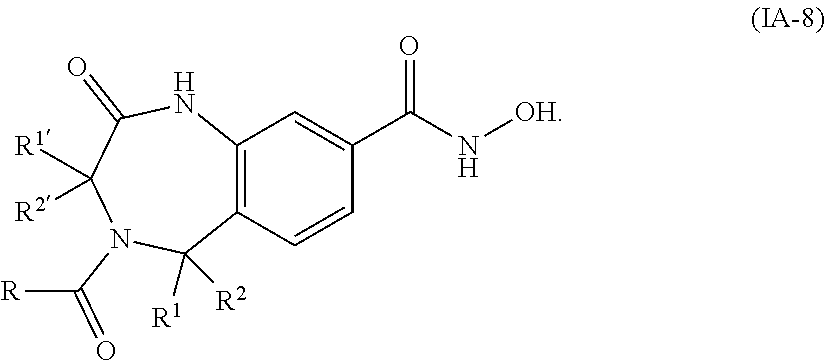
C00014

C00015

C00016
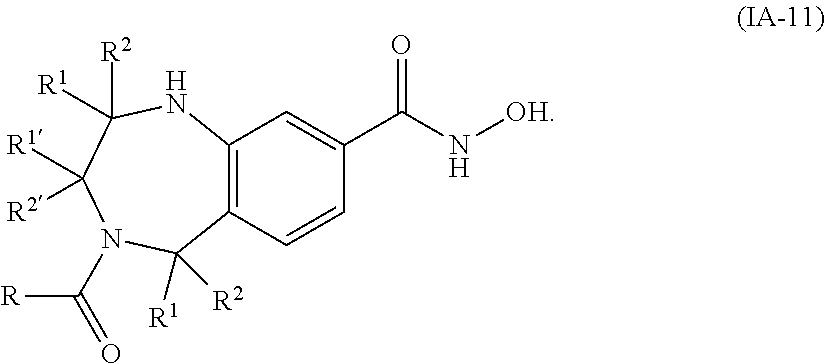
C00017

C00018

C00019

C00020
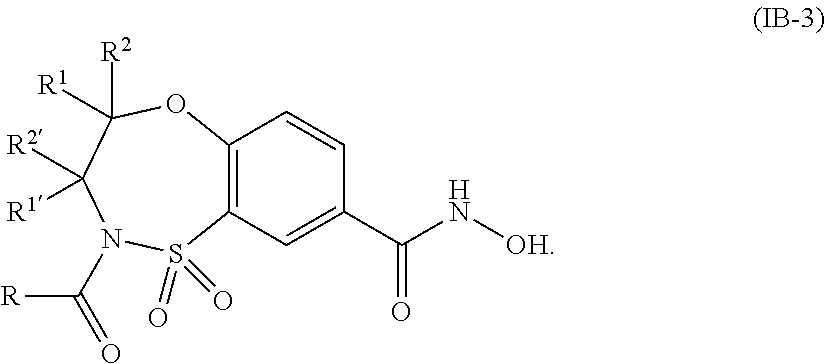
C00021
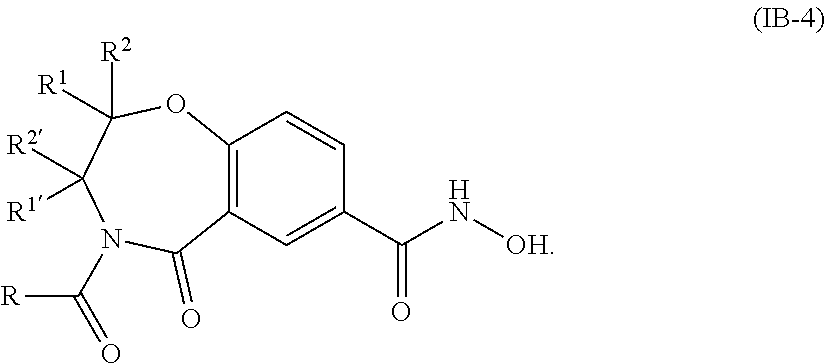
C00022

C00023

C00024

C00025
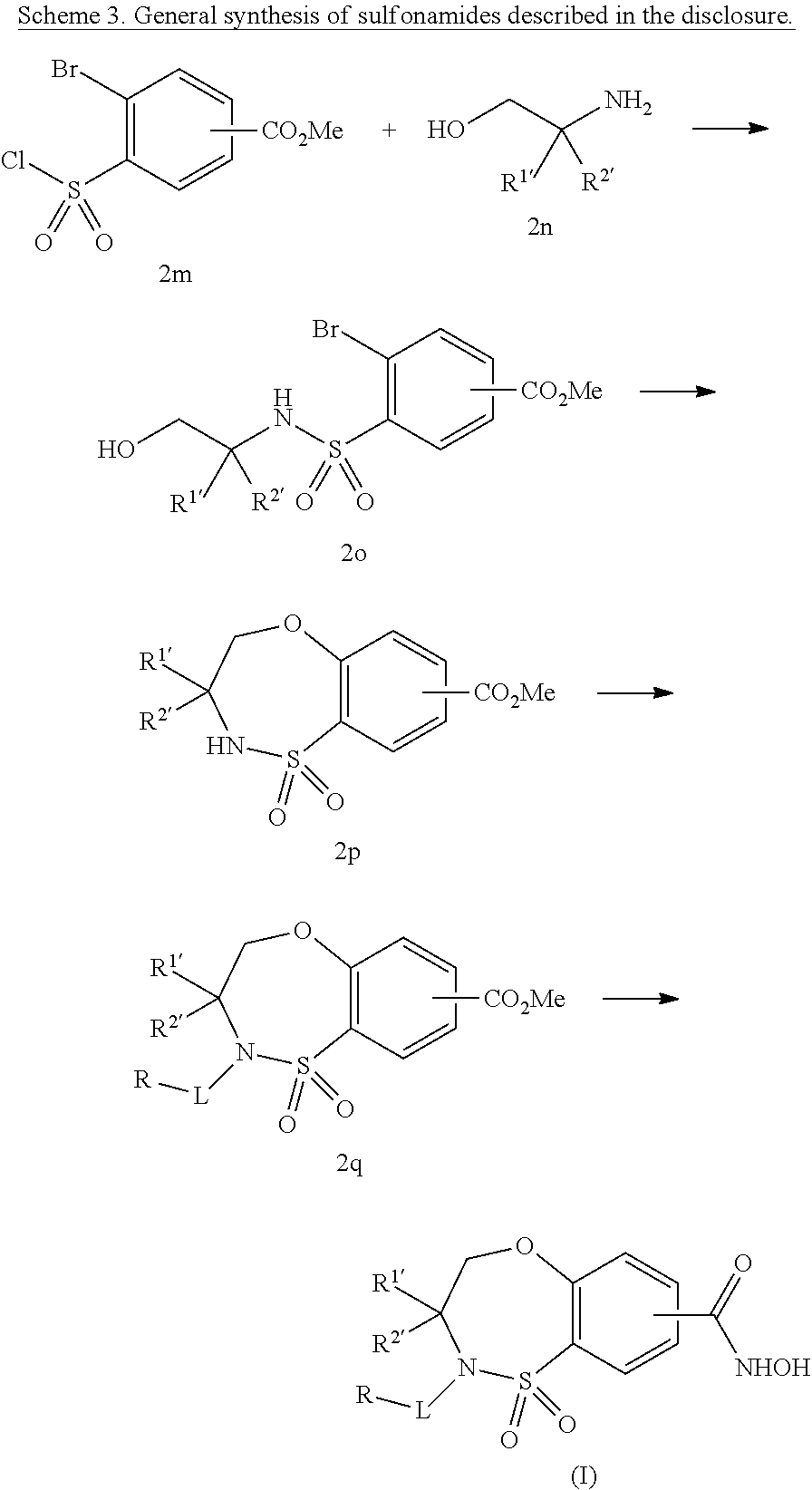
C00026
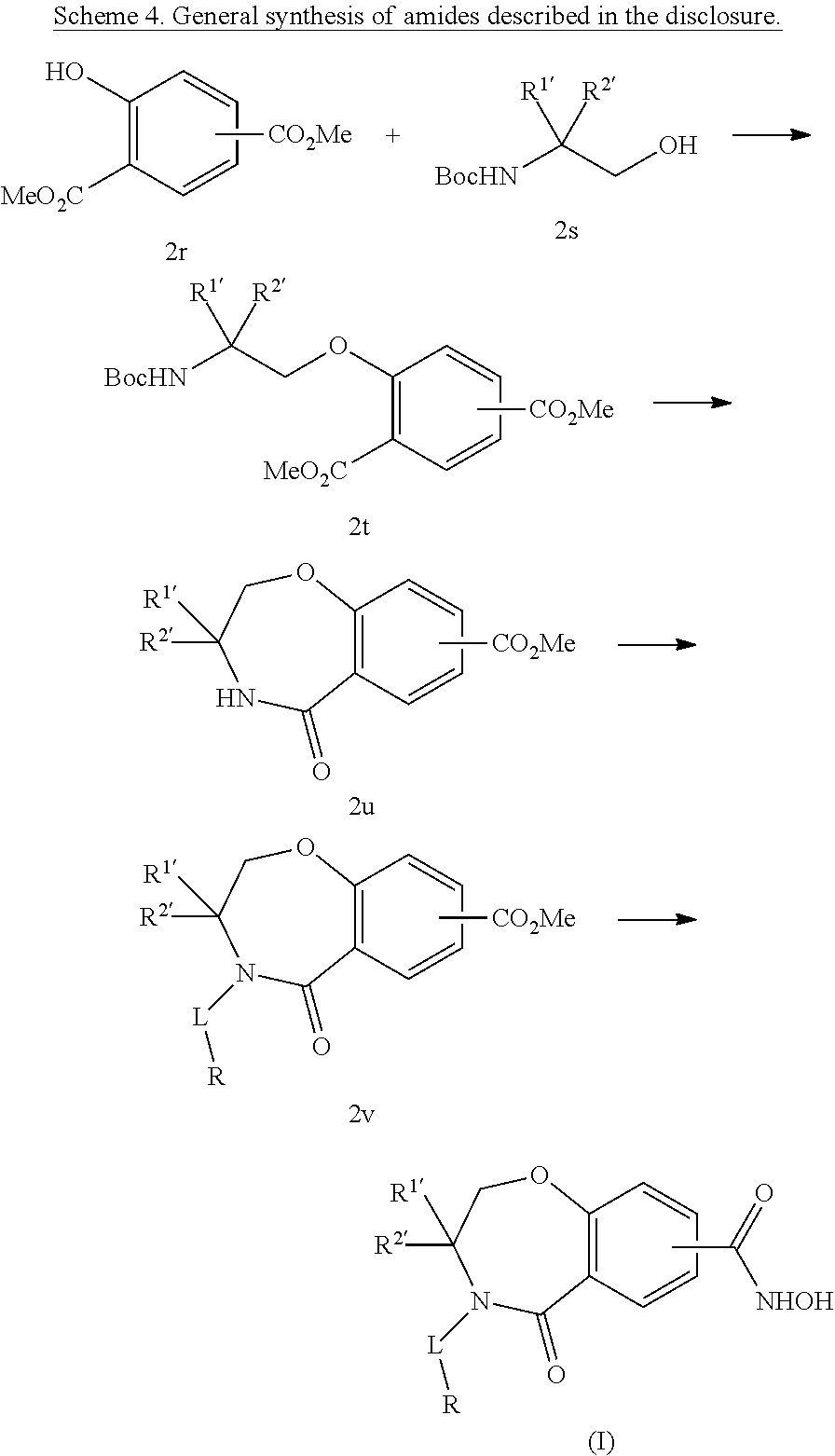
C00027
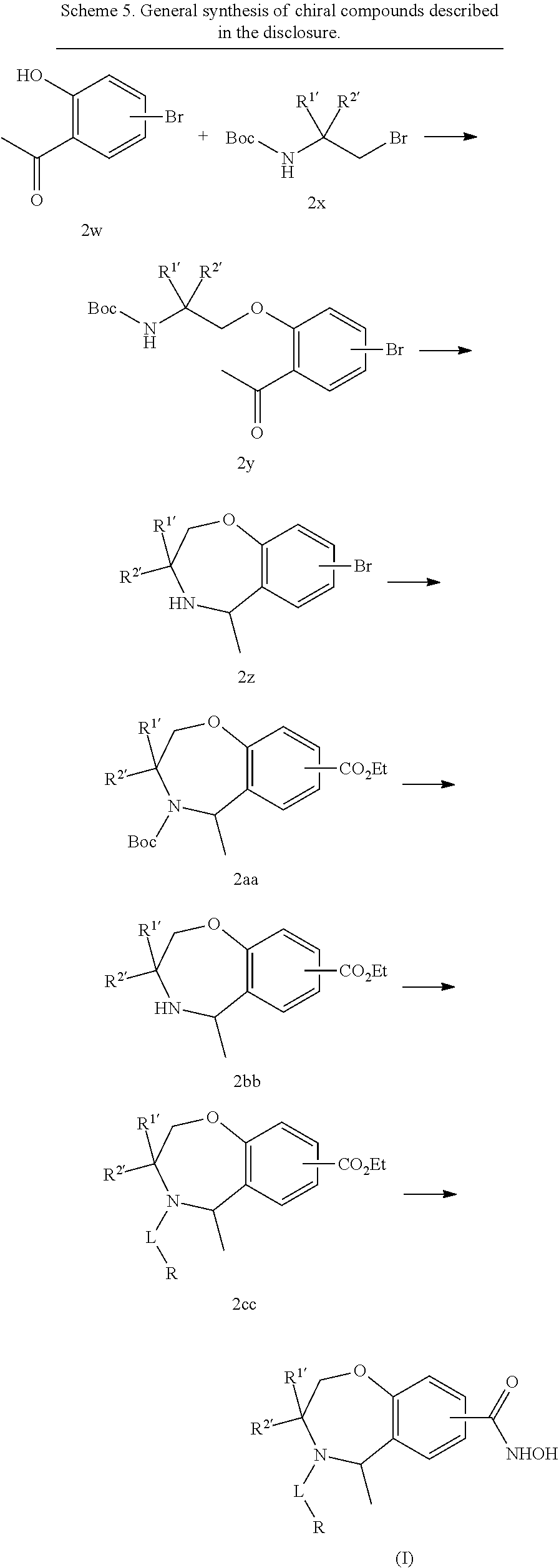
C00028

C00029

C00030

C00031

C00032

C00033
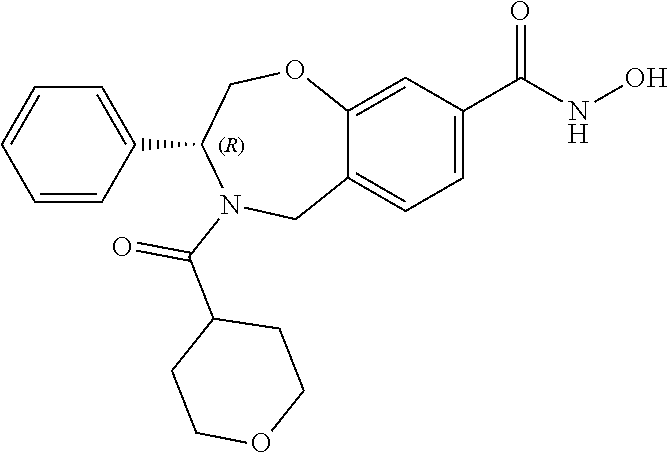
C00034

C00035
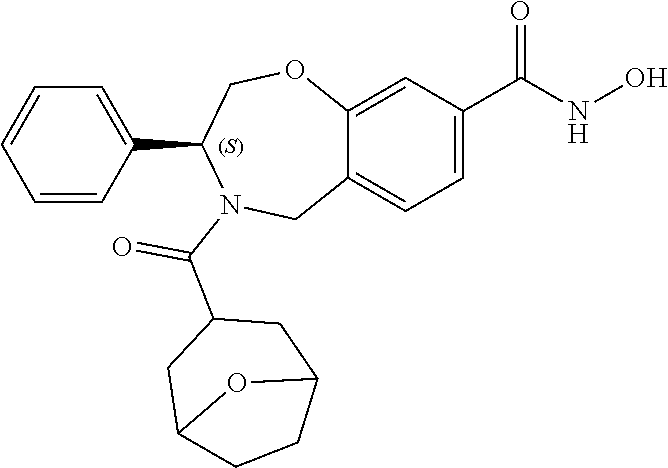
C00036
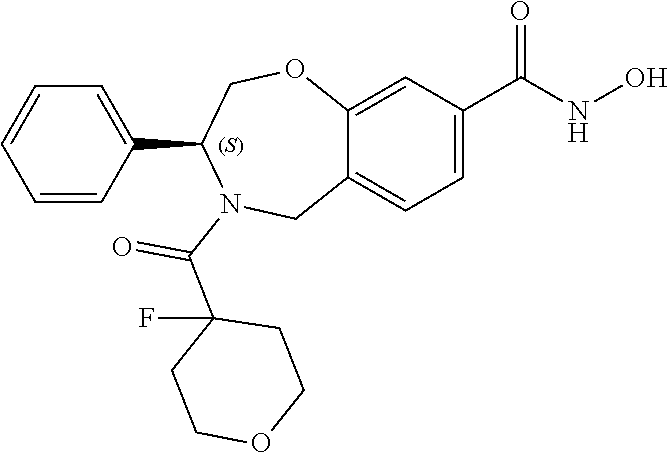
C00037

C00038

C00039
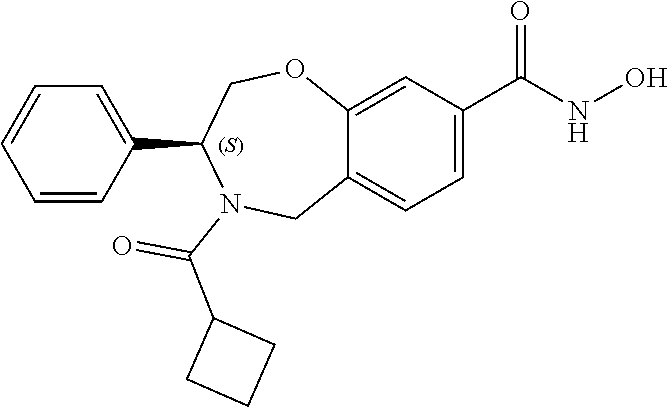
C00040

C00041
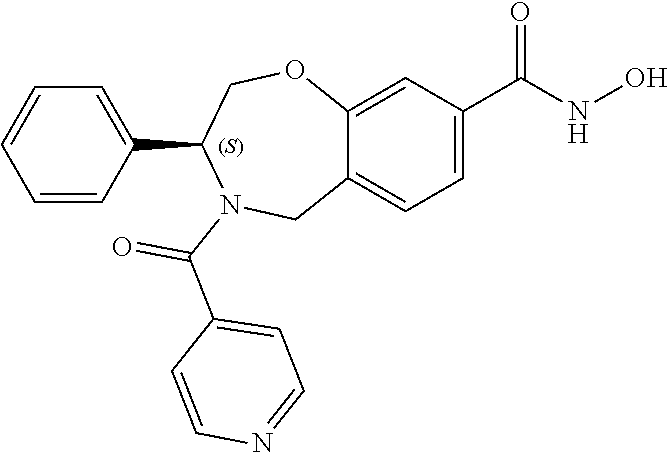
C00042

C00043

C00044

C00045

C00046

C00047
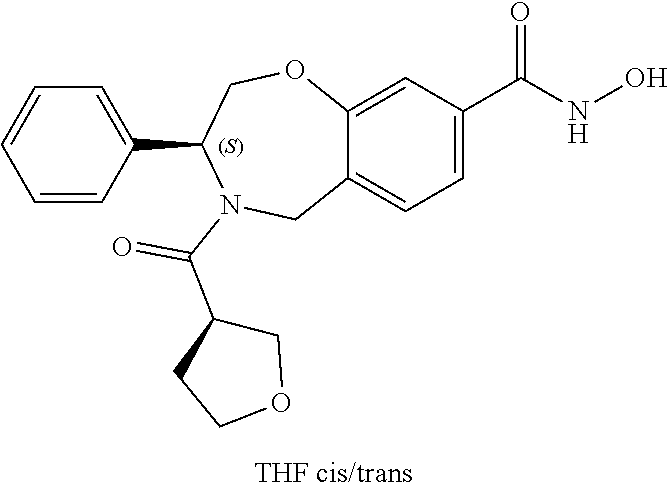
C00048
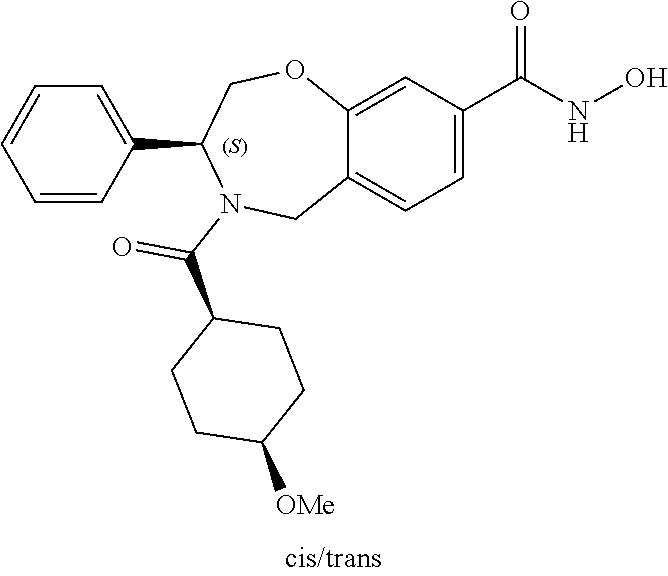
C00049
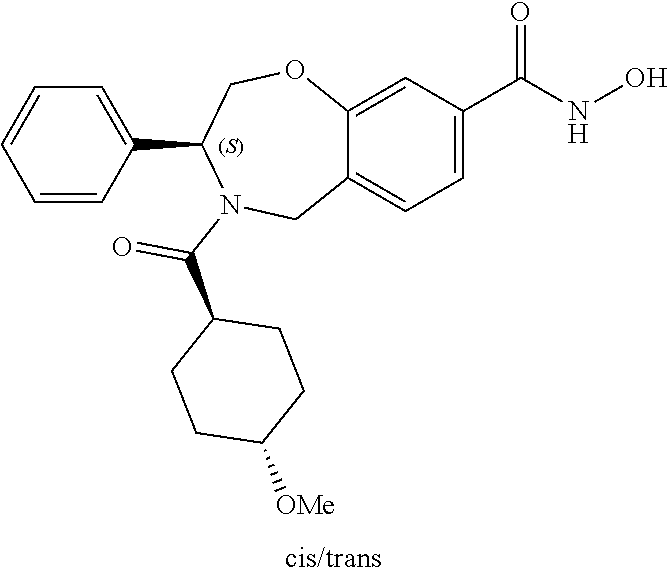
C00050
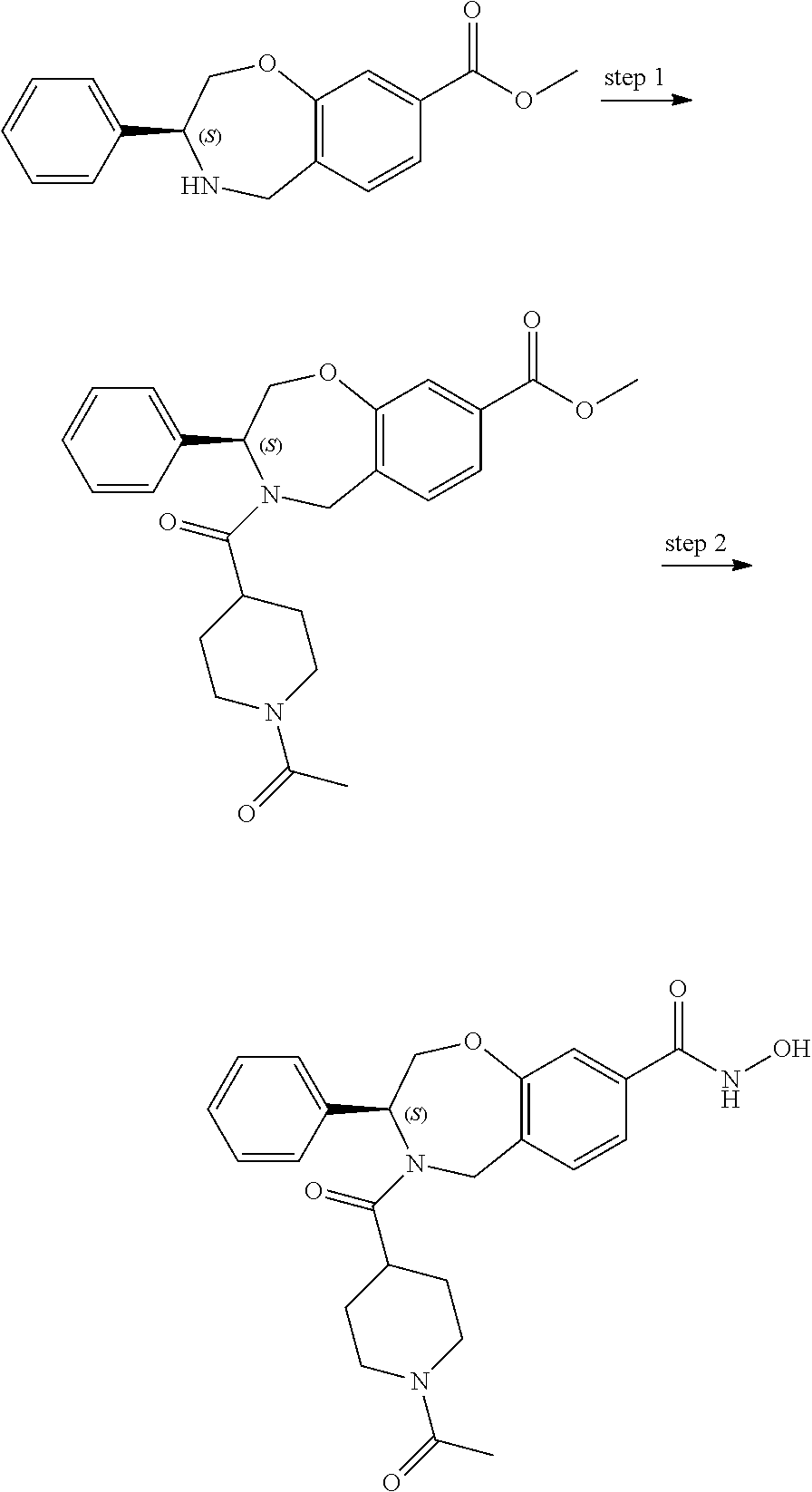
C00051

C00052
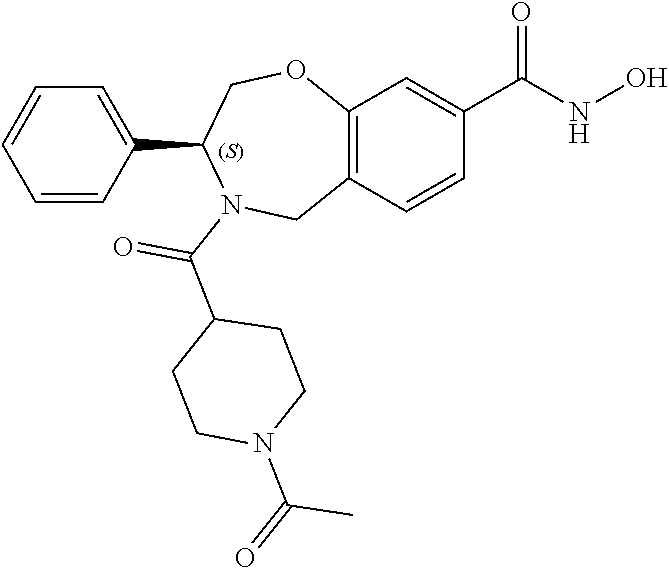
C00053
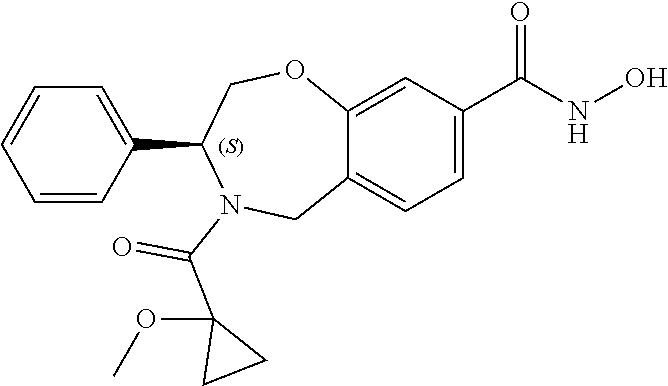
C00054
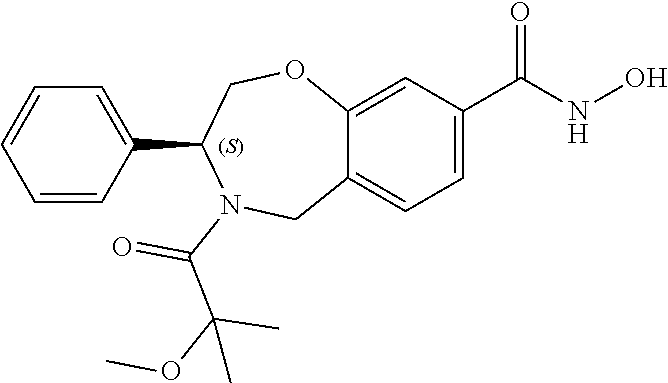
C00055

C00056
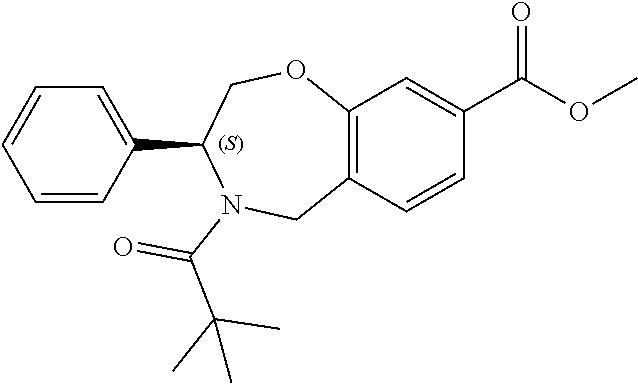
C00057

C00058
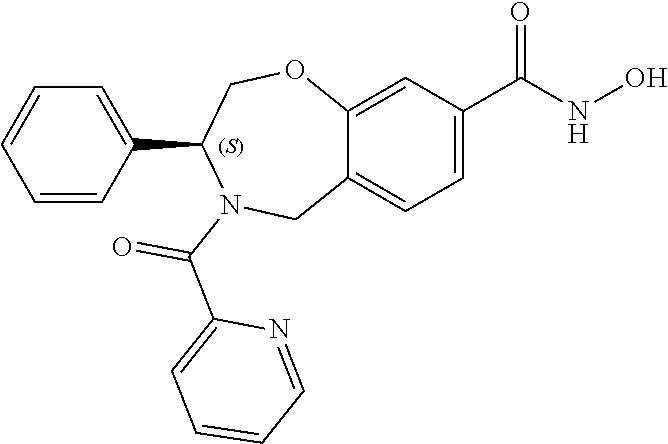
C00059

C00060

C00061
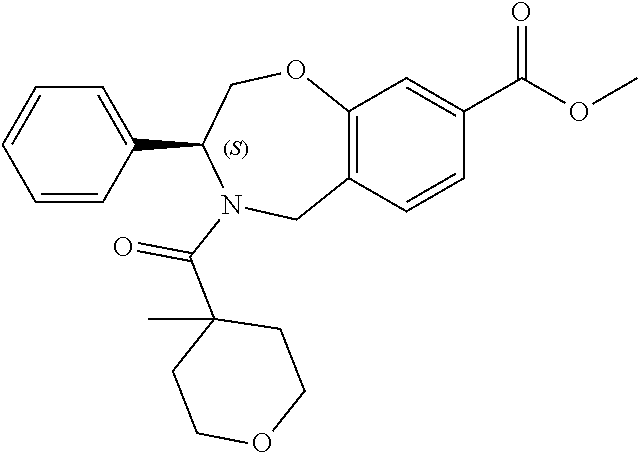
C00062

C00063

C00064

C00065

C00066

C00067

C00068

C00069
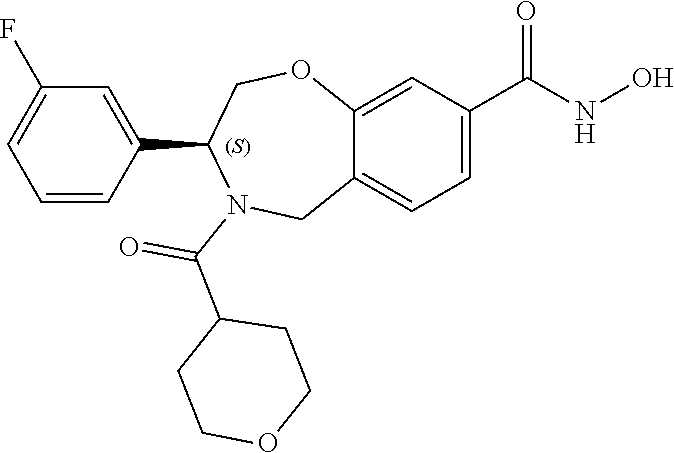
C00070
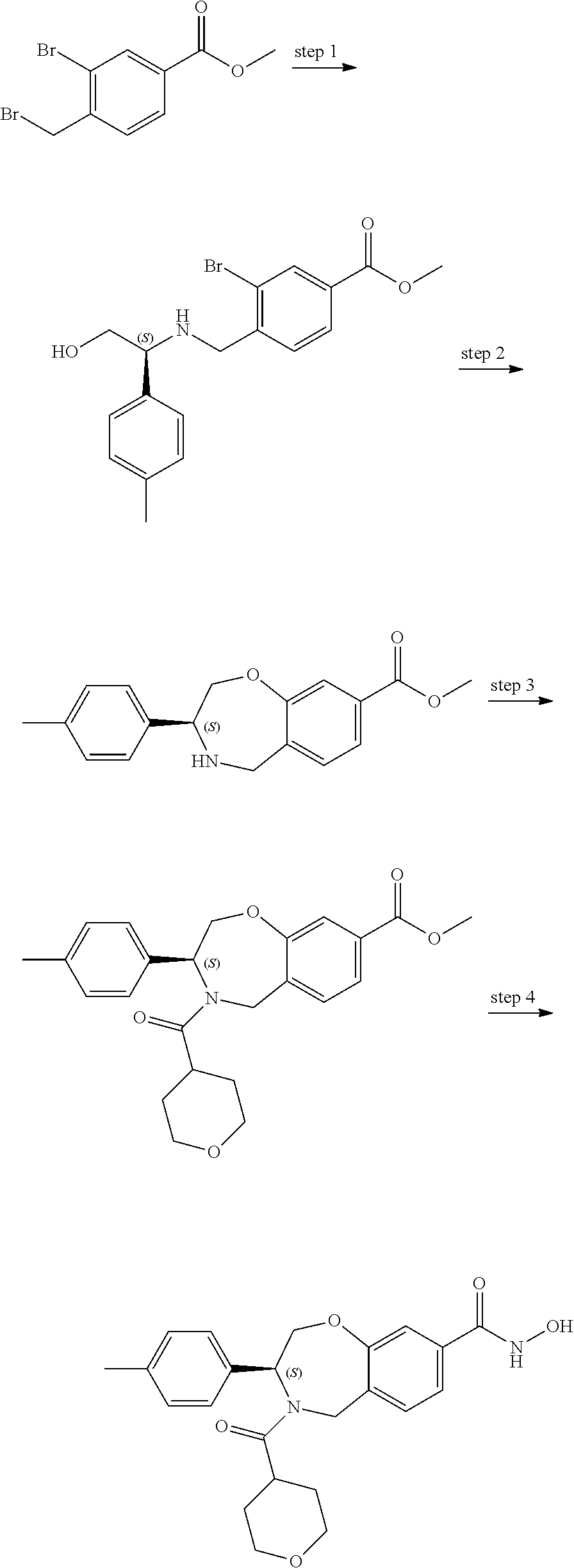
C00071

C00072

C00073
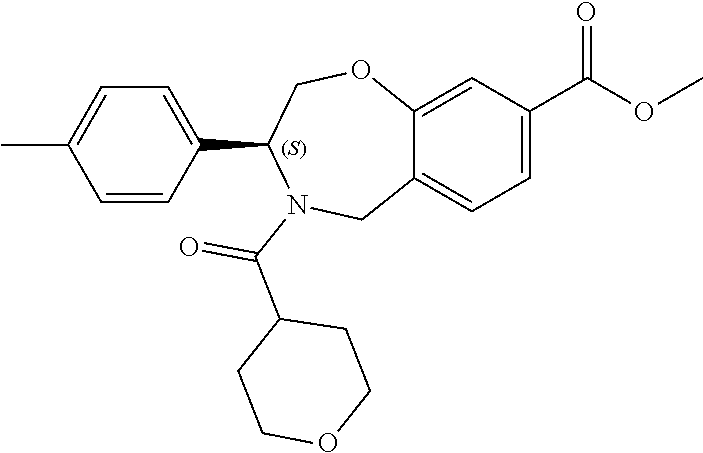
C00074

C00075

C00076

C00077

C00078

C00079

C00080
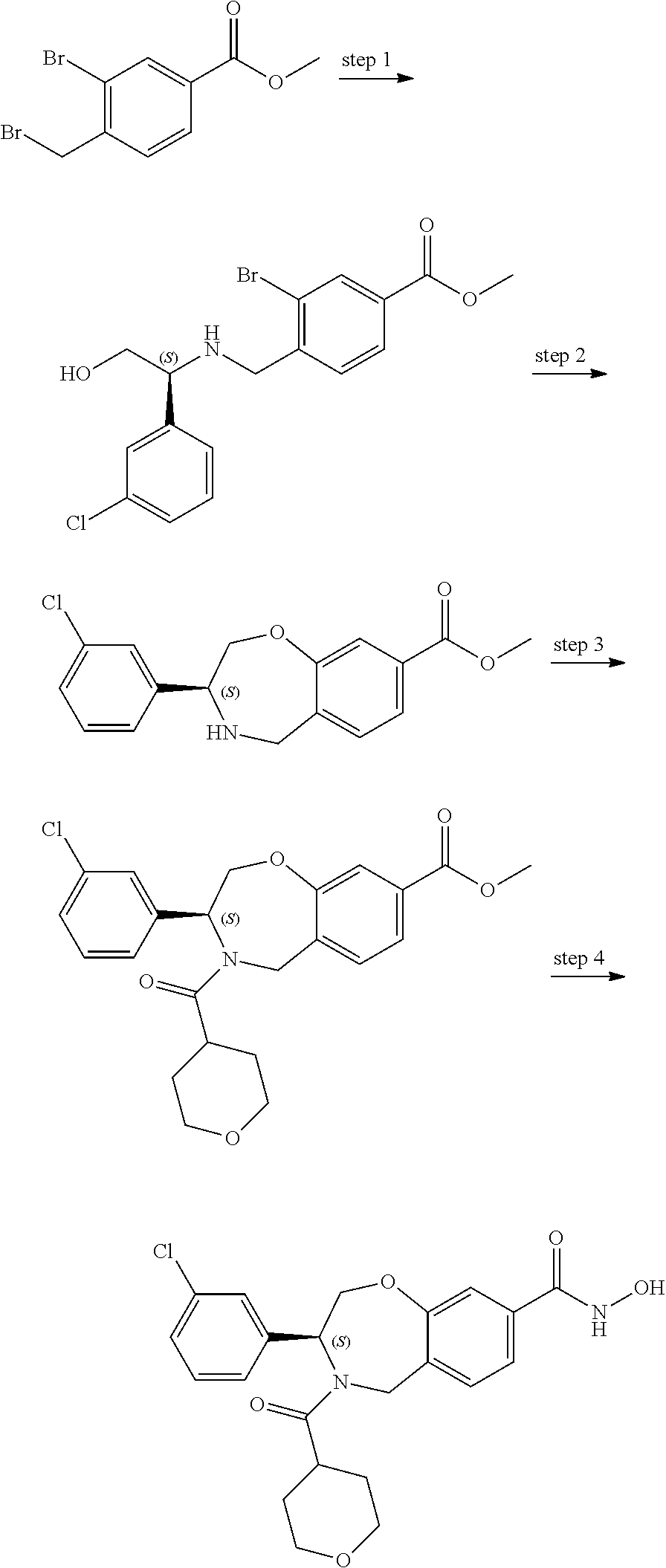
C00081

C00082
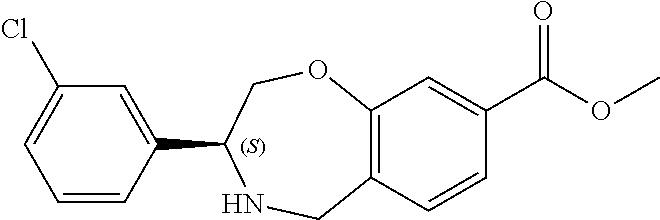
C00083
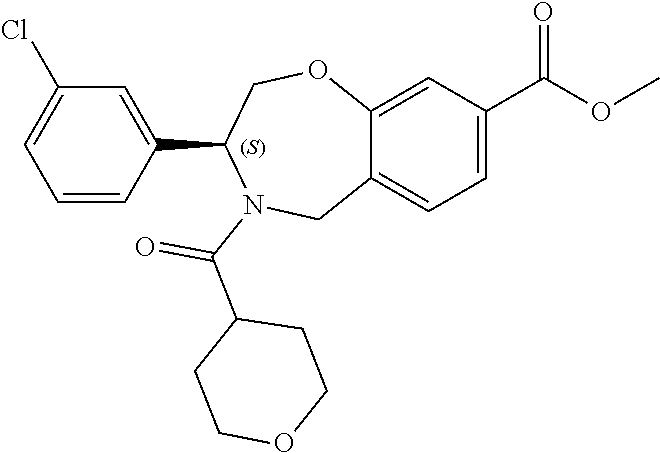
C00084

C00085

C00086
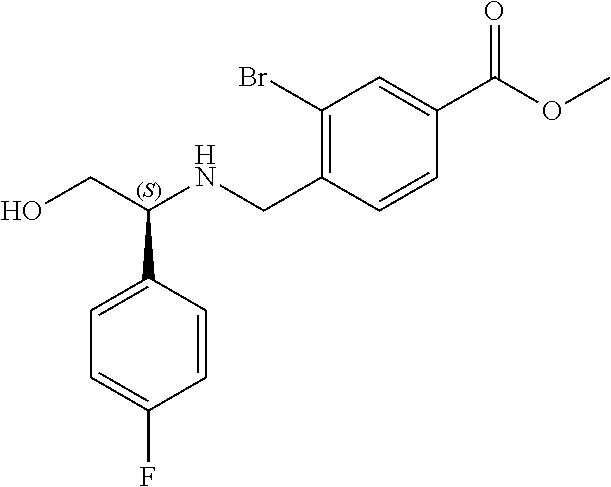
C00087

C00088
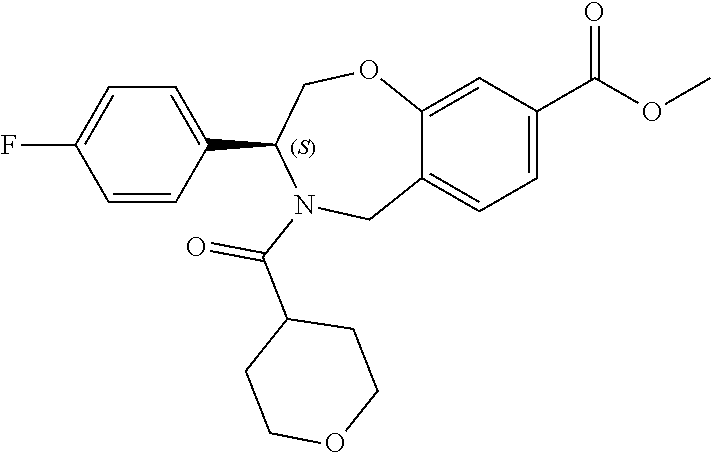
C00089

C00090
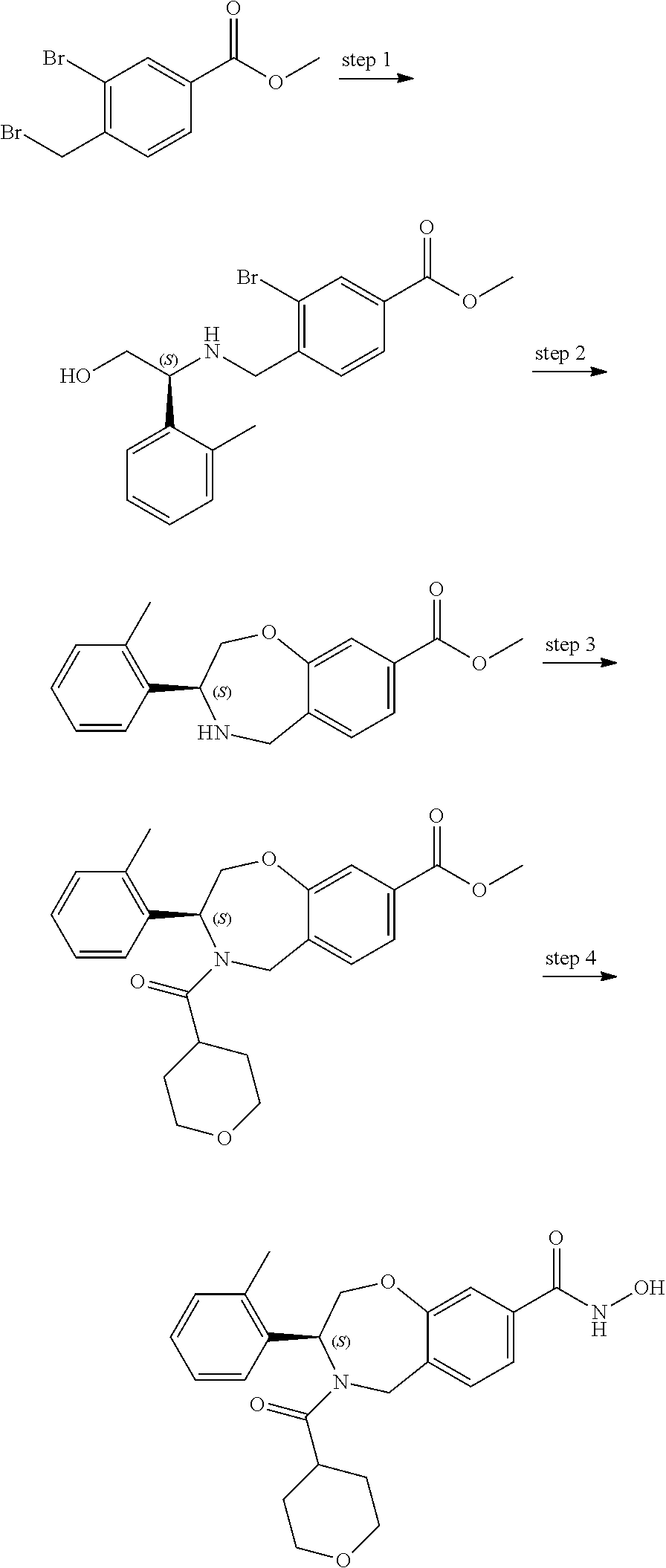
C00091
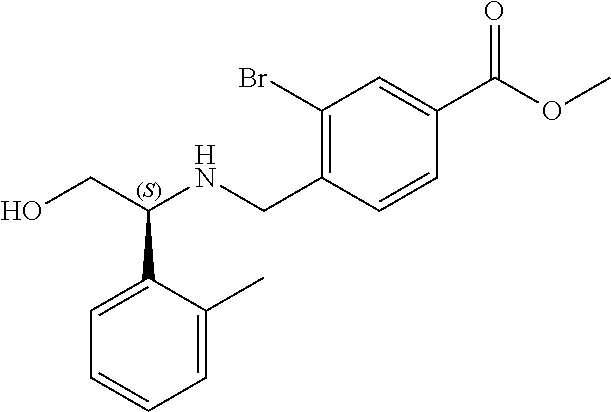
C00092
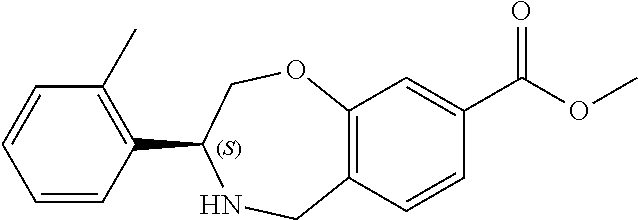
C00093

C00094

C00095

C00096
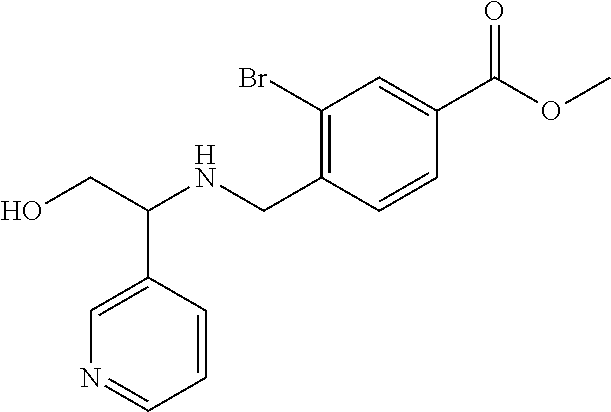
C00097

C00098

C00099
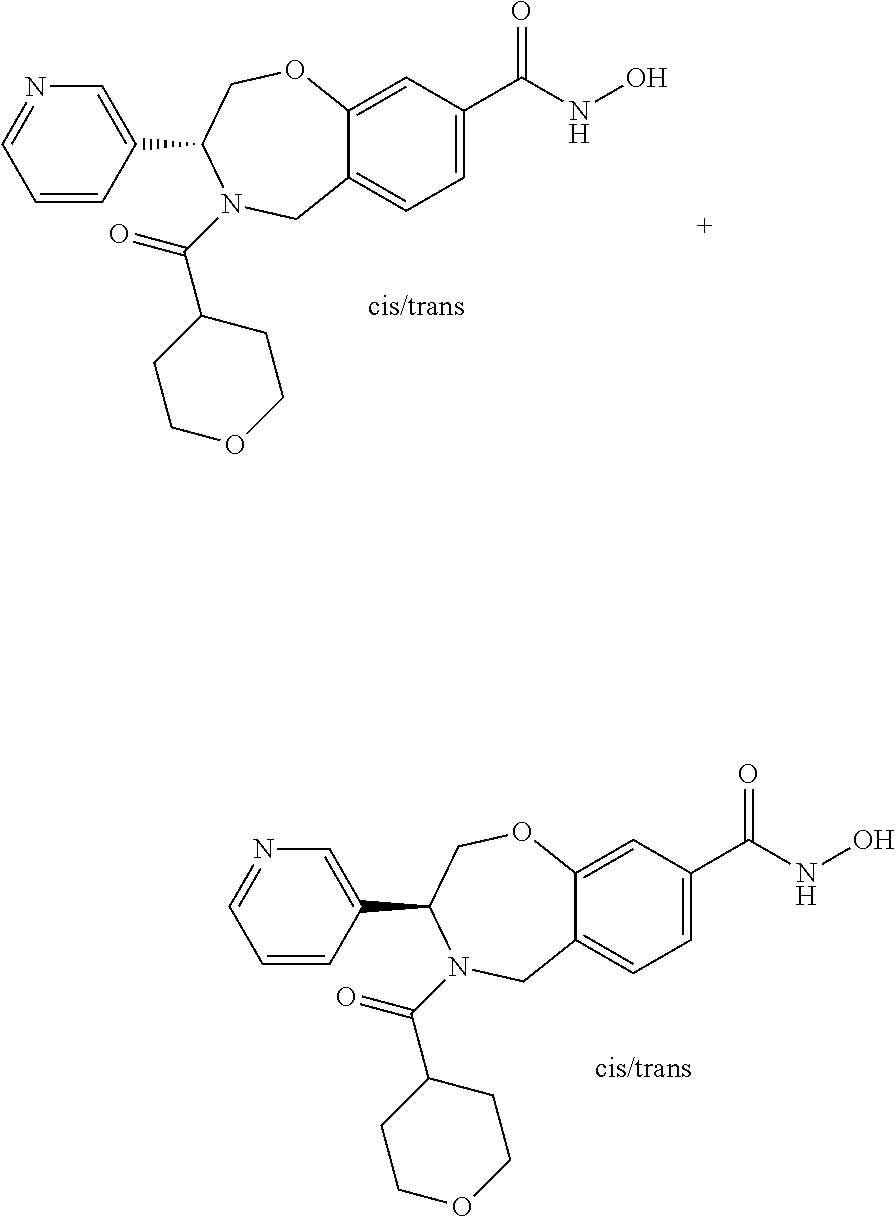
C00100
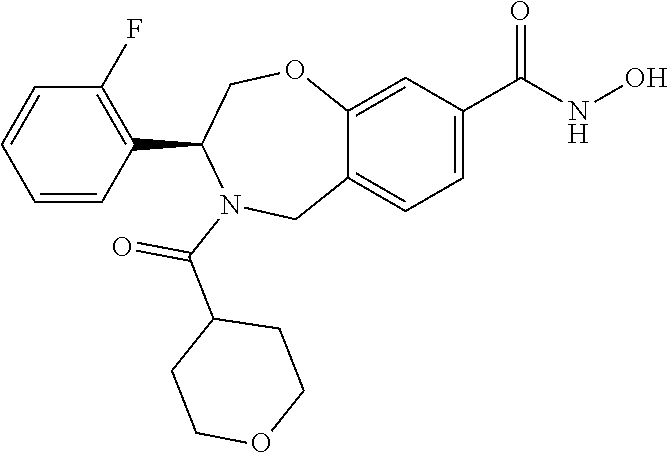
C00101
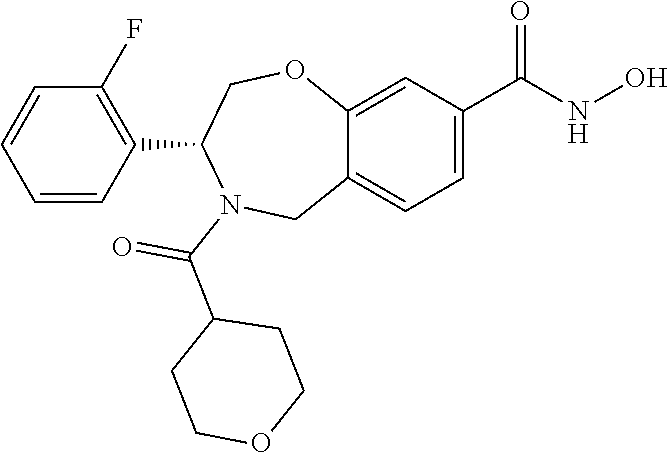
C00102

C00103

C00104

C00105
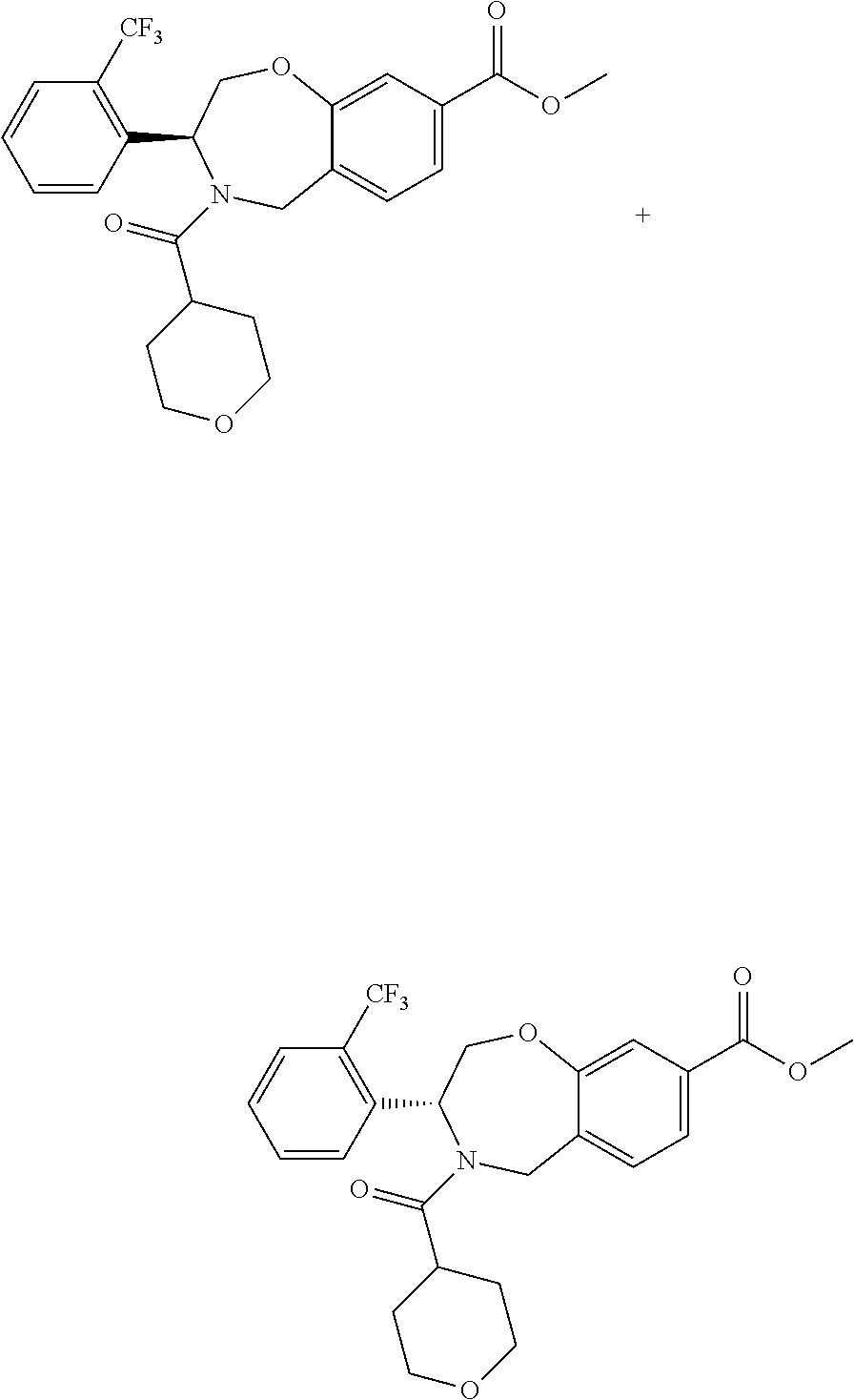
C00106

C00107

C00108
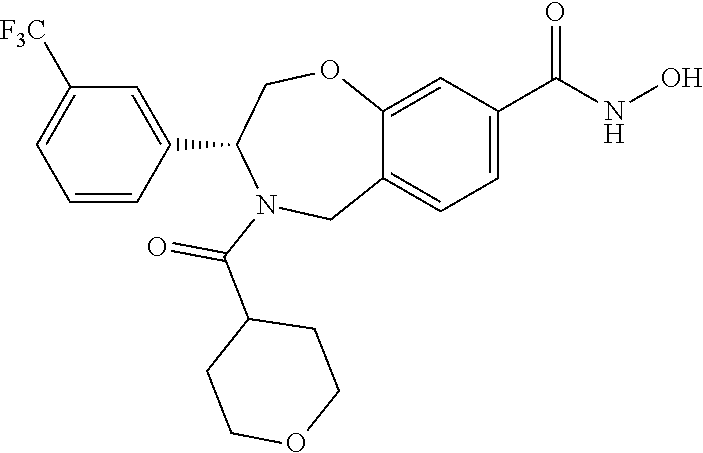
C00109

C00110

C00111

C00112

C00113
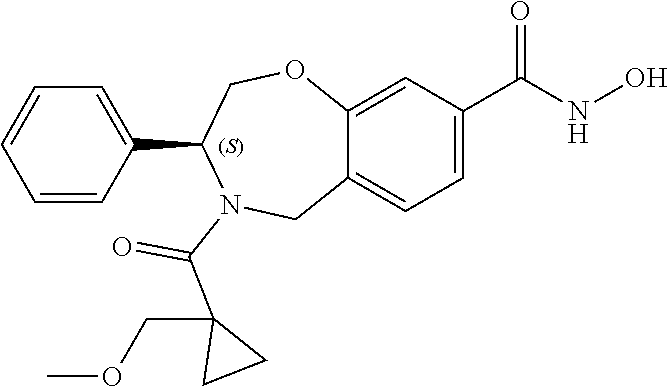
C00114

C00115

C00116
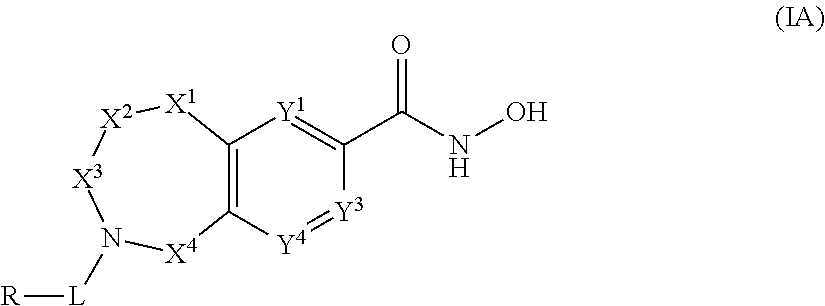
C00117

C00118

C00119
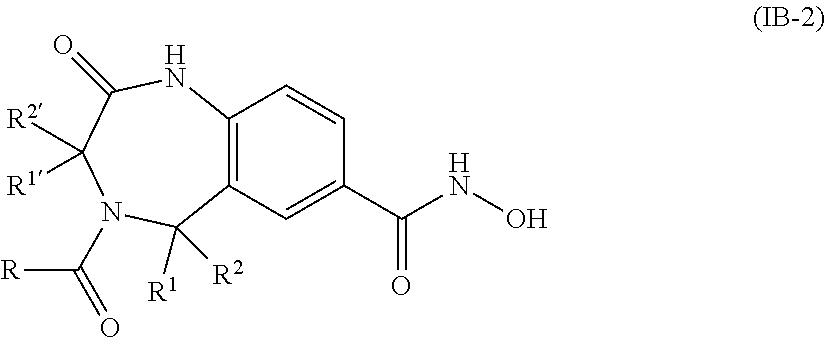
XML
uspto.report is an independent third-party trademark research tool that is not affiliated, endorsed, or sponsored by the United States Patent and Trademark Office (USPTO) or any other governmental organization. The information provided by uspto.report is based on publicly available data at the time of writing and is intended for informational purposes only.
While we strive to provide accurate and up-to-date information, we do not guarantee the accuracy, completeness, reliability, or suitability of the information displayed on this site. The use of this site is at your own risk. Any reliance you place on such information is therefore strictly at your own risk.
All official trademark data, including owner information, should be verified by visiting the official USPTO website at www.uspto.gov. This site is not intended to replace professional legal advice and should not be used as a substitute for consulting with a legal professional who is knowledgeable about trademark law.